I’ve been living in Singapore for over a decade. I moved here by myself at the start of my working career, and have since made Singapore my permanent home by taking up citizenship here. That’s over a decade of calling Singapore my home.
So I’d like to think that I know a lot about this beautiful city-state that I love so much. And I’d like to share my recommendations with you!
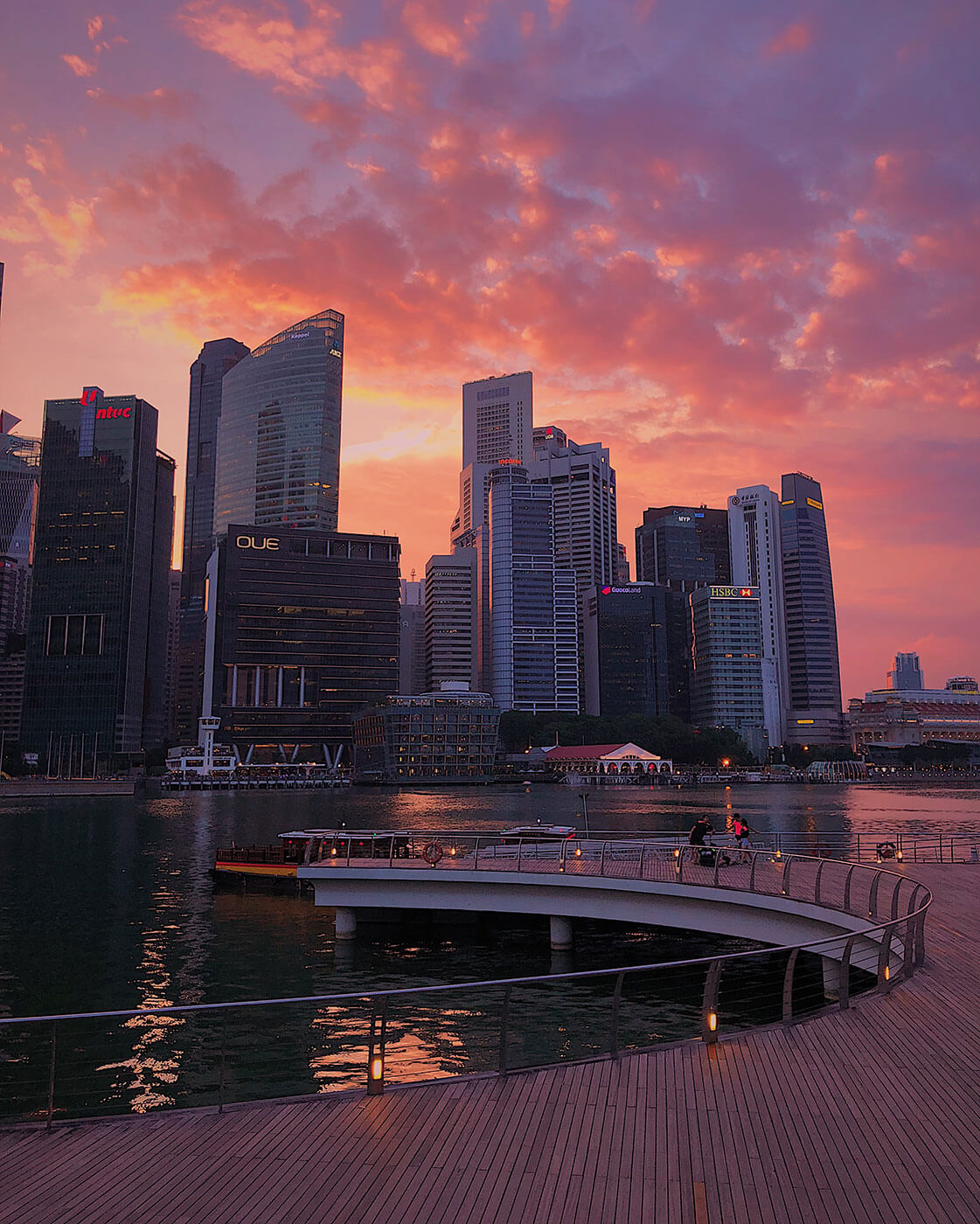
- Planning your trip to Singapore
- Singapore itinerary, what to do and where to go
Travel tips for first-time visitors to Singapore
Singapore is generally a very tourist-friendly place and efficient to visit. But here are a few tips that make your visit here even easier!
1. Buy tickets online via Klook – If you are going to a place that requires a ticket, they will usually be available online via Klook. As an avid Klook user, I highly recommend them. More often than not, you will be able to get a cheaper ticket by booking through Klook. They also give you credits to offset your future purchases on Klook. Lastly, they have a large presence in Singapore, and as a result, you can guarantee that the experience of using Klook has been tried and tested in Singapore.
What is Klook? Klook is the leading travel and experiences booking website in Asia. And yes, they are legit! I personally always book my activities through them whenever I am traveling. See my review of Klook here.
2. Get around using our amazing public transportation – Having visited many countries with extensive public transportation system, I gotta say – Singapore’s is still the best to me. It’s affordable, safe, clean, very frequent, and generally reliable. Service disruption is not normal – when there is a service disruption, it makes national news headlines because it’s rate. PS: I’ll elaborate more about taking public transportation in the “Getting around Singapore” section below.
3. Get a data eSIM for your phone – This is a must for every destination, and even more so while you’re in Singapore, as we are a tech-driven nation. Having data on your phone will allow you to easily look up directions, book taxis, and communicate on the go.
Get an eSIM: If you have an eSIM compatible device, I highly recommend getting an eSIM from Starhub, Singtel or M1. You can keep your original SIM card so you don’t have to keep switching SIM cards around.
Otherwise, there are three major telco providers in Singapore, and you can purchase the SIM for pick up in the city or at the airport: Singtel, StarHub, and M1 (eSIM available for some plans). They’re all priced the same and all are generally good in terms of reliability. I personally use StarHub for my mobile phone.
In a pinch, you can make use of Wireless@SGx hotspots available in many places in Singapore. It’s a free wifi hotspot that anyone can use. Learn more about setting up Wireless@SGx here.
4. You don’t need much cash – Singapore is a very digital-driven society, and as a result, we’ve pretty much gone cashless in most restaurants and shops. Contactless payments are ubiquitous in Singapore, which means you can pay with a credit card almost everywhere. However, you might still need cash if you plan to visit hawker centers or smaller restaurants, so, prepare some cash in small denominations ($2, $5, and $10) if you plan to visit them.
Tip: If you are worried about foreign exchange fees, try using travel cards like Wise debit card. They work well in Singapore!
5. Be prepared for hot weather – While locals have mastered the art of staying indoors during the day, many touristy things you’d want to see are outdoors. So make sure you always have a bottle of water with you, wear sun covering and appropriate clothes. I’ll elaborate more about the weather in Singapore below and how to deal with it.
6. Download the Singapore Google Maps to your phone – by this, I don’t just mean download the Google Maps app. You can download the whole Singapore map to your phone so you’ll use less mobile data when browsing the maps! Here is how to download Maps to your phone.
7. Immigration Arrival Card – The arrival card in Singapore is completely digital. Please make sure you’ve filled out the electronic Arrival card (available at least 72 hours before arrival) to make your immigration procedures even faster.
8. Singapore with kids – If you’re traveling with the little ones, you’ll want to check out my guide on what to do in Singapore with kids, as well as travel tips specifically for kids.
9. Watch out for the Chinese New Year (CNY) period – Out of all the holidays in Singapore, the one you should think about is the CNY. Even though the CNY celebration only spans two days, it slows the whole country down. Many traditional restaurants and food stalls may not be open during CNY, and some might even be taking extended leave that spans over a week around the holiday period. For example in 2024, the official CNY Public Holiday is only from 9 to 12 February but many stalls would close from 9 to 14 February.
10. Tax refund for visitors – If you plan to make a purchase in Singapore over S$100 in value, you might be eligible to get a refund on the GST (Goods & Service Tax), which is quite substantial at 9%. Not all stores participate in the tax refund scheme, so you’ll need to look out for a “tax-free” logo. Find out more about the Tax refund scheme here.
11. Account for ++ when dining in a restaurant – While the price of most retail goods in Singapore already includes tax, it’s a different story for dining in a sit-down restaurants. Most of the time, the price indicated are not inclusive of GST and service charge. If it does have ++, it means you will be charged 9% for GST and 10% for service charge. But again, this only applies to sit-down restaurants where the food will be served to you. It does not apply to hawker centers or fast food type of places.
12. Which brings me to my next point: Should you leave a tip in Singapore? NO, you should not. Tipping is neither expected nor encouraged. Even if you leave a tip, it may not be distributed to your waiter or the staff as you might have expected, because of how uncommon it is. So please just make it easier on everyone and don’t try to leave a tip.
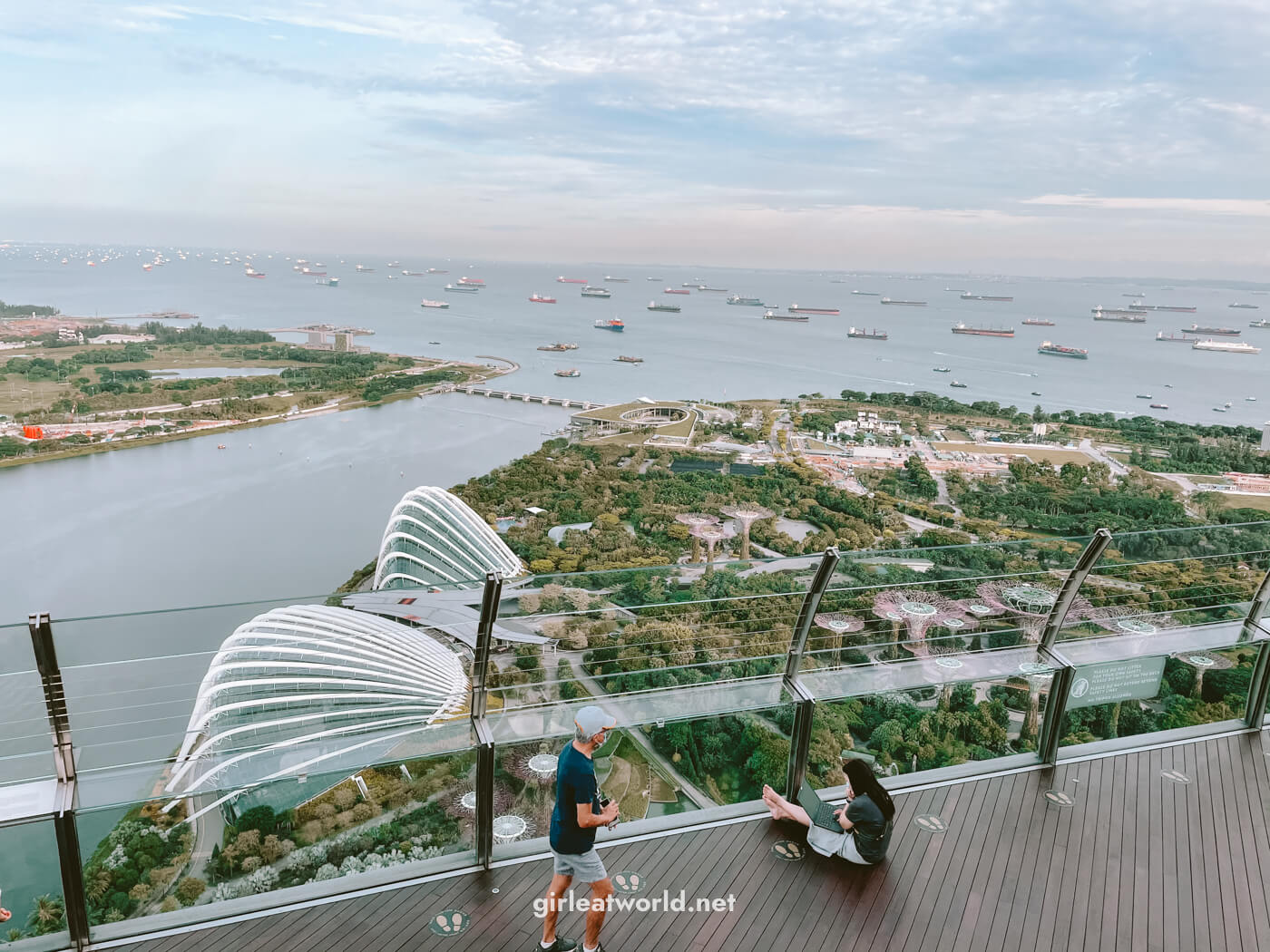
Weather in Singapore and what to bring
Singapore is located just one degree north of the equator. That means it’s very hot and humid here all year long. Expect a temperature of 30-34C during the day with a humidity level of 80-90%. And, sometimes it rains too.
Tips for dealing with the hot and humid weather
There are certain items that could help you cope with Singapore’s hot and humid weather. Consider having the following with you:
- Sunscreen / hats / other sun covering – The UV index gets really high here, so you’ll want to make sure to protect yourself from getting sunburnt. If you want to buy sunscreen in Singapore, I recommend getting a Japanese face sunscreen with SPF50+ that is not oily and easy to apply (my favorite brand is Biore).
- Portable Electric Fan – when it’s breezy in Singapore, the heat is actually bearable. But when there is no breeze, that’s when it gets really difficult and uncomfortable. Bring one of these for yourself! If you want to get it in Singapore, the local favorite brand is Jisulife.
- A bottle of water – you know what to do when you’re sweating a lot in hot weather… you hydrate, a lot. So bring a reusable water bottle! There are lots of water fountains in Singapore for you to refill your bottle. And, Singapore tap water is safe to consume. I prefer getting an insulated, so that I can fill it with iced water and it will stay cold throughout the day.
- Airy clothes – Again, it’s really hot and humid here so you’ll want to wear light and thin clothing. Think cotton T-shirt with shorts and sandals, or linen material. If you don’t have a suitable outfit, I recommend dropping by a Uniqlo store and checking out their Airism line, which specializes in clothing for hot and humid climates like that in Singapore.
- An umbrella – A small foldable one will do. It rains frequently in Singapore, though usually only for a few hours each day. Even if it doesn’t rain, you can still use the umbrella as extra sun cover.
Tips for the rainy season 🌧️
Being smack dab in the middle of the tropics means that we also have to deal with tropical rain. However, rain is not seen as a deterrent in Singapore – it’s welcomed, as it helps bring the temperature down a little.
Passing rain – Unless its the peak monsoon season, rain doesn’t usually last all day. Occasionally, it does last for a while, but the city is built for such a climate – you’ll be able to find other things to do even in bad weather.
Download myENV app to monitor rain cloud – Singapore has what is called microclimate. This means, just because it is raining in some part of Singapore, it doesn’t mean the entire country will be affected. suggest downloading myENV – the official app maintained by NEA (National Environment Agency). It will let you monitor rain cloud, as well as other info like UV index, weather forecast, or even dengue areas. If you don’t want to download the app, you can use the NEA website. It also offers some weather forecasts, but as the weather is hard to predict it is not very accurate. Which brings me to the next point…
Don’t rely TOO much on weather forecast – Weather in the tropics could be quite erratic. If you’ve lived here for a while, you’ll start to see patterns in the weather, but it’s still hard to say when exactly the rain will come. Don’t bother planning for the weather more than 12 hours in advance – things could change at the very last hour. What you could do instead is look at myENV app and make your best educated guess given the data point in the app. As a friend jokingly said once, everyone in Singapore becomes a meteorologist once you get your hands on the myENV app 🤣
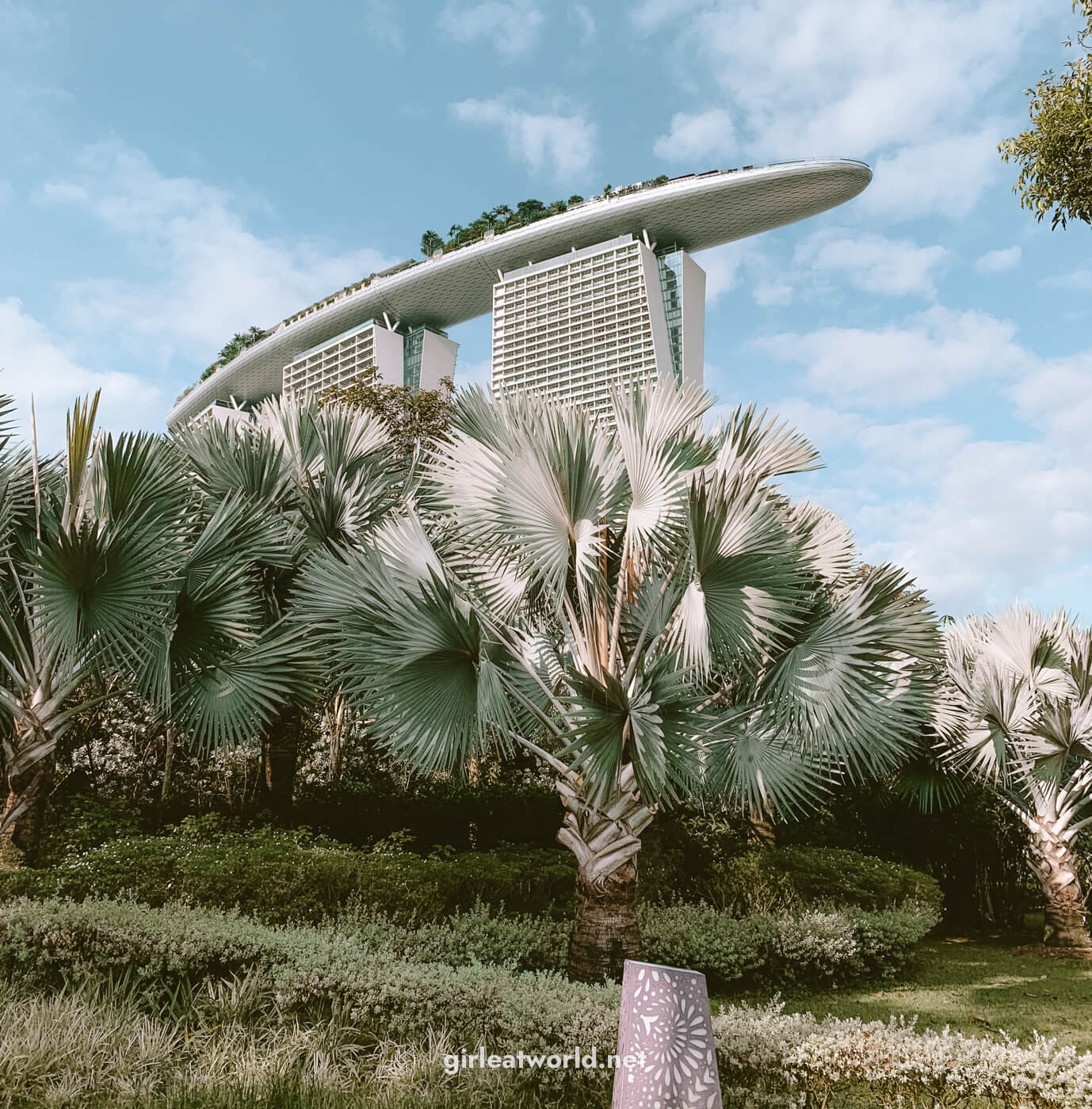
Getting to the city from the airport
Remember how I told you Singapore is highly efficient? Well, our airport is a great sneak peek of that efficiency. The immigration and taxi lines at Changi Airport usually move fast.
Immigration Arrival Card: The arrival card in Singapore is completely digital. Please make sure you’ve filled out the electronic Arrival card (available at least 72 hours before arrival) to make your immigration procedures even faster.
There are several ways to reach the city from the airport:
- By Taxi – Taxi lines are really easy to find at Changi Airport. There will also be people ushering and helping you get the taxi. The cost of getting a taxi to the city center varies depending on location and time of the day, but generally, it would be around SG$ 25-35.
- By Private Transfer – While taxi is easy to get from the airport, most of them are 4-seater taxis. If you’re traveling in a large group and have luggages, you might need to split into two taxi or wait for a large taxi to come by. This might not be ideal for some people, so I would suggest to pre-book your own private transfer via Klook.
- Ride-sharing apps – Grab and Gojek are the apps to use for this. Just make sure you’ve indicated the correct pickup spot so that your driver knows where to find you. In every terminal at Changi Airport, there is a dedicated pick up location and door number. Just like taxis, the cost also varies but stays within the SG$20-30 range.
- By Train / MRT – If you are arriving from Terminal 1,2 or 3, the Green (East-West) train lines will take you to the city in about 30 minutes. You can switch trains at the Expo station for the Blue (Downtown) line. If you are arriving at Terminal 4, you can take the shuttle to Terminal 1-3 and resume via train.
- By Bus – There are several buses available from the airport, but Bus 36 is likely going to be the one that takes you to the city.
If you decide to take the bus or train, please make sure you won’t be traveling during peak hours (8-10 am for the direction going into the city and 5-7 pm for the direction going away from the city). You might have difficulties carrying your luggage if you do.
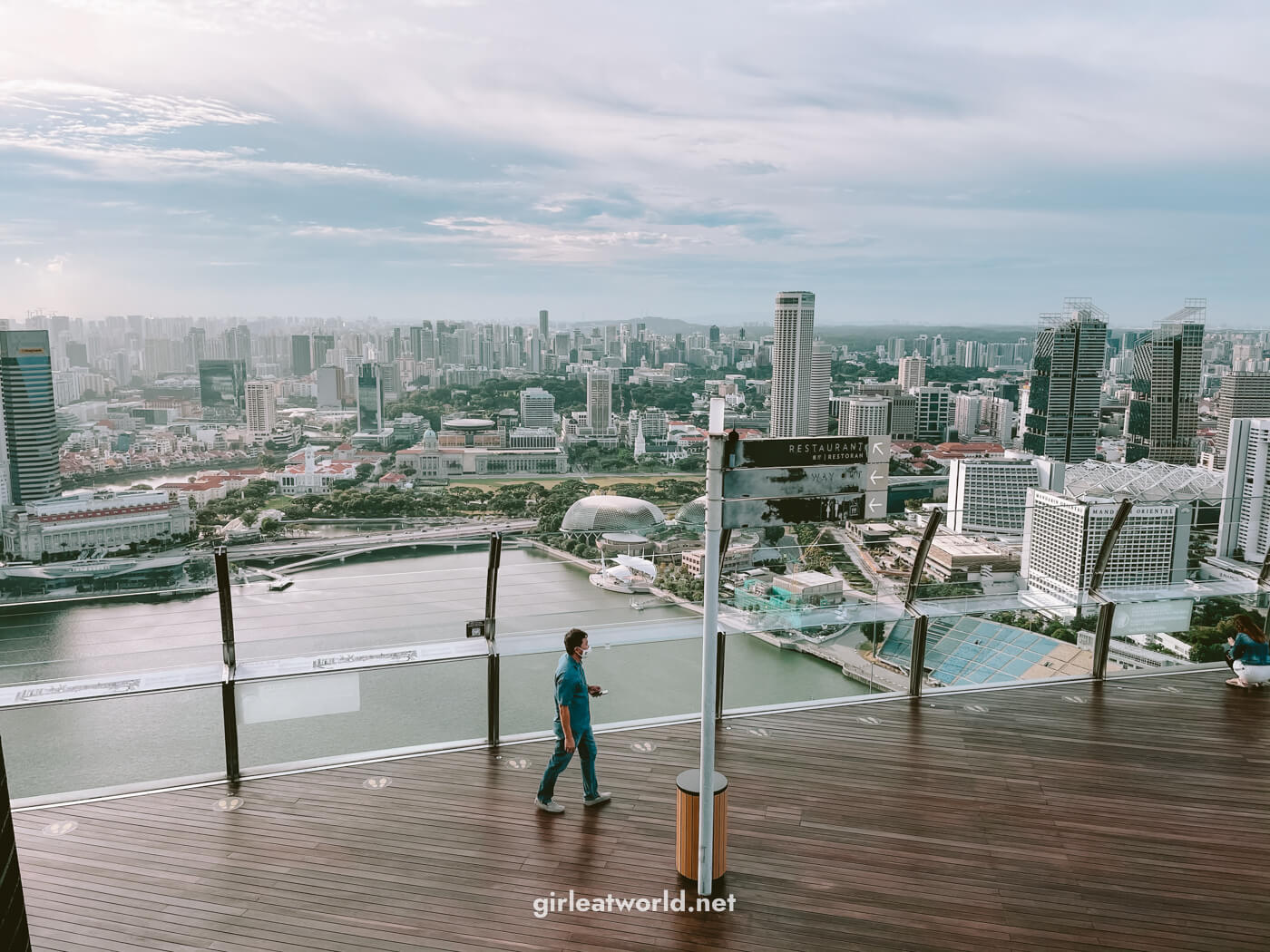
How to get around Singapore
Getting around in Singapore is, for lack of better words, easy peasy lemon squeezy 🍋😁. Here are a few options you can explore:
1. Public Transportation in Singapore
Without a doubt, taking public transportation is the BEST way to get around in Singapore. That’s how I get around everyday! It’s affordable, safe, clean, very frequent, and generally reliable.
The trains in Singapore are known to locals as MRT (Mass Rapid Transit). There are 6 MRT lines on the island:
- Red (North-South) or Green (East-West) are the two pioneer lines in Singapore, first operating in 1987
- Purple (North-East) is the third addition to the MRT lines, opened in 2003
- Yellow (Circle) and Blue (Downtown) lines are relatively newer, opened only in the past 10 years after I moved here
- Brown (Thomson East Coast Line) is our newest train line, newly opened in 2020!
Each of them has a name, but we usually just refer to them by their color. For example, we would refer to the North-South line as “the red line“.
Buying a Train / Bus Ticket
Accessing the MRT and bus in Singapore is easy. You don’t need to buy any physical ticket as long as you have a credit card that can support contactless payment. Ensure your credit card has been enabled for foreign transactions, and you can use your credit card to tap in and out of each MRT station or bus stop directly at the machine.
Use your smart device as a public transport ticket: You can even add your credit card to your smartphone or smartwatch (provided they have the ability to do contactless payment) and use those to go through the ticket gantry directly by just tapping your device.
How much does public transportation cost in Singapore?
Public Transportation in Singapore is affordable, ranging from SG$1.19 to SG$2.40 depending on the distance traveled. You do have to remember to tap out when you get off the bus so you will not be charged the maximum fare.
Transferring from one public transportation to another would not affect the fare. For example, if you take the train to get to Orchard Station and then take the bus elsewhere, you would only be charged S$1.09 for the train portion and S$0.21 for the bus portion.
If you are using a foreign credit card, there will be some fees charged for each posting of train charges. But they are very minimal, about 15 cents per posting (not per ride). Credit cards will only typically do daily posts or once the total amount reaches $5.
Last Service for Trains and Buses
The MRT and most buses are normally only operating up to midnight. There are a few night buses that operate after midnight, but it is not as frequent and doesn’t take you everywhere in Singapore.
MRT Extension time: On special occasions, such as during New Year’s after the fireworks or when Singapore is hosting the F1 Grand Prix, they might extend the operation hours to 1 AM.
2. Taxi and Ride Sharing in Singapore
Taking a taxi and ride-sharing car is also a good option to get around Singapore. They are not as cheap as our public transport, but still relatively cheaper than other metropolitan cities.
In Singapore, Grab and Gojek are the leading ride-sharing options. You can also download Zig by CDG, which is operated by Comfort Del Gro, the leading taxi operator in Singapore. Another alternative app would be TADA.
All of these apps will let you call a taxi or a private ride-sharing car. The fare is on-demand, which means it could get expensive if you’re calling a car from a high-demand place.
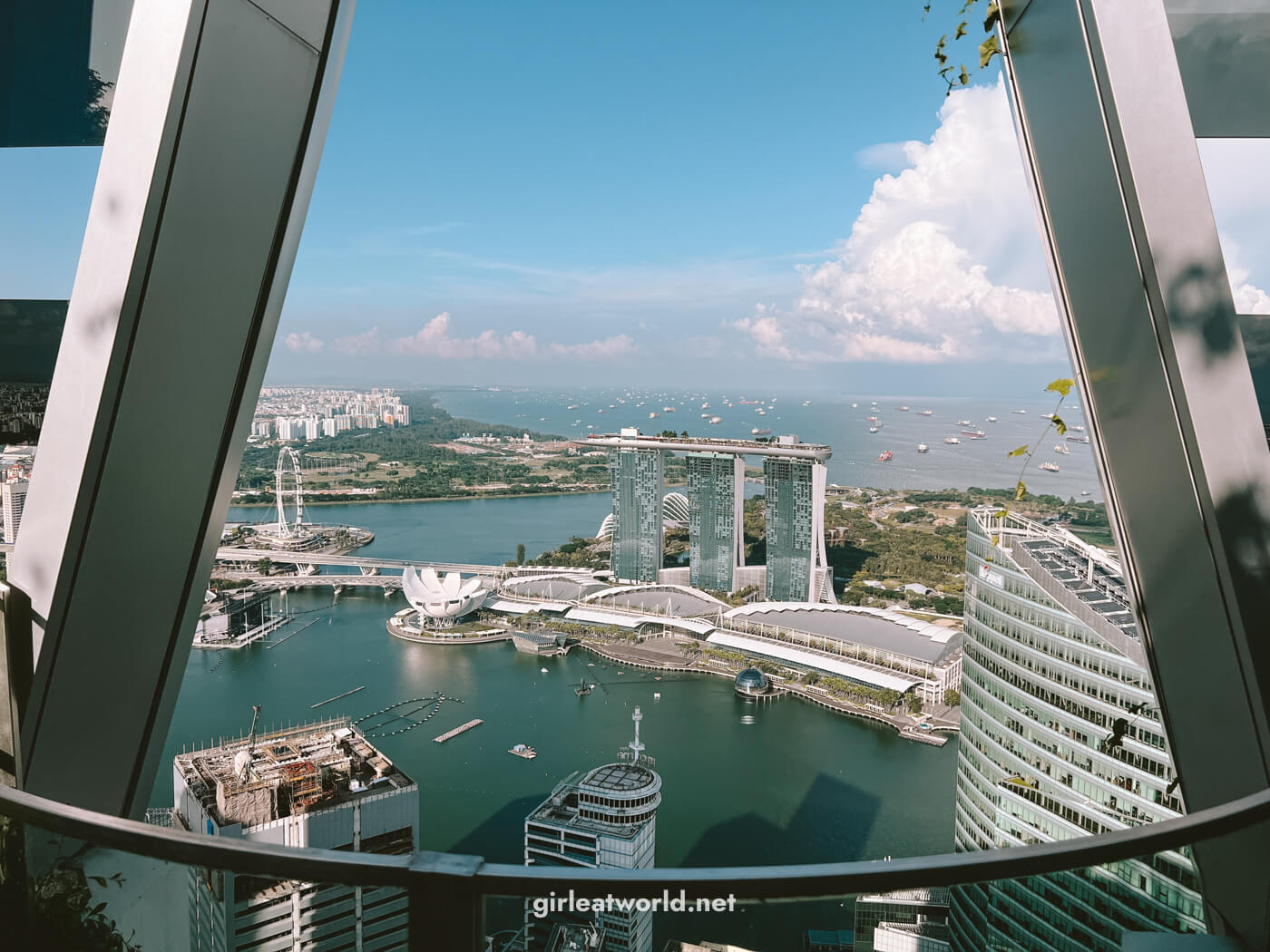
Where to stay in Singapore
Singapore is a small country – there is hardly any traffic jam, and taxis are available around the clock. I recommend staying in the Central area, Little India, Bugis, or Chinatown.
Here are a few hotels you can consider:
The Scarlet Hotel ($$) – A luxury boutique hotel located conveniently in a shophouse on Club Street, one of Singapore’s most lively streets filled with cocktail bars and chic restaurants. It’s also within walking distance to Chinatown.
Intercontinental Bugis ($$$) – This hotel has direct access to Bugis Junction shopping mall and Bugis MRT station, making it a very convenient choice to stay. You’ll have access to restaurants and grocery stores without having to step outside, which makes it great when it’s raining or too hot in Singapore. You’ll also have access to both the green and blue train lines from Bugis MRT station.
Raffles Hotel ($$$$) – Raffles Hotel is one of the most iconic hotels in Singapore, dating back to 1887. Although the rooms are kept in the old colonial black-and-white style, the hotel has been refurbished several times, most recently in 2017. It is truly a gem and the location is hard to beat – right across from Raffles City shopping mall and City Hall MRT, where you can access the green and red train lines.
Marina Bay Sands ($$$$) – Of course, everyone knows the famous Marina Bay Sands. Sometimes referred to as MBS here, it is known for its infinity pool on the rooftop on the 57th floor overlooking Singapore. Since its opening in 2010, MBS has become the most iconic landmark of Singapore’s skyline.
Shangri-la Orchard ($$$) – Located at the heart of the city, Shangri-la Orchard has been around since 1971. That’s almost as old as Singapore itself as a country! But if you are expecting a dated hotel, you won’t find it here. Instead, you will find a luxurious hotel that even locals love to staycation in. I wrote a review of the hotel when I stayed there, so be sure to check it out!
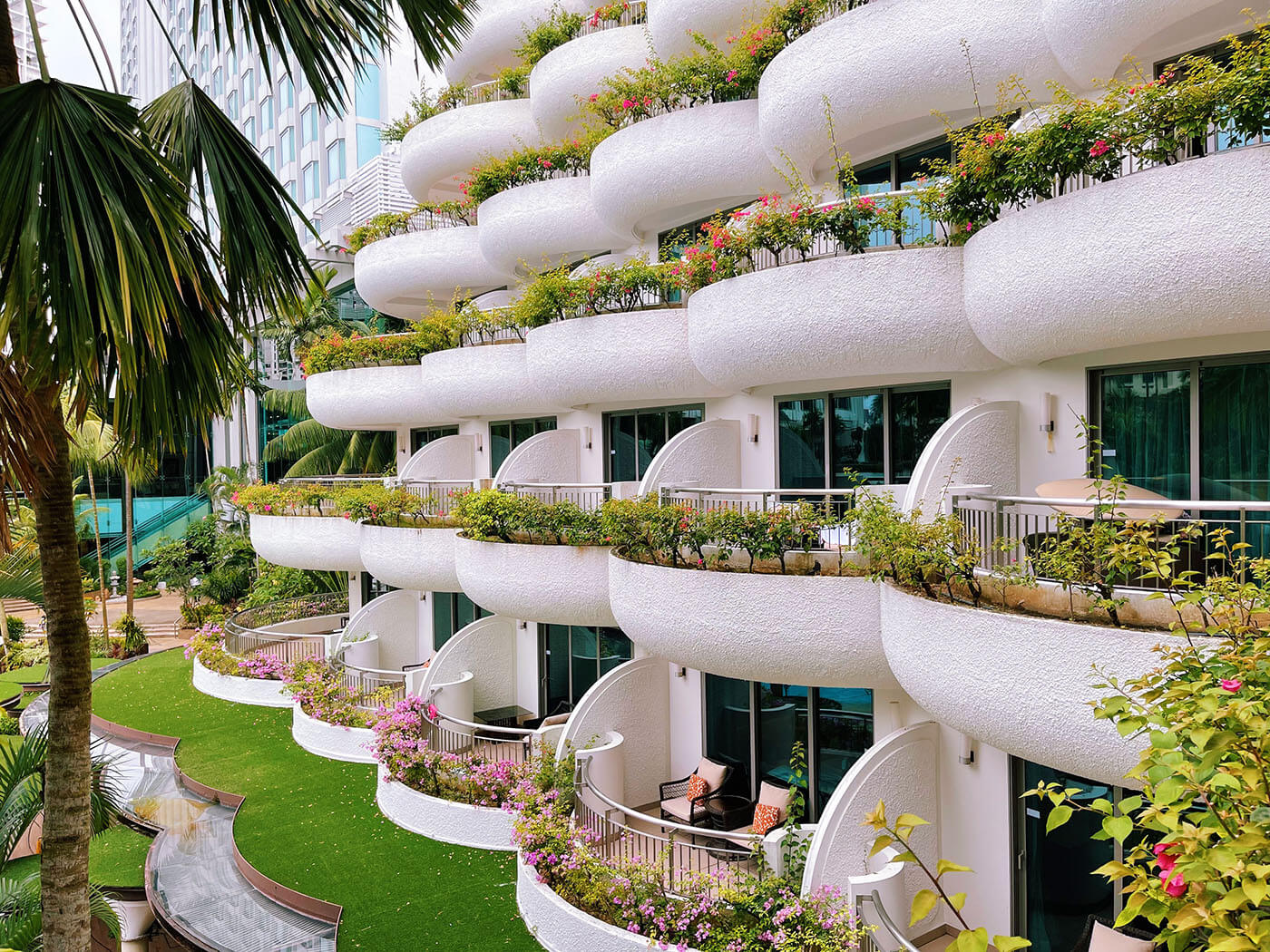
What to Eat in Singapore
Singapore often gets a lot of flak for not having a dish that is uniquely Singaporean. But you know what? While that may be true, I’d like to take pride that Singapore is one of the few places in the world where you can sample a great variety of dishes with excellent quality and authenticity.
Singapore Food Guide: I’ve written up an extensive round-up of all the food to try in Singapore, and where to try them
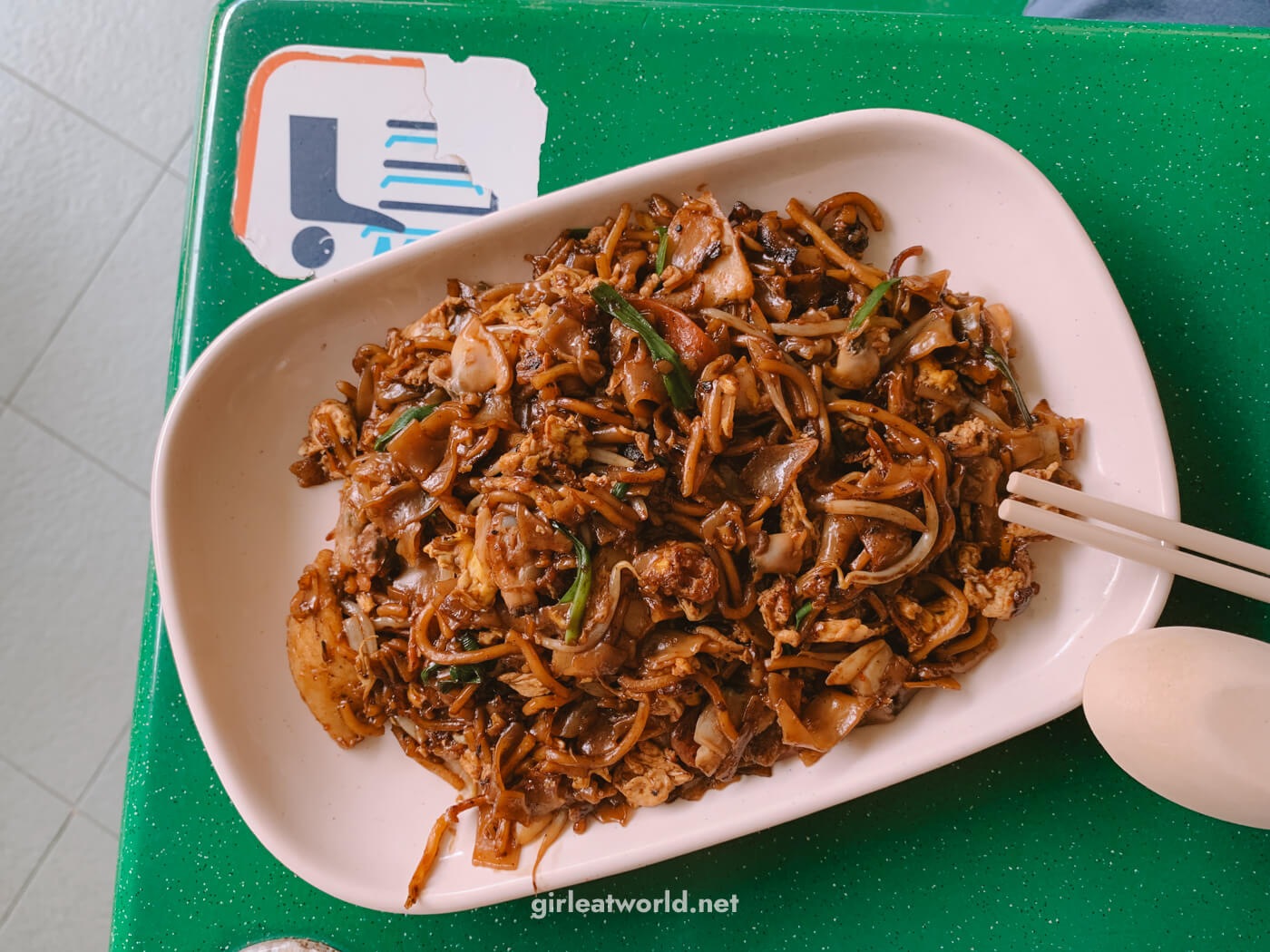
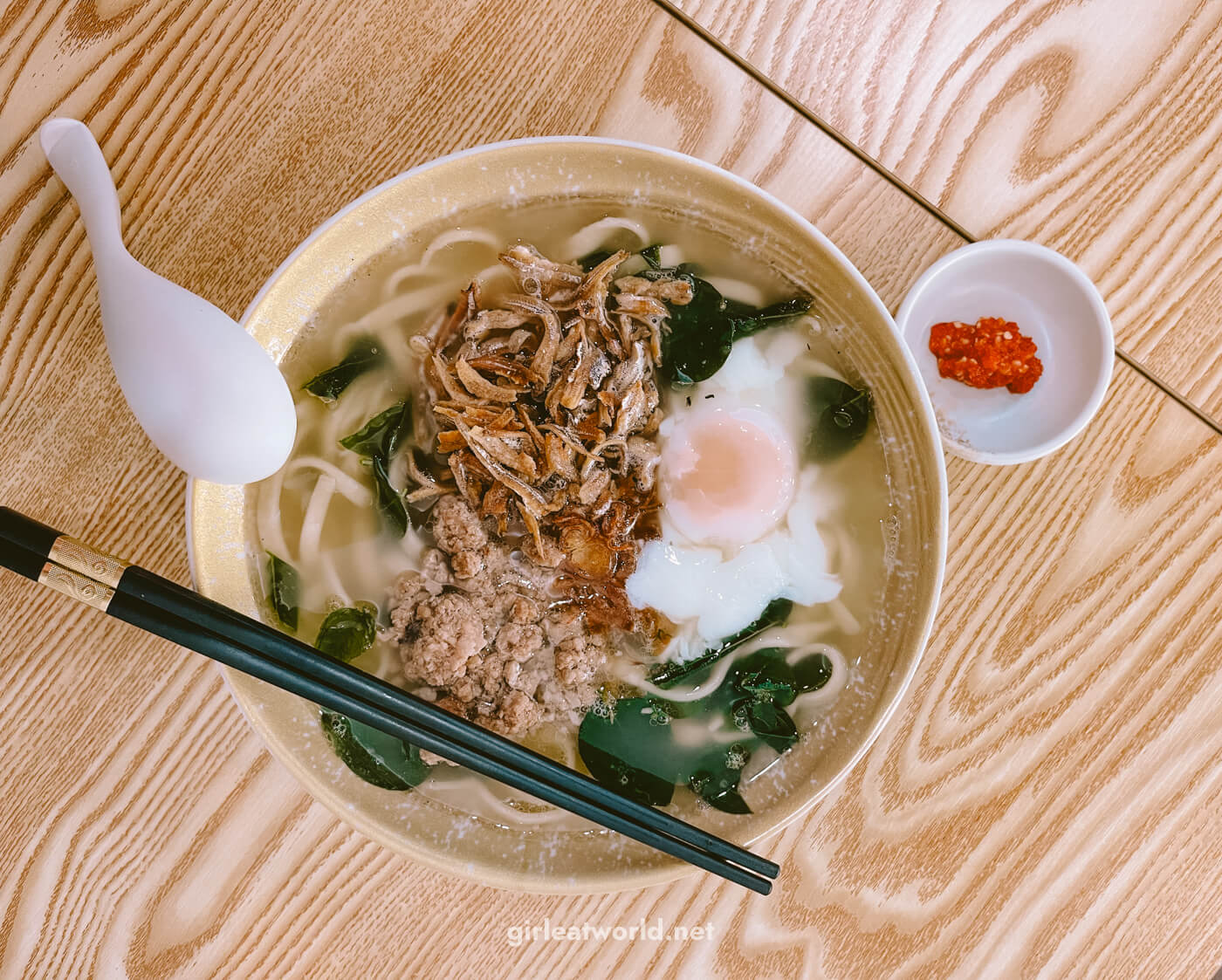
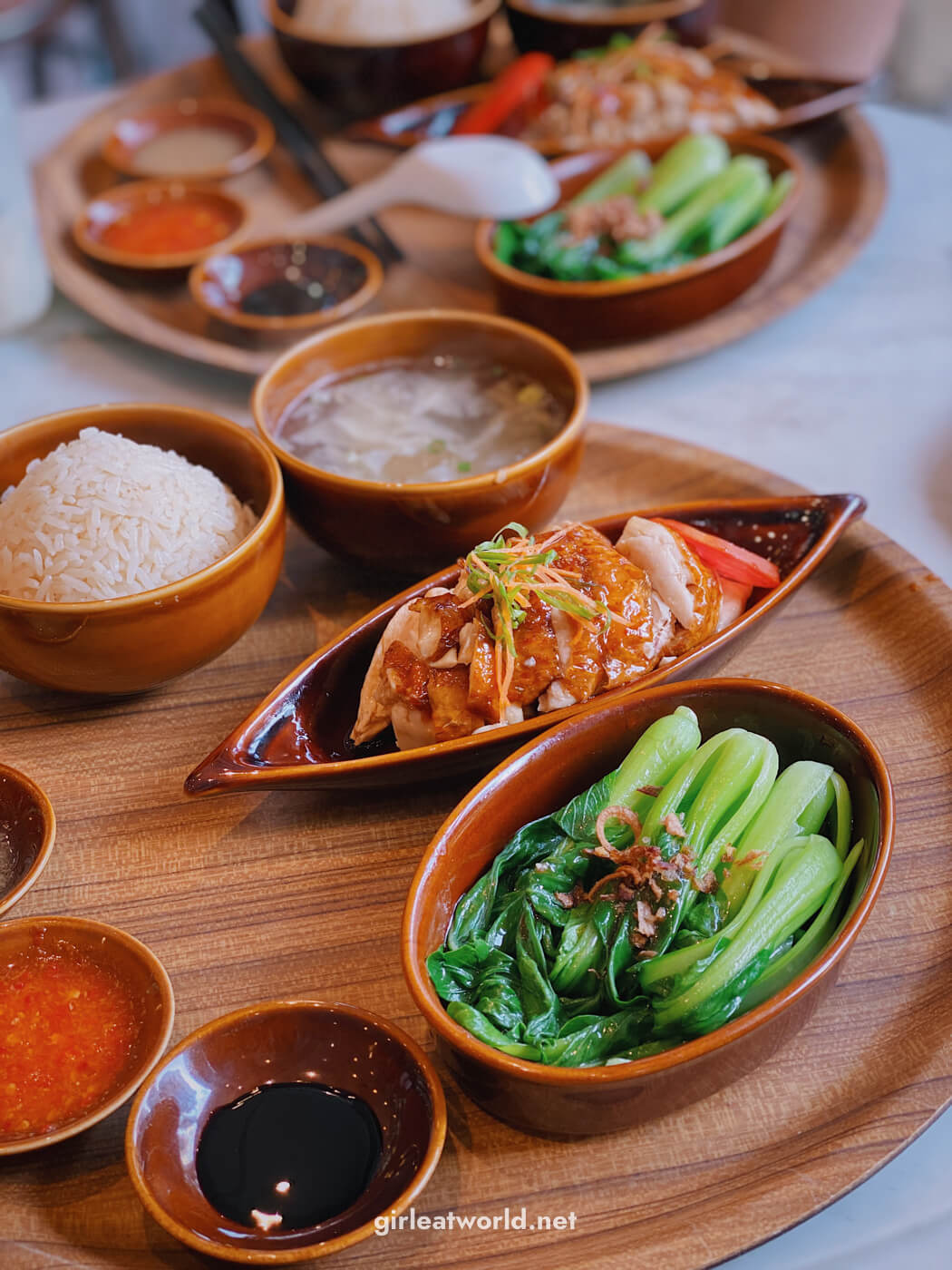
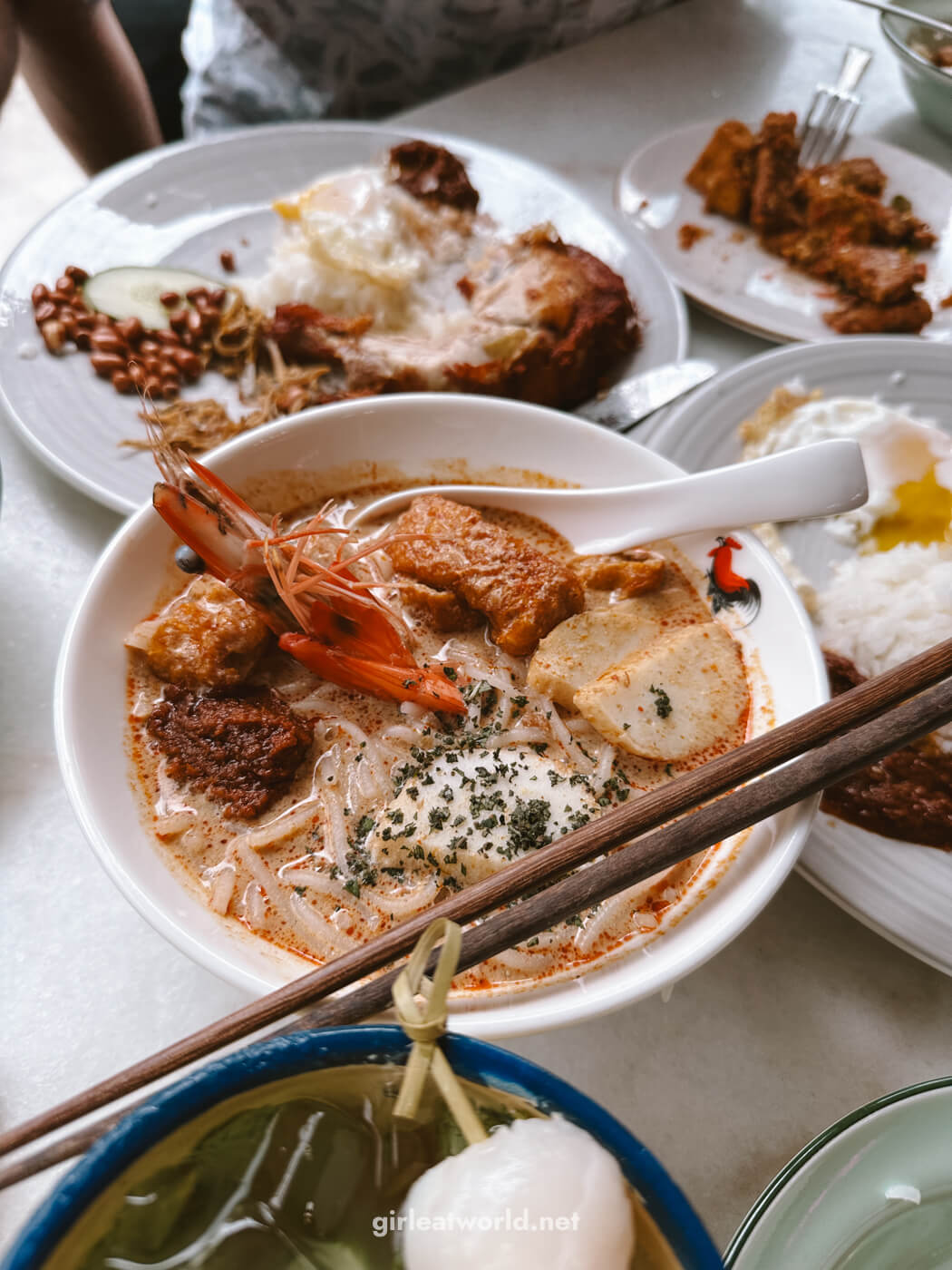
The Ultimate Singapore Itinerary
Finally, let’s get to the itinerary! Singapore is a small country, but there are still a lot of things to see here as a first-timer. Depending on how much time you have in the city, I have created a few daily itineraries.
- Day 1: Historical Singapore Tour
- Day 2: Singapore Neighborhoods
- Day 3: Singapore The Garden City
- Day 4: Visit the Singapore Zoo
- Day 5: More things to do in Singapore
Please take note that itineraries do not have to be done in the same chronological order as I have listed. You do not need to do Day 2 after Day 1. I have grouped a few activities that are easy to do together in one day so that it’s more convenient!
Day 1: Historical Singapore Tour
On this day, we will be exploring some of the historic areas of Singapore. You’ll be moving through different areas by foot, as well as taking public transportation. So wear comfortable shoes, dress appropriately for the weather, and get your contactless-compatible credit card ready!
If you start early in the morning and closely follow the itinerary, your day might look like this:
| 8:45 AM | Breakfast at Ya Kun Kaya |
| 9:30 AM | Explore Chinatown |
| 12:00 PM | Lunch at Chinatown area (and continue to explore the area) |
| 02:30 PM | National Museum of Singapore |
| 04:30 PM | Waterfront Promenade |
| 06:30 PM | Marina Bay Sands Skypark |
| 07:30 PM | Dinner at MBS |
| 08:45 PM | Garden Rhapsody Show |
As you can see, this is a pretty full-on schedule from early morning til night time. I’d like to remind you that this itinerary is merely a recommendation, so please feel free to pick and choose which activity you want to do!
1. Try the quintessential Singaporean Breakfast
Start your day with breakfast loved by all Singaporeans. Actually, I’ll take that back – you can have this any time of the day 😉
A breakfast set in Singapore usually consists of Kaya Toast with cold butter, accompanied by two soft-boiled eggs and a cup of local Kopi (the local way of saying “coffee”). You could skip the eggs and coffee, but I highly encourage you to try at least the Kaya toast, served with kaya jam and butter. Kaya jam is made from coconut milk, eggs, and sugar and is totally delicious.
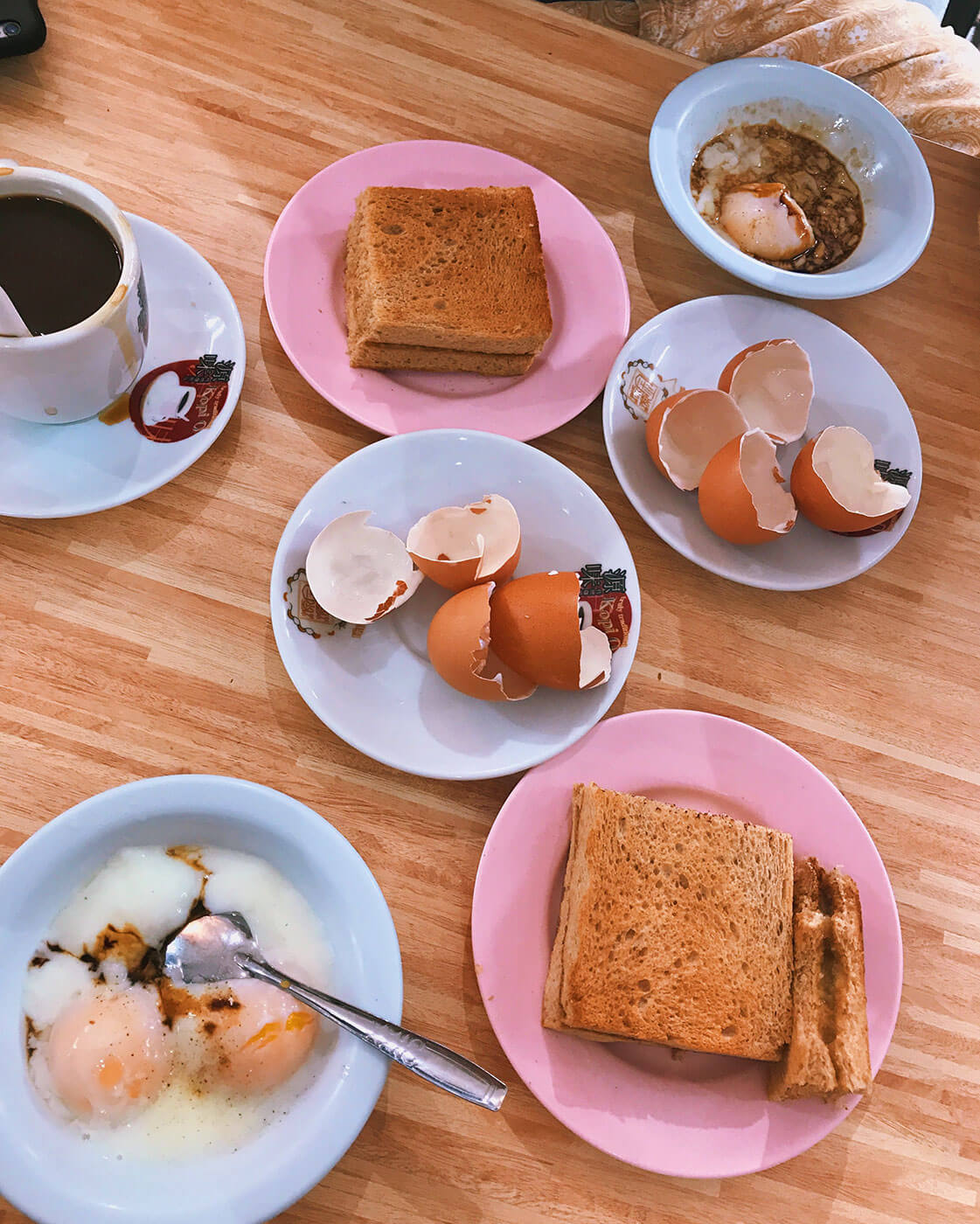
I recommend heading down to Ya Kun Kaya Toast on China street (map) – it’s their first outlet since 1944 and is their most authentic outlet. It also helps that it’s in the middle of the city so it’s highly accessible.
However, if you can’t make it to this location, there are plenty of other Ya Kun locations around the city too. And honestly, even just any local food center will have a stall that sells Kaya toast. Toast Box is also a perfect alternative and well-loved by locals.
2. Explore Singapore’s Chinatown
From Ya Kun Kaya, Chinatown is only a short walk away – it’s just across the street actually!
A bit of back story of the Chinatown area – If you take the MRT to Chinatown, you will notice that the station is displayed using three Chinese characters 牛车水. Those characters do not mean “Chinatown”, but they do tell a history of this area very well. 牛 is the character for “cow”, 车 is “car” and 水 is “water”. This is because back in the day, freshwater supplies were carried using carts pulled by oxen from a well in Ann Siang Hill, which I will get to in a minute.
I recommend starting from Telok Ayer Street, literally translated to “Bay Water” in Malay (which by the way, is one of the four national languages of Singapore). Why the name? This area was literally the coastal line of Singapore before the country began reclaiming lands in the late 1880s. Back when it was still a coastal line, boats would line up and wait for freshwater here before hauling them up to Ann Siang Hill.
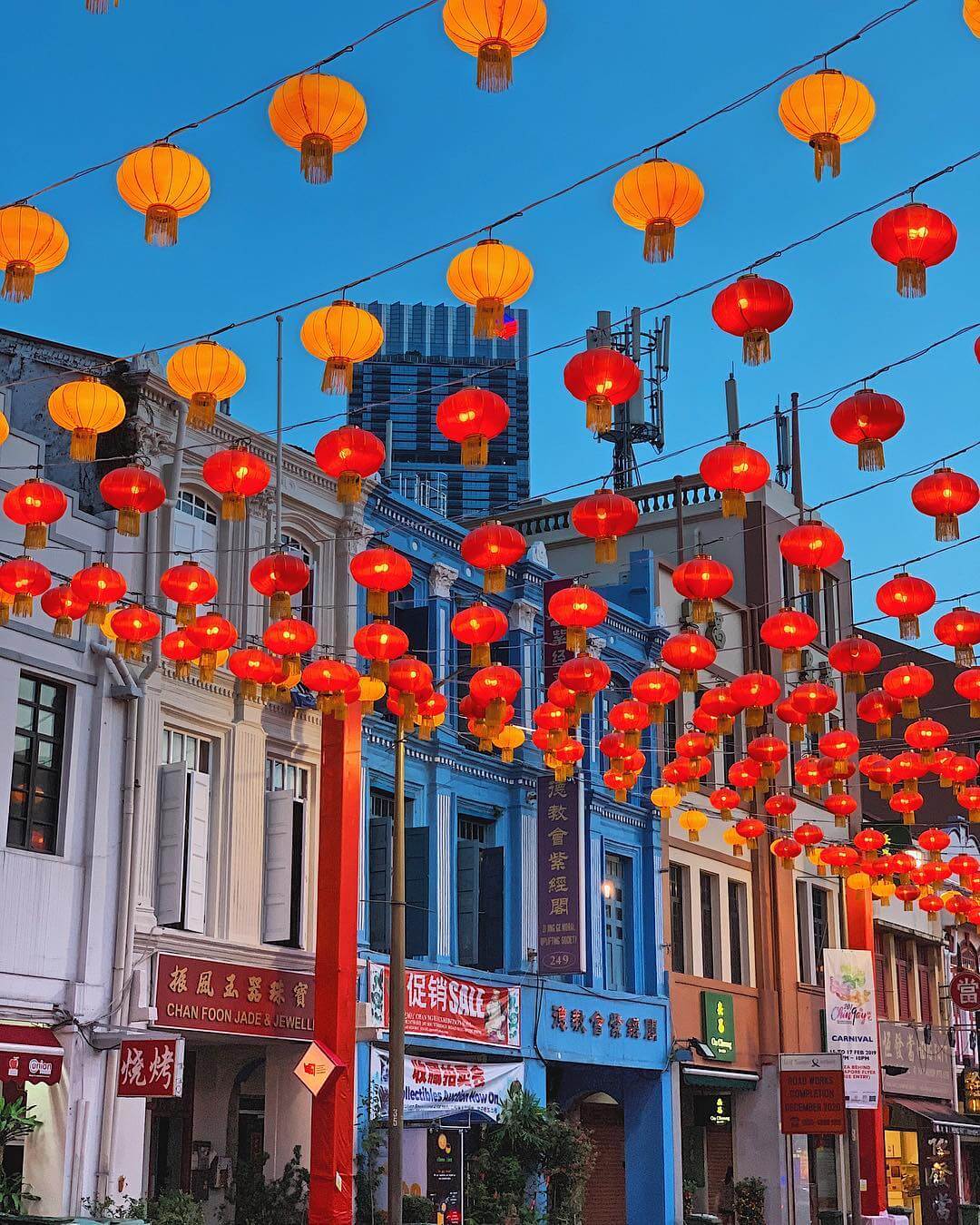
On Telok Ayer Street, you can find Thian Hock Keng temple, the oldest Hokkien temple in the country. While exploring the temple, take note of the beautiful tiles in and around the temple. These are the Peranakan tiles.
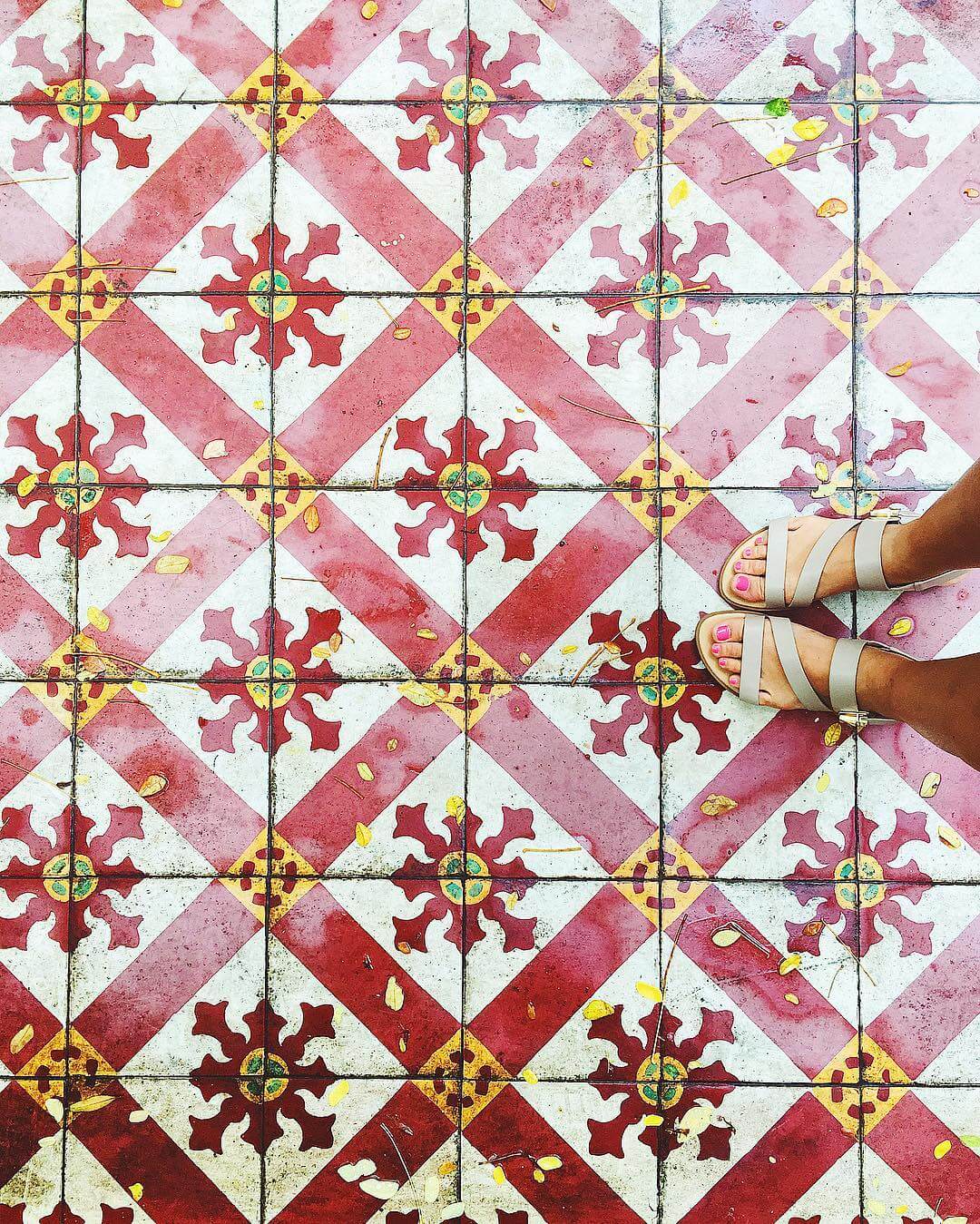
Later on, in Chinatown, I recommend stopping by Peranakan Tile shop to see the various tile designs. The tile shop used to be located in this temple but had moved to 37 Pagoda Street, just a short 10-minute walk away from here, which we will cover in this itinerary.
From Telok Ayer Street, you can walk north to Ann Siang Hill and find the water well I was talking about earlier. Just past Ann Siang Hill, locate Maxwell Road and the Singapore City Gallery at the URA building. It’s a museum showcasing the development of Singapore as a city, and entrance is free of charge. If you’re interested in city planning, this is the place to go – it showcases Singapore’s past as well as future plans as a city.
Then, make your way to Chinatown Central, where you’ll find Sri Mariamman Hindu Temple, Buddha Tooth Relic Temple, and also, the Peranakan Tile shop that I mentioned before.
The Chinatown area, as the name indicates, was the settlement area for Chinese immigrants who came to Singapore in the 1800s. Nowadays, it’s a bustling area filled with shops, restaurants, and night markets.
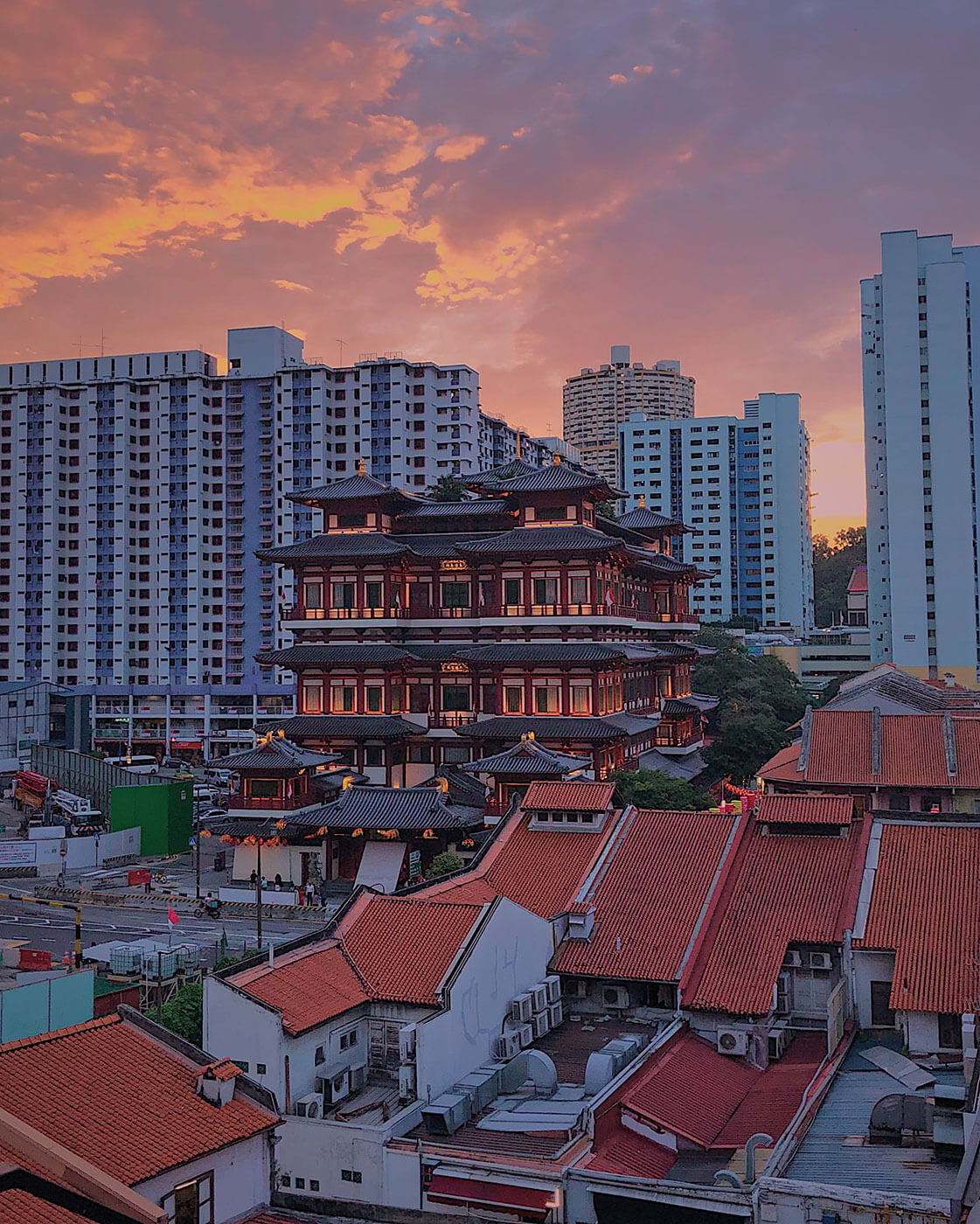
Continue your way to Kreta Ayer Road and Keong Saik Road. Kreta Ayer simply means “Cart water” in Malay, and similar to Telok Ayer, it was named so due to its past history involving fresh water being carried by oxen carts. Keong Saik Road, on the other hand, is an area that was once a prominent red light district but has now turned into a hip area filled with bars and boutique hotels, housed in colorful preserved shophouses.
If you are in Singapore during the Chinese New Year period, you will find the area decorated and bustling with activities! Check the Singapore Events Calendar here.
Nearby Keong Saik Road is the EW16 Outram Park MRT , which you can take to your next destination at EW13 NS25 City Hall MRT .
3. Visit the National Museum of Singapore
By now you probably need some respite from the Singapore weather. Near the EW13 NS25 City Hall MRT is the National Museum of Singapore. I recommend visiting this place if you want to learn more about the history of modern Singapore at the Singapore History Gallery.
Entry is free for Singaporeans, but foreigners need to pay a small, nominal fee. You can purchase the tickets from Klook.
4. Walk around the Waterfront Promenade
From City Hall MRT, take the green line back down to EW14 NS26 Raffles Place MRT to get to the waterfront.
One of the areas I always recommend friends to visit is the Singapore waterfront promenade. It’s very accessible (practically in the middle of the city) and it’s a very cool area to walk around in.

From Raffles Place MRT, you can make your way to Fullerton Hotel. The hotel is located in a historic building that was originally built in 1928 and had been used for many purposes – the General Post Office, a hospital during World War II, and the Inland Revenue Authority of Singapore (tax) headquarters, before finally being restored into a five-star luxury hotel in 2001.
Head past the lobby and go down one level to the basement, and you’ll find a walkway that will take you to One Fullerton, a short walk away from the Merlion Statue. Merlion is a mythical creature that resembles a mermaid with the head of a lion (hence the name Merlion!).
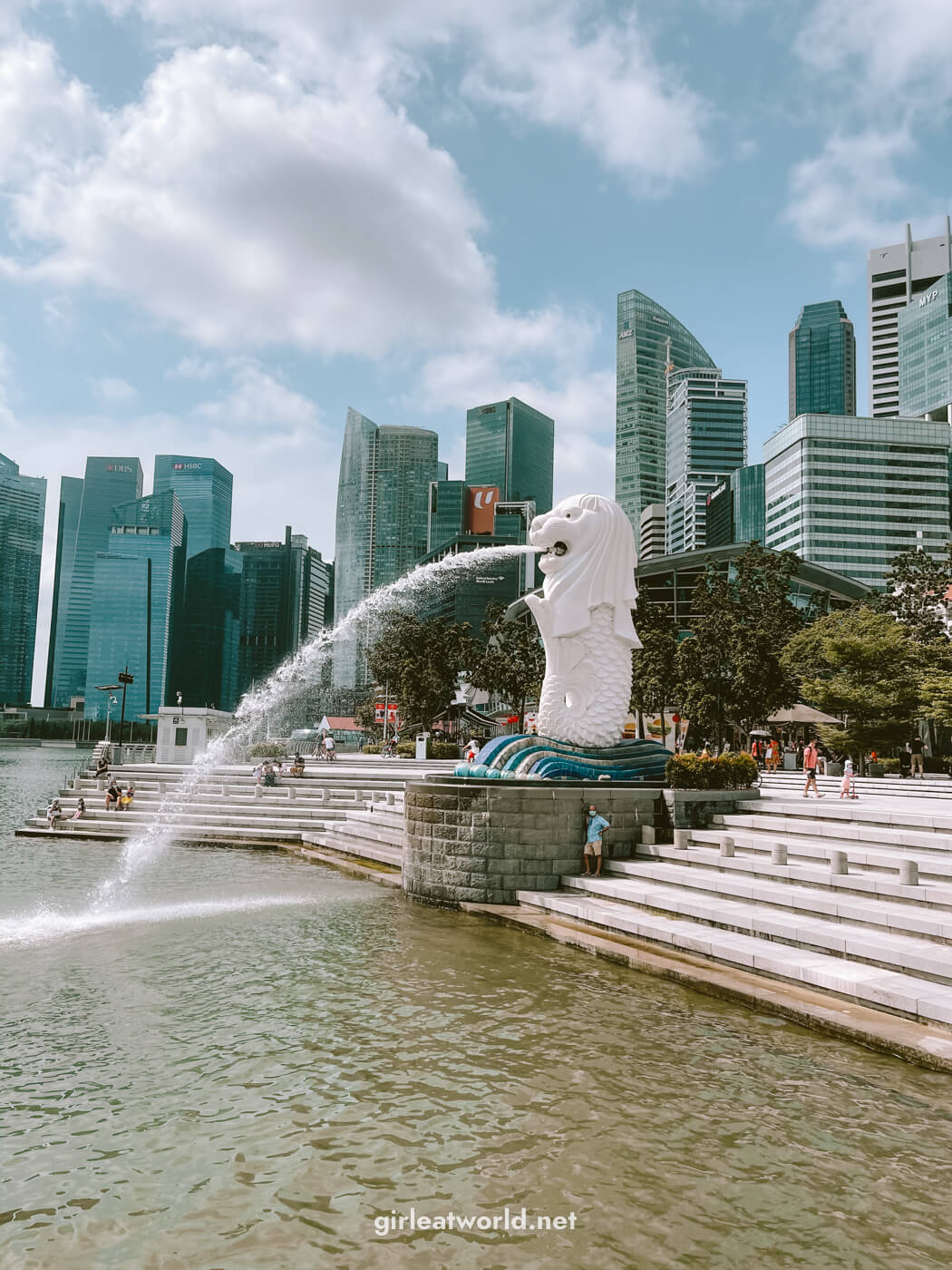
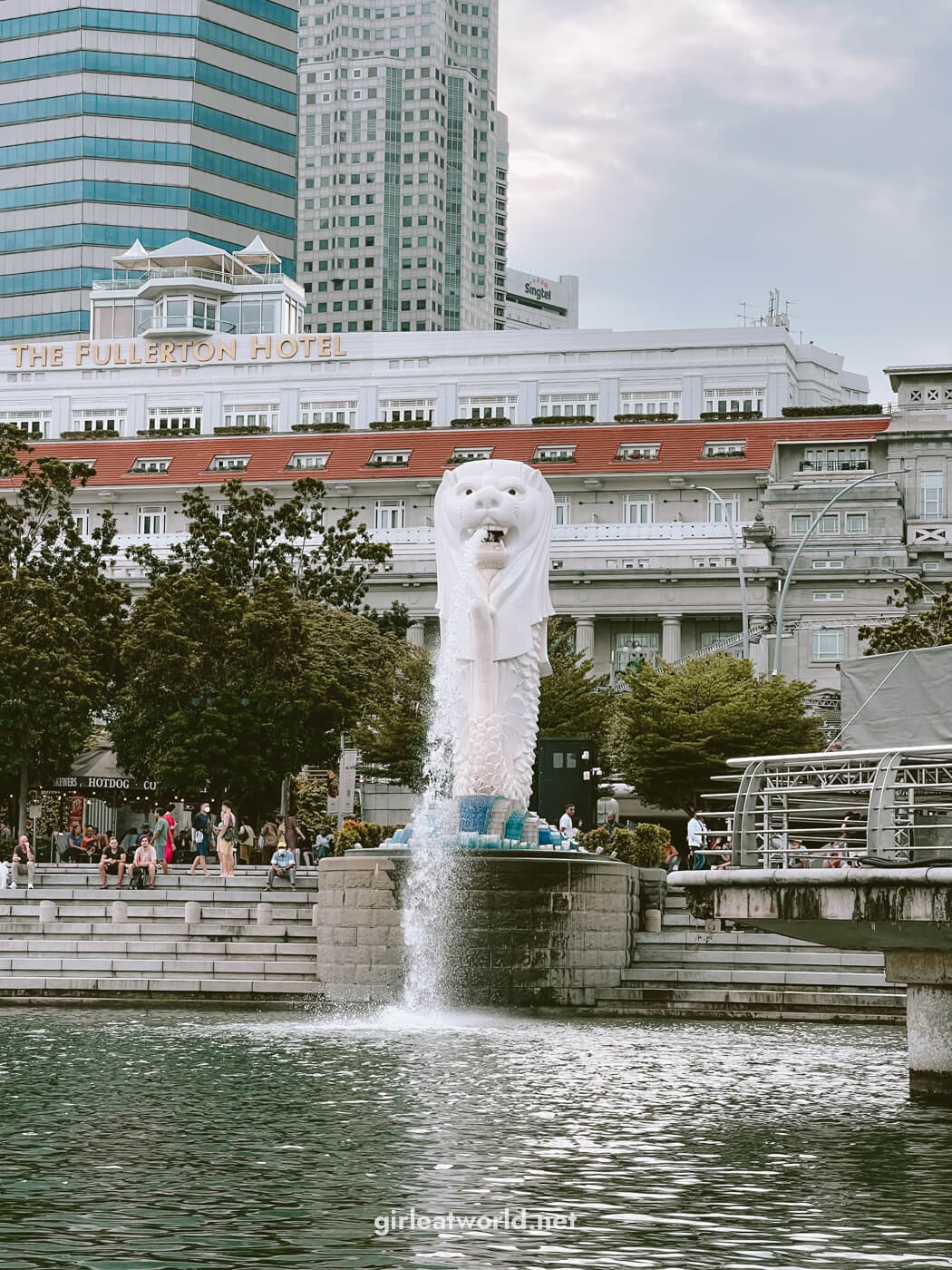
But why a lion? It has been speculated that the name “Singapore” comes from the Malay words Singa (which means lion) and Pura (which means city). Hence, Singapore has been nicknamed “lion city”. And the fish part? It is to symbolize Singapore’s past as a humble fishing village.
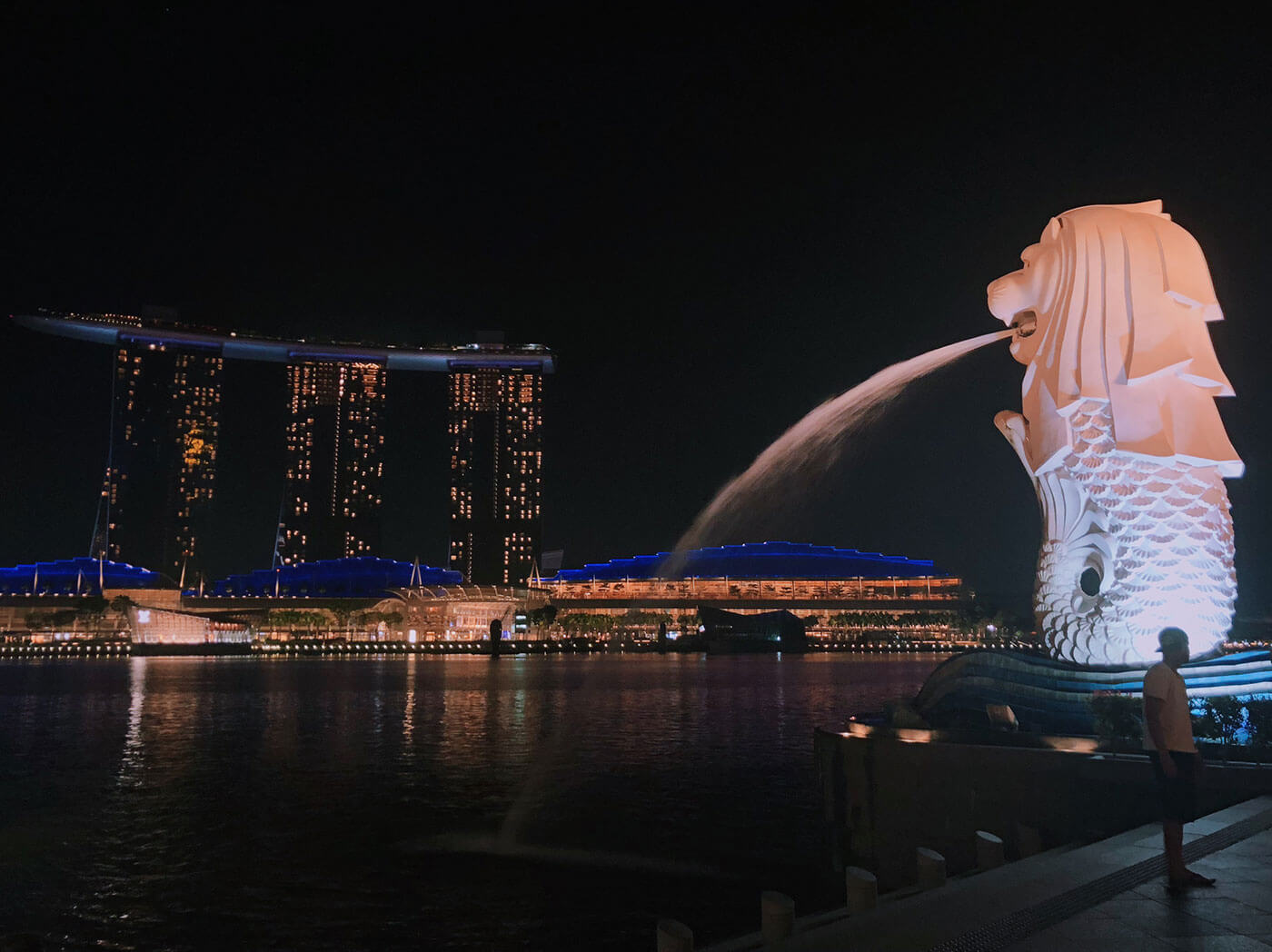
A little off the waterfront is the Raffles Hotel, the most charming and historical hotel in Singapore dating from 1887. You probably can’t visit most of the private areas unless you are a guest of the hotel, but you can still take a look at the lobby and admire its colonial-style look and furniture.
Most notably, you’ll want to visit the Long Bar at Raffles Hotel which is said to be the place where Singapore Sling, the cocktail, was born. While I personally think the Singapore Sling is way too sweet and overpriced (it’s SG$32 per drink!!), I loved the charm of the Long Bar itself.
The Long Bar features countless notable guests, such as Ernest Hemingway, Elizabeth Taylor, and Alfred Hitchcock. At the bar, you’ll also notice peanut shells scattered around the floor – this is part of the long tradition left from colonial times and quite possibly the only place in squeaky-clean Singapore where littering is actually encouraged.
If you decide to walk along the water on the promenade, you’ll come across a lotus-shaped building. This is the ArtScience Museum, one of my favorite museums in Singapore. The museum often houses very interesting exhibits, and one of their permanent exhibits is interactive pieces by the famous teamLAB from Japan.
You can check what’s on and buy tickets for ArtScience Museum exhibits here.
5. Marina Bay Sands Skypark
And nearby the Art Science Museum is the Marina Bay Sands Hotel with the famous infinity pool at the top of the hotel. While the pool is strictly for hotel guests only, there is an observation deck called the Marina Bay Sands Skypark which can be visited by the public. The Skypark will give you a 360 view of the Singapore waterfront area.


If the weather is good, I would recommend visiting the Skypark close to sunset – around 6:15 PM – 6:30 PM would be ideal because the sun sets around 7 PM in Singapore.
A ticket is required to visit the Skypark. Get the tickets here! For entry after 4 PM, you do need to book a time slot when you buy the ticket.
6. Visit Gardens By The Bay for the Garden Rhapsody Show
A visit to the Gardens By The Bay requires at least three hours to properly walk around the area and visit the Flower Dome and Cloud Forest. But, we will cover that on the next day.
After walking around the promenade, I do recommend going to Gardens By The Bay at night and catching the free show Garden Rhapsody – you’ll see the Super Tree in all its glory, with a matching musical number! They do the show every night at 7:45 PM and 8:45 PM.
Timing: Check Garden Rhapsody Schedule here for the most up-to-date schedule.
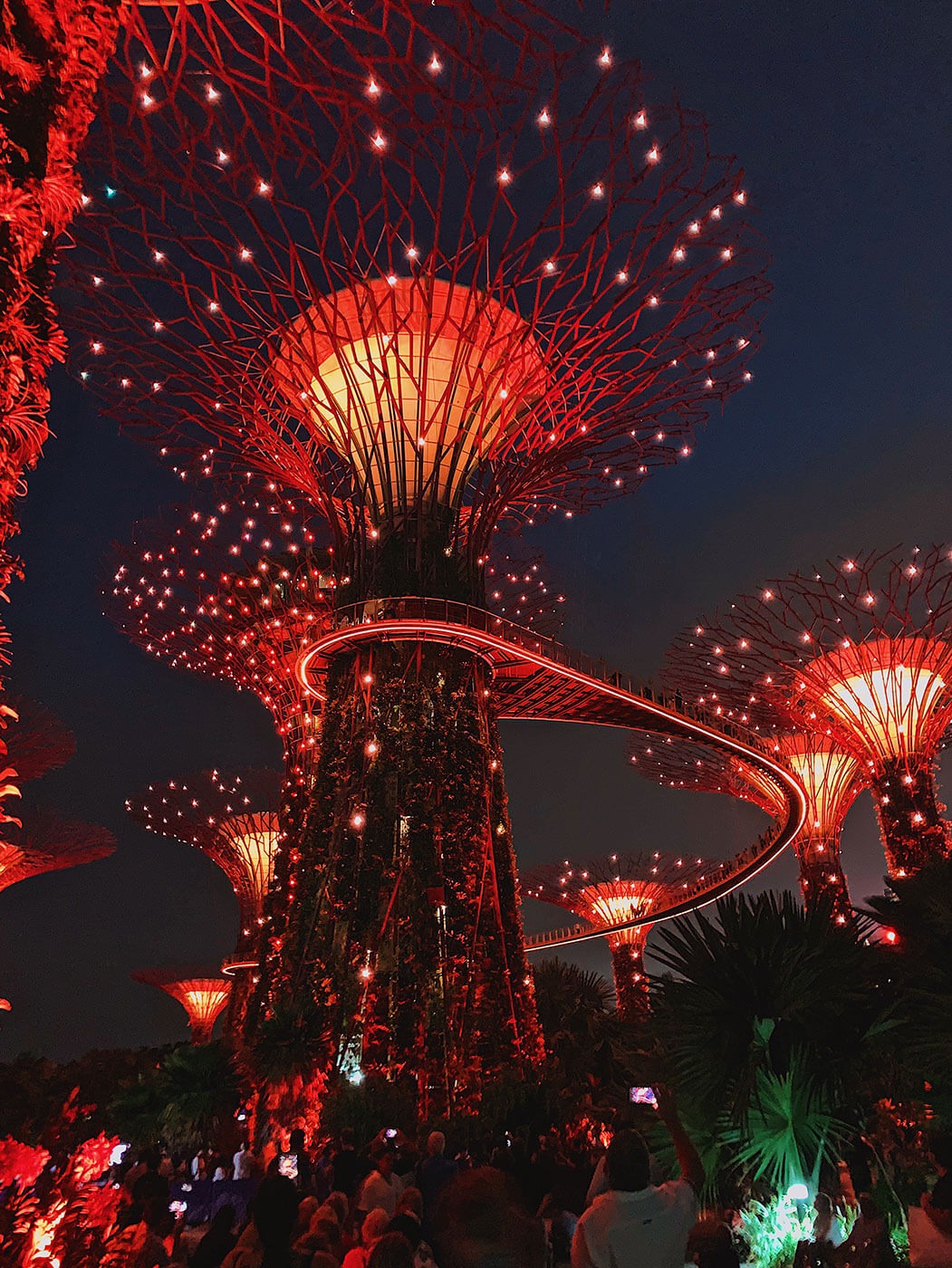
Entry to the Garden Rhapsody area is free, but there is a paid OCBC Skyway you can take to be even closer to the trees. I recommend this only if you have more than half an hour at the park (not counting the Garden Rhapsody, which takes 15 minutes).
Buy OCBC Skyway ticket here via Klook. The attraction closes at 8pm.
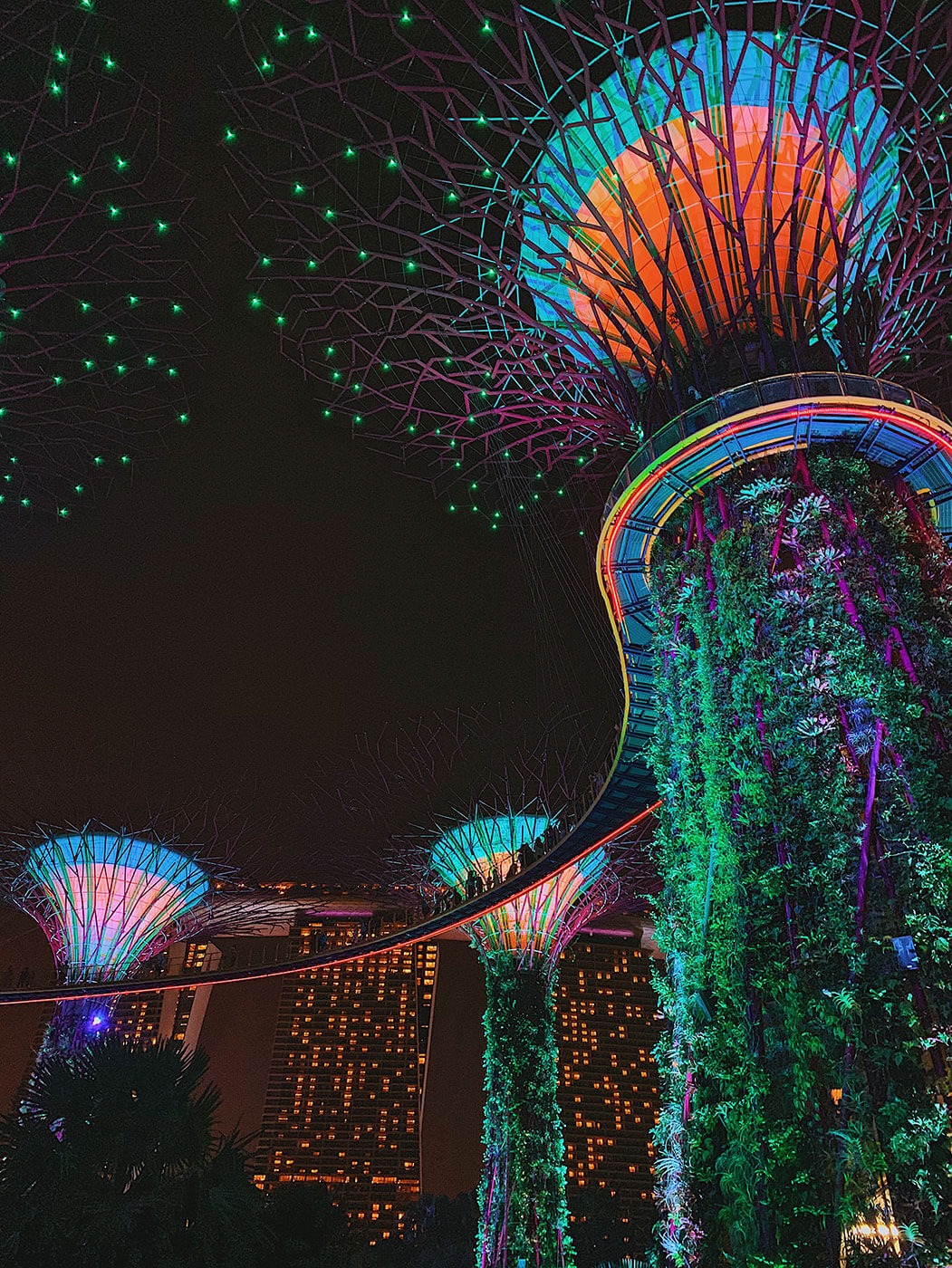
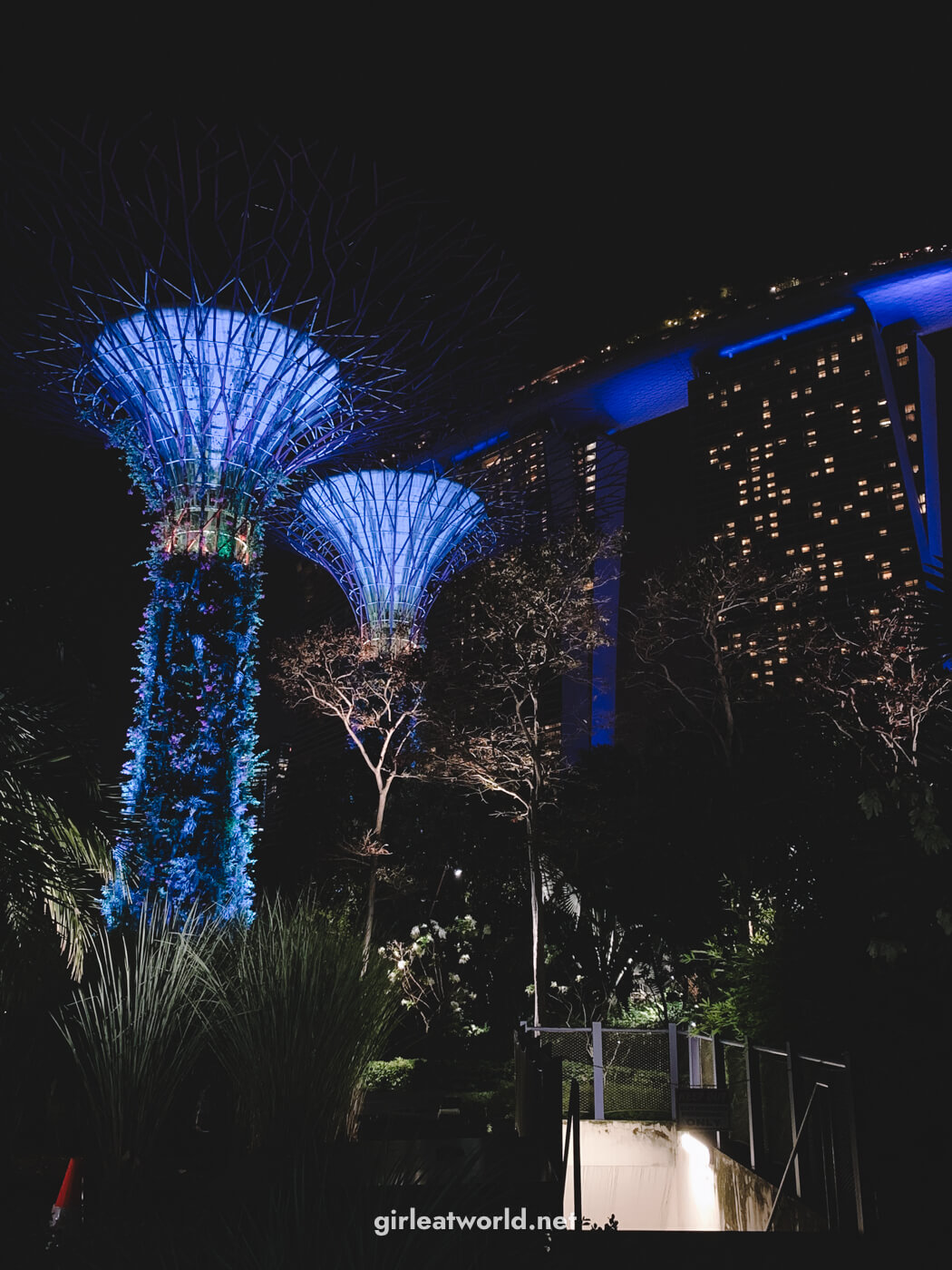
However, if you’re not keen to see the Garden Rhapsody show, you could watch the free Spectra light show instead. The best place to watch is from across the water at One Fullerton, or from LeVel 33, one of the restaurants with an amazing view of the waterfront.
Check the Spectra Light & Water show schedule here.

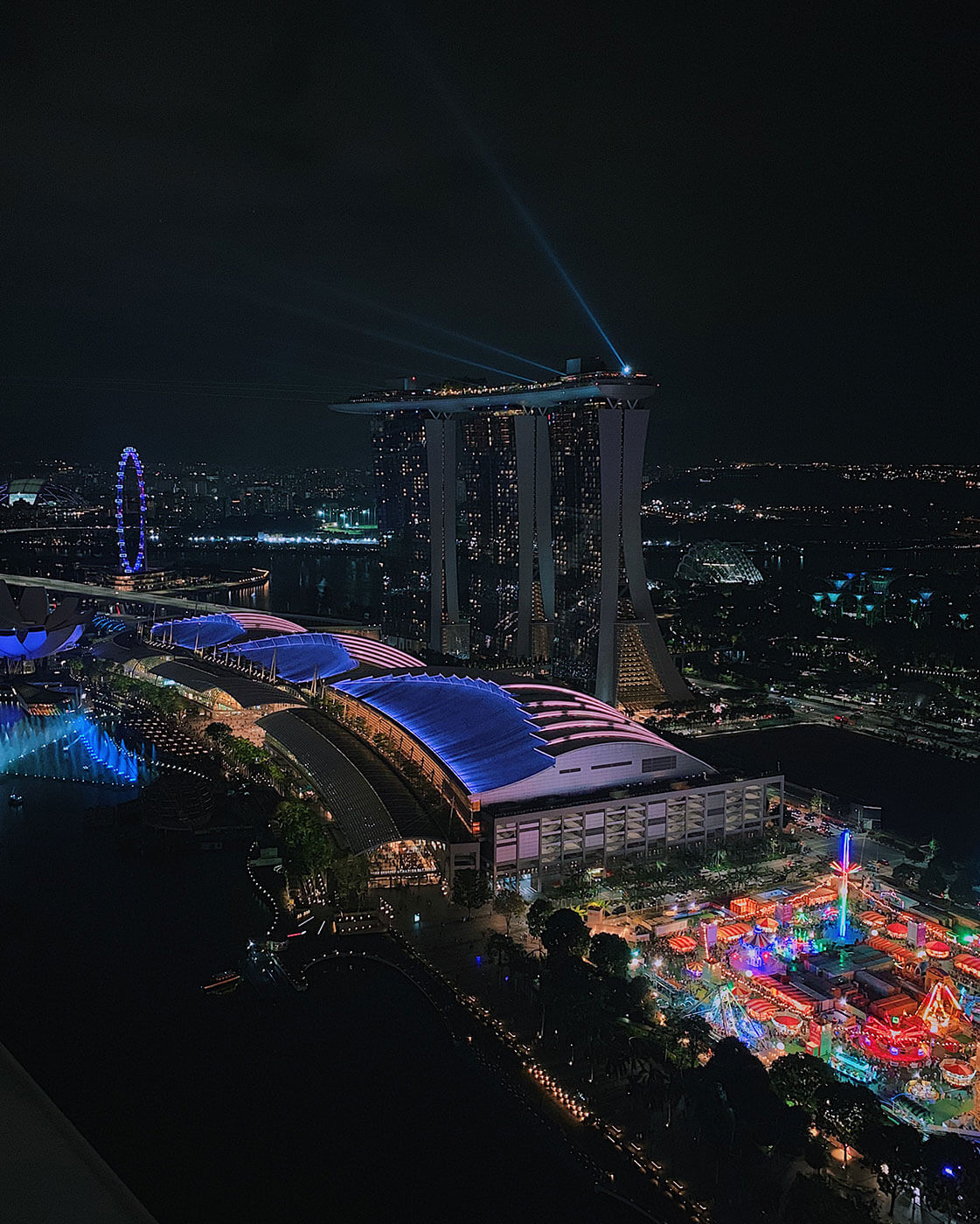
Day 2: Explore Singapore Neighborhoods
Continuing with the theme from Day 1, you’ll be exploring different neighborhoods of Singapore today. Be sure to be prepared to walk a lot and be prepared to deal with the weather.
If you start early in the morning and closely follow the itinerary, your day might look like this:
| 9:30 AM | Breakfast at Tiong Bahru Market |
| 10:00 AM | Tiong Bahru |
| 11:00 AM | Little India |
| 12:30 PM | Lunch at Little India |
| 1:30 PM | Kampong Glam |
| 3:30 PM | Joo Chiat |
| 6:00 PM | Dinner |
1. Start your day at Tiong Bahru
Tiong Bahru is one of the trendiest neighborhoods in Singapore, although it is also one of the oldest estates. It is popular with foreigners for its unique vibe that provides a traditional neighborhood feel while still having trendy cafes and bakeries around the area. Because of that, the price of property and rental in Tiong Bahru is probably the highest in the country.
From EW17 Tiong Bahru MRT , head over to Tiong Bahru Food Center for some breakfast. I recommend the following stalls:
- The Coco Rice (closed on Mondays)
- Tiong Bahru Hainanese Boneless Chicken Rice (Closed Mondays and Tuesdays)
- Zhong Yu Yuan Wei Wanton Mee (Closed on Mon, Tues, and Fridays)
Once you’re done with breakfast, you can head downstairs to the Tiong Bahru Market to see the wet market experience in Singapore. There will also be stalls selling snacks, fresh vegetables, and fruits.
Head outside to walk along Moh Guan Terrace, one of the pre-war public housing in Singapore that has fetched some of the highest prices in the already pricey housing market in Singapore. Among these houses, you’ll find cool shops, murals, and tiny bookstores tucked away in the alleys.
Here are a few places I recommend stopping by:
- Cat Socrates
- Creamier Ice Cream
- Micro Bakery
- Tiong Bahru Bakery
If you have the time, I also recommend to see if you can join this free walking tour. You can visit the Tiong Bahru Air Raid Shelter at Block 78 Guan Chuan Street via this tour.
2. Explore Little India
Next, take the train to NE7 DT12 Little India MRT . Your first stop from the Little India MRT is Tan Teng Niah House.

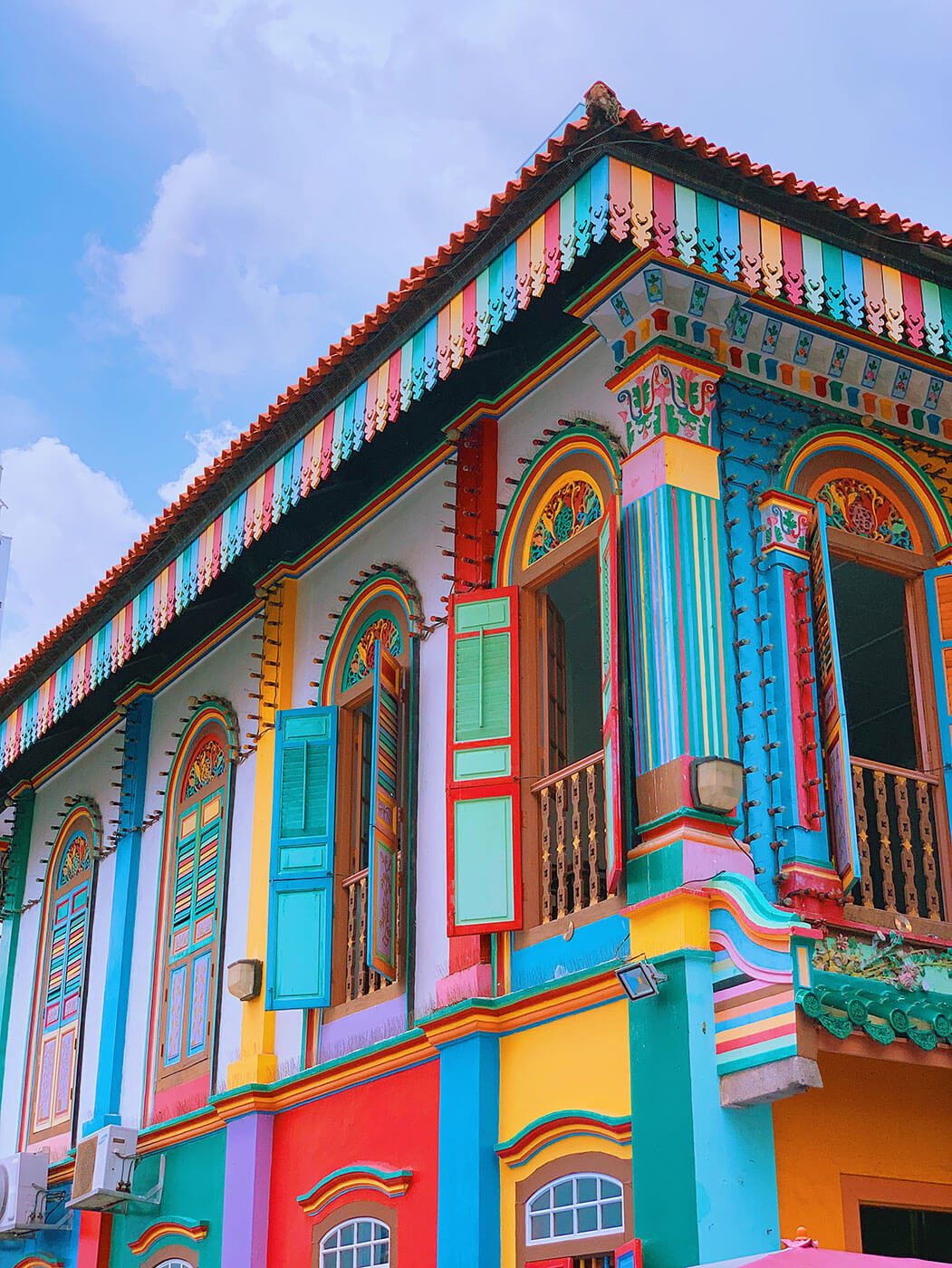
This colorful building is the former residence of Tan Teng Niah, the last Chinese villa in Little India. Tan Teng Niah owned sugarcane sweet factories in the area back in the 1900s. The house was restored and conserved in the 1980s for commercial use, and the restoration project was awarded the Singapore Institute of Architects Honourable Mention in 1991.
From Tan Teng Niah house, make your way down Serangoon Road on foot and just take in the atmosphere of Little India. It might be a little chaotic if you are here on a weekend.
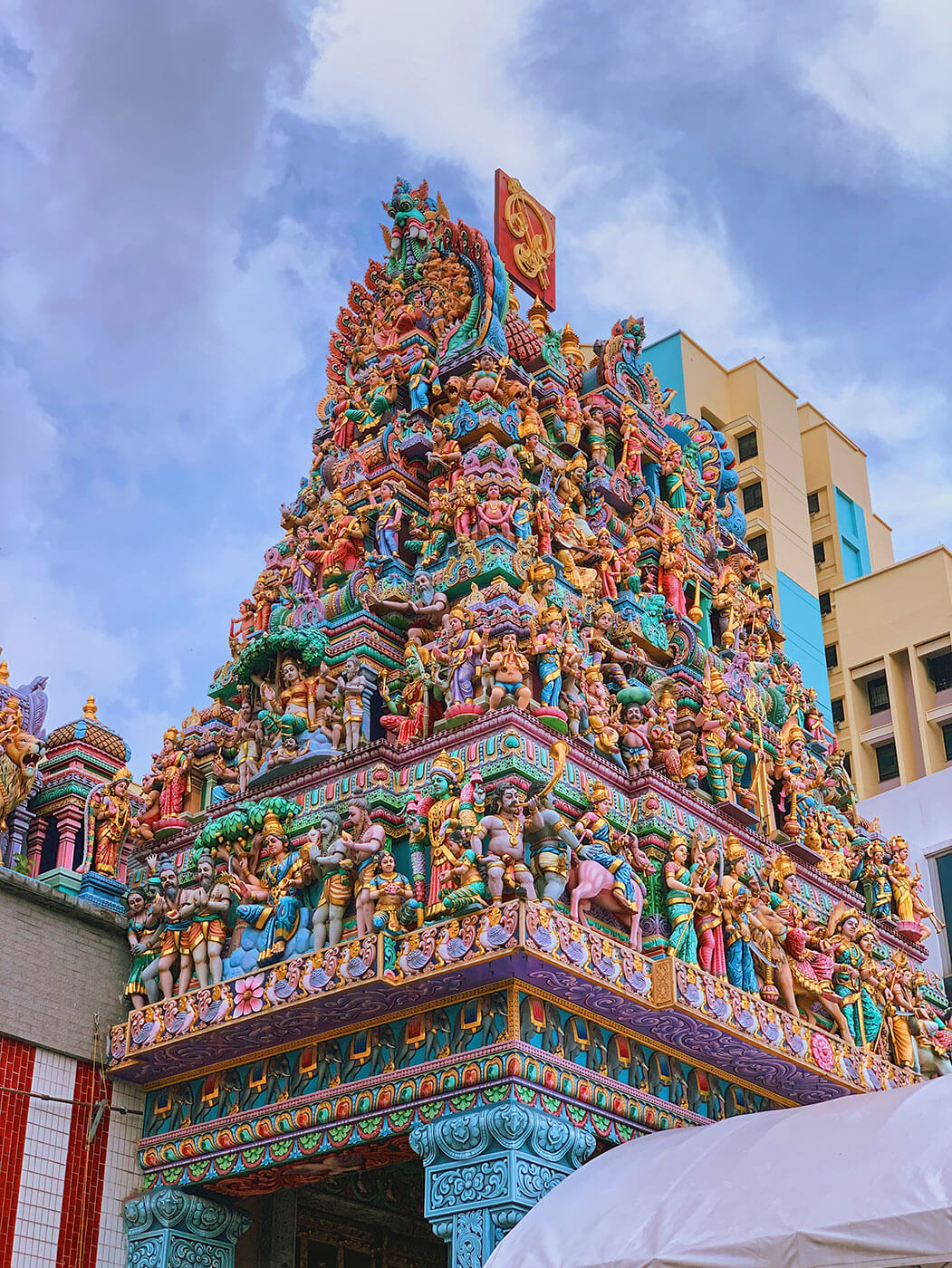
This incredibly ornate gate is the Gopuram (entrance tower) of Sri Veeramakaliamman Temple, a Hindu temple in Little India. It is dedicated to the Hindu goddess Kali, the fierce embodiment of Shakti, and the god Shiva’s wife, Parvati. You are allowed to enter the temple, but please take off your shoes before you do. There are places designated for your footwear right outside the temple.
Deepavali Light Festival: Little India is one of the most festive neighborhoods in Singapore. If you are so lucky to have come to Singapore during one of the festivals, especially Deepavali, you’ll find the neighborhood even more lively and brightly decorated. Check out the Deepavali Festival Village if it’s on. Check the Singapore Events Calendar here.
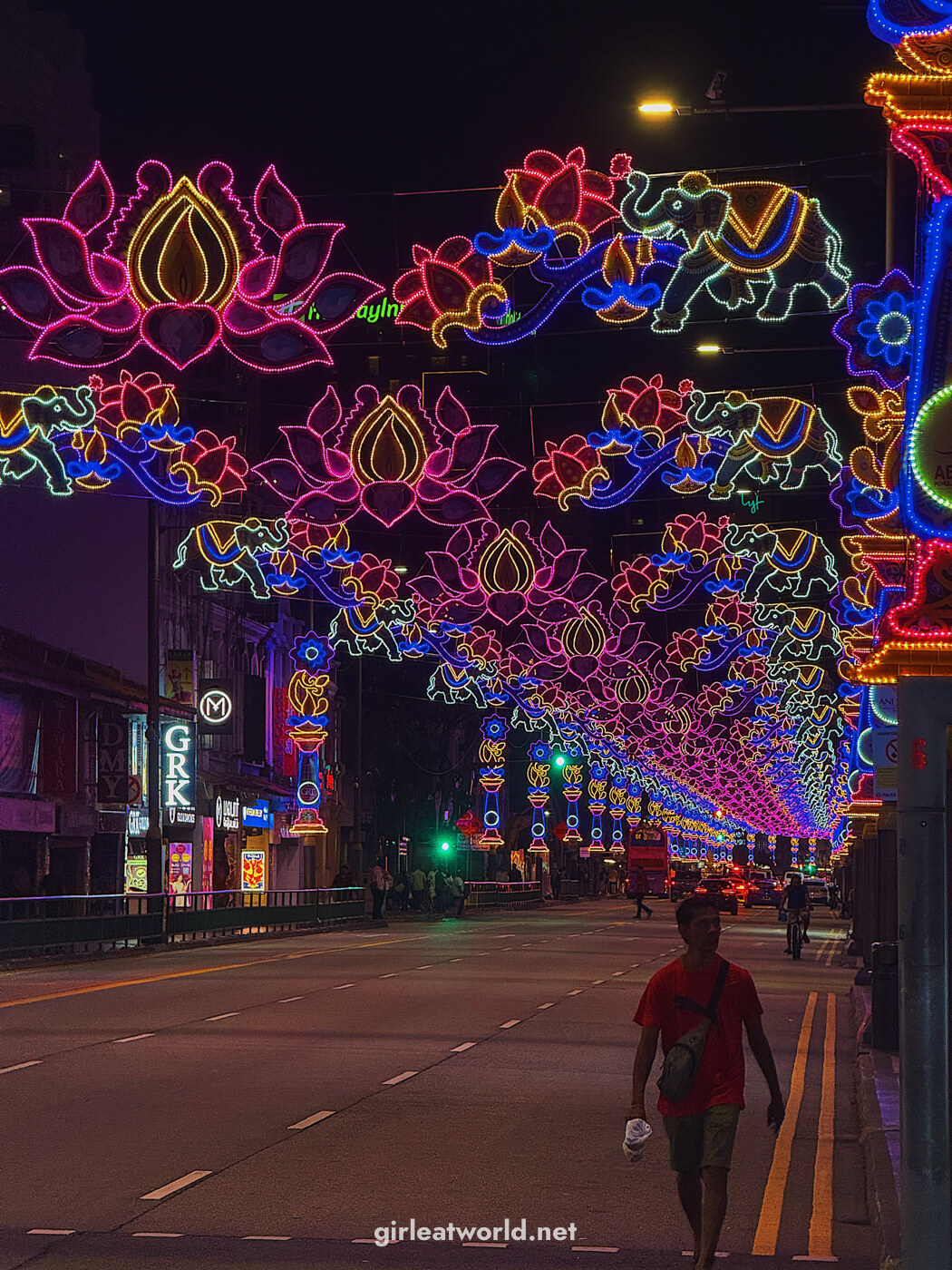
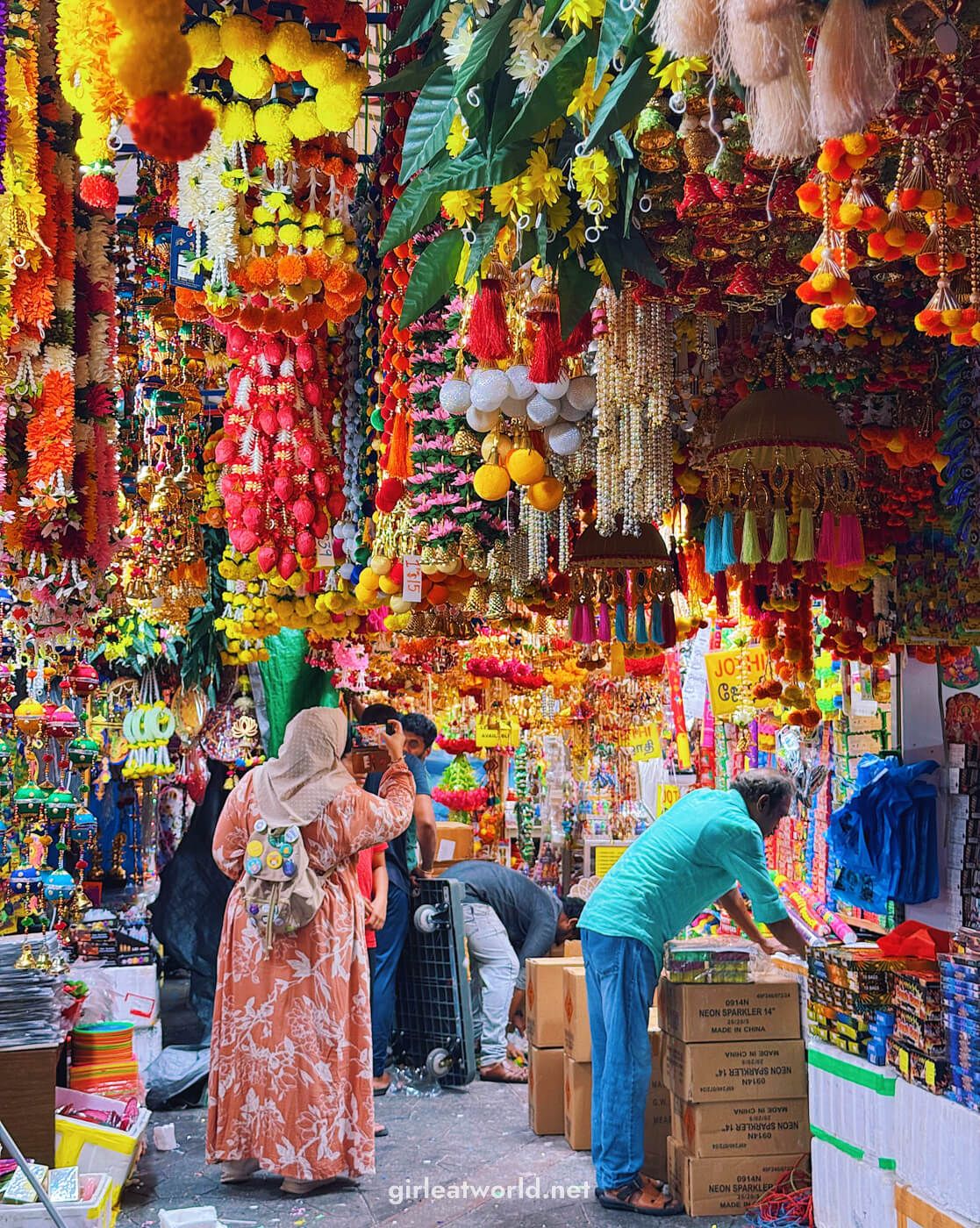
At the end of Serangoon Road near NE7 DT12 Little India MRT station is Mustafa Center, notorious as Singapore’s craziest shopping experience that you probably won’t find elsewhere in the world. Basically, Singapore locals and expats alike regard Mustafa Center as this magical, chaotic place where you can find everything and anything you can possibly dream of – from clothes to groceries, to even jewelry and furniture. The layout of Mustafa isn’t the most organized or logical, so just be mentally prepared before you get in.
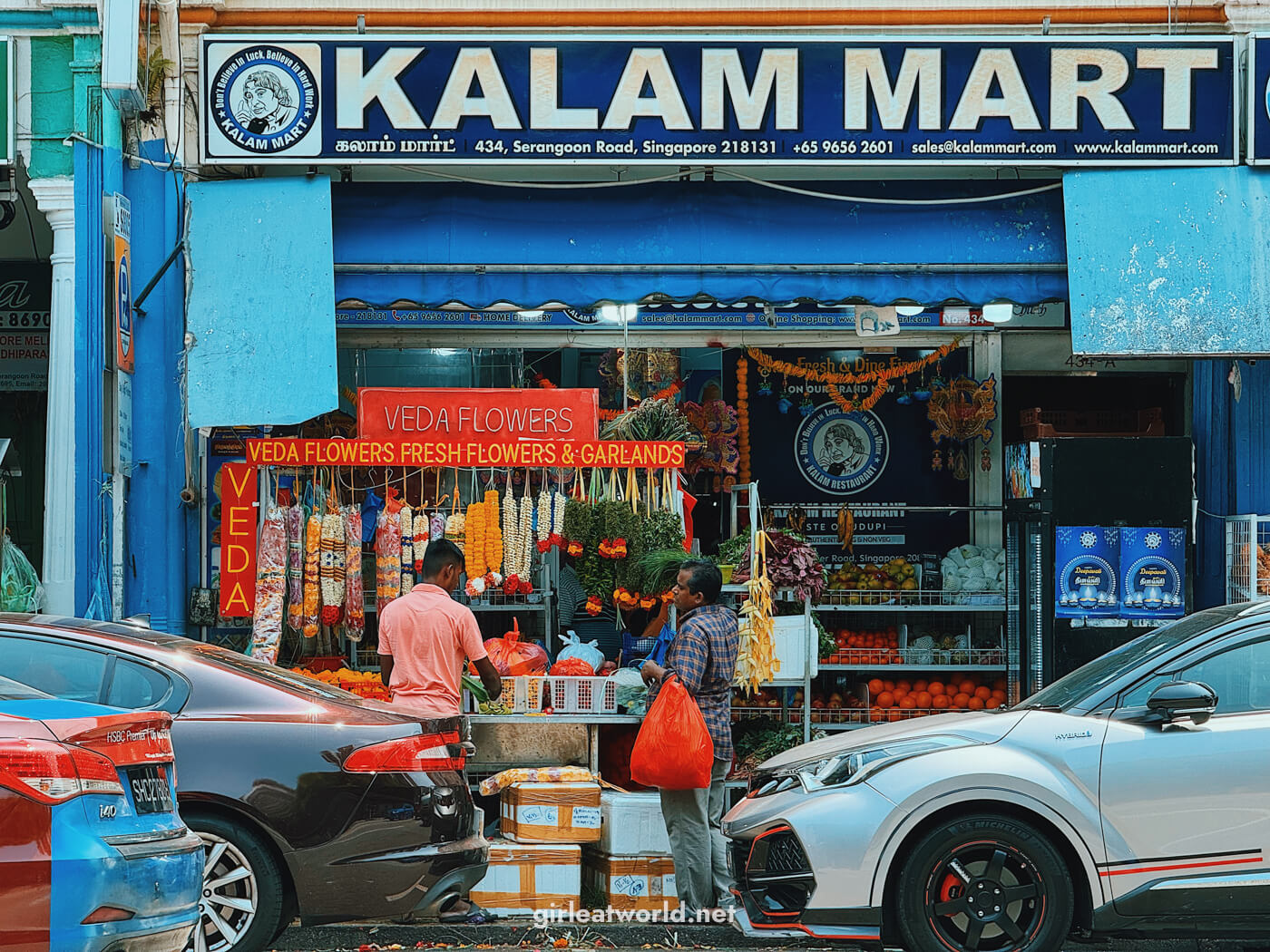
From Little India or Farrer Park, take the MRT to EW12 DT14 Bugis MRT for your next destination.
3. Visit Kampong Glam
Kampong Glam was home to Malay royalties back in the 1800s. Since 1989, it has become one of the conservation areas in Singapore.
From EW12 DT14 Bugis MRT , make your way to Haji Lane, an artsy alley filled with colorful murals, local indie brands in shophouses, and trendy cafes. In the past 10 years, it has slowly become more vibrant and more trendy – definitely popular on Instagram these days.

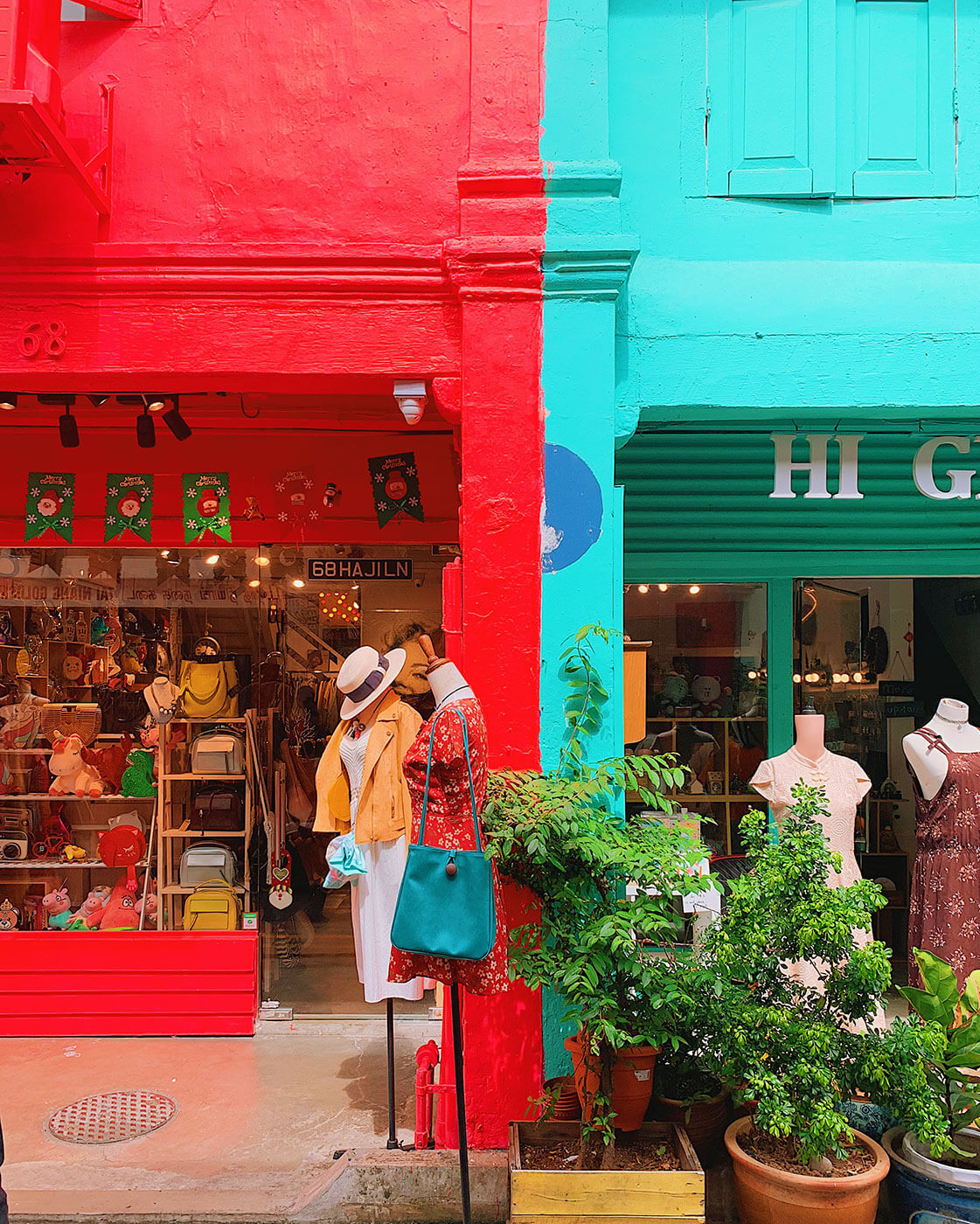
Go one street over from Haji Lane to Arab Street where you’ll find Sultan Mosque, one of the most important mosques for the Muslim community in Singapore. In front of the Sultan Mosque, you’ll find rows of Middle Eastern restaurants.
It used to be that you can relax and smoke shisha here, but shisha has been banned for imports into Singapore since 2016. So nowadays, you can just find good Middle Eastern food and some live entertainment here at night on weekends.
If you are in Singapore during the Ramadan month, you might want to come back here at night. Ramadan is the holy month when Muslims celebrate by fasting, and they break their fast around sunset. There will be food markets in this area around the time of breaking fast. Check the Singapore Events Calendar here.
On your way out of the Kampong Glam area, if architecture is your interest, you will want to stop by Parkview Square which has been colloquially referred to as the “Gotham Building” by Singaporean residents. Once you see the building, you’ll know why – Parkview Square is grandly decorated in Art Deco style, a stark comparison to the usual modern architecture style you’ll find in Singapore. You can also find a few Dali sculptures in the courtyard to make this place even more visit-worthy.
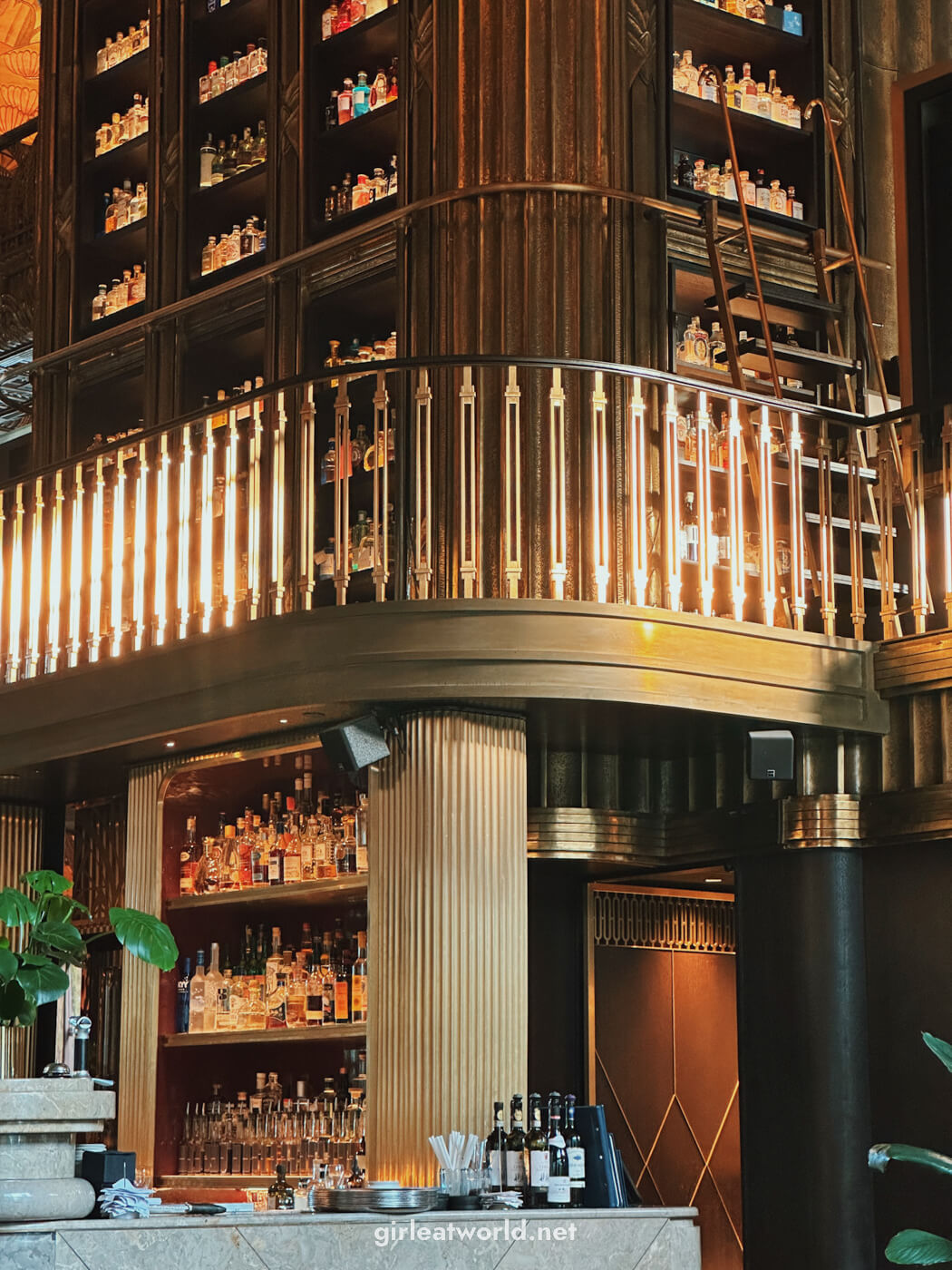
At the lobby of Parkview Square is Atlas, a grand art deco bar where you can have cocktails or afternoon tea. This bar is very popular and you might need reservations well in advance – you can try your luck at reserving a spot here.
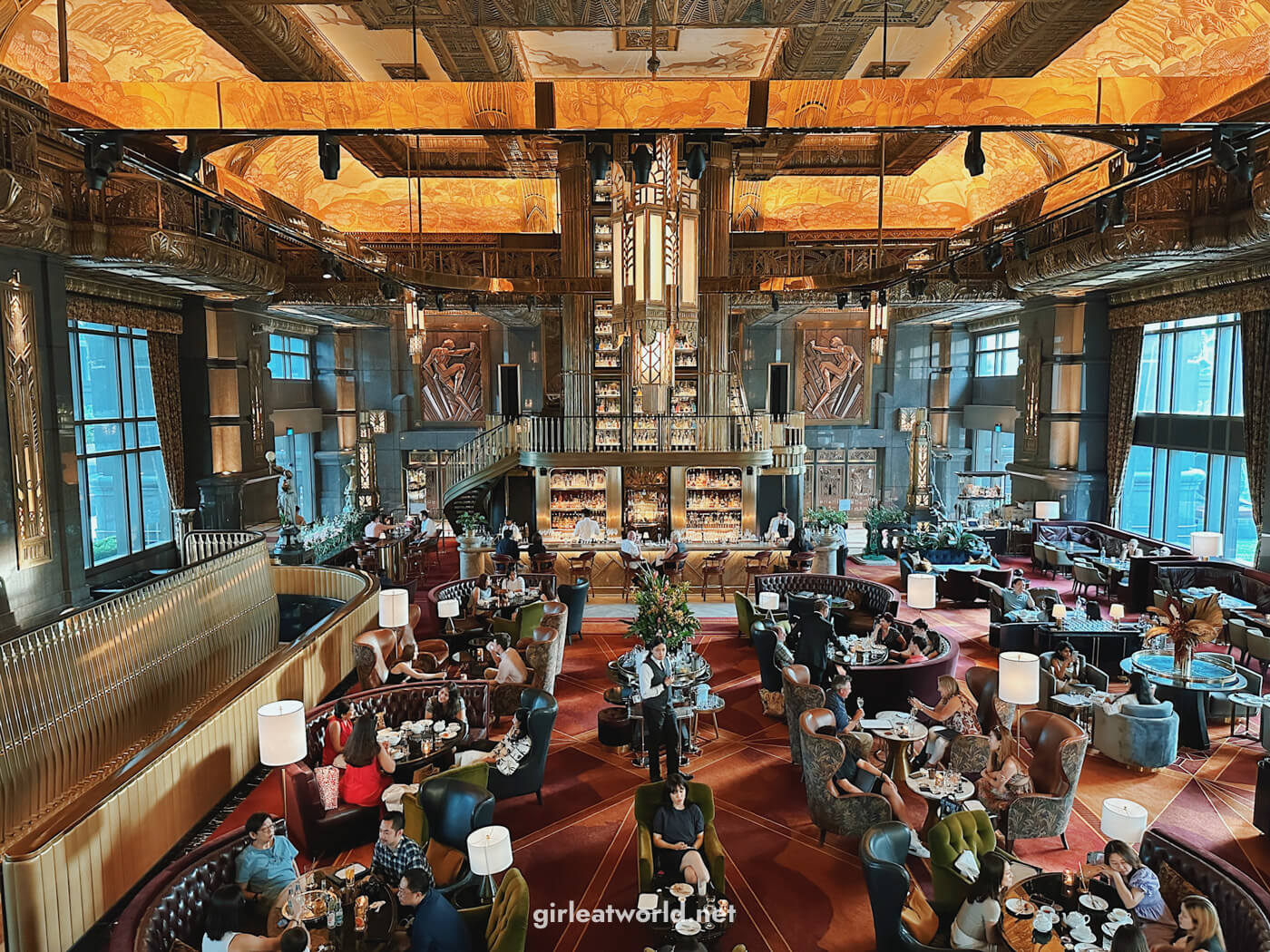
At the end of the bar is a tall shelf of gin that spans over the entire lobby level. If you’re lucky, you might even spot a gin fairy getting a bottle from the top shelf!
4. Walk Around Katong and Joo Chiat Road
Next, you can make your way to the eastern part of Singapore. From Bugis, you can take the green line to EW7 DT14 Eunos MRT . Alternatively, you can take Bus 48 which will drop you directly in the middle of Joo Chiat Road. Remember to tap out when you get off!
To locals, the east has always been known as the cooler part of the city. Not only does it have everything from famous local food, to cool cafes and trendy restaurants, but it is also rich in history. There are many well-preserved Peranakan shophouses in the Katong area.
What is Peranakan? In Indonesian and Malay language, anak means children or descendants. In Singapore, it is understood that Peranakan is referring to an ethnic group created from a mix of Chinese ancestry from immigrants with local Malay and Indonesian. You’ll often come across the term Baba-Nyonya in Peranakan culture. Baba is used for males while Nyonya refers to females.
To get a better sense of the Peranakan culture, you can consider visiting the following museums with private tours. They MUST be booked ahead of time!
- The Intan Peranakan Museum – Private museum
- Straits Enclave – Minimum 4 to book
- Katong Antique House – Book your appointment by calling 6345 8544 or email [email protected]
You can visit the Koon Seng Shophouses which can be viewed for free. Though there are many shophouses in this neighborhood, the ones on Koon Seng are famous as it is the most well-preserved and colorful. When visiting, please keep in mind it is still residential, which means someone is living inside each one of those houses!
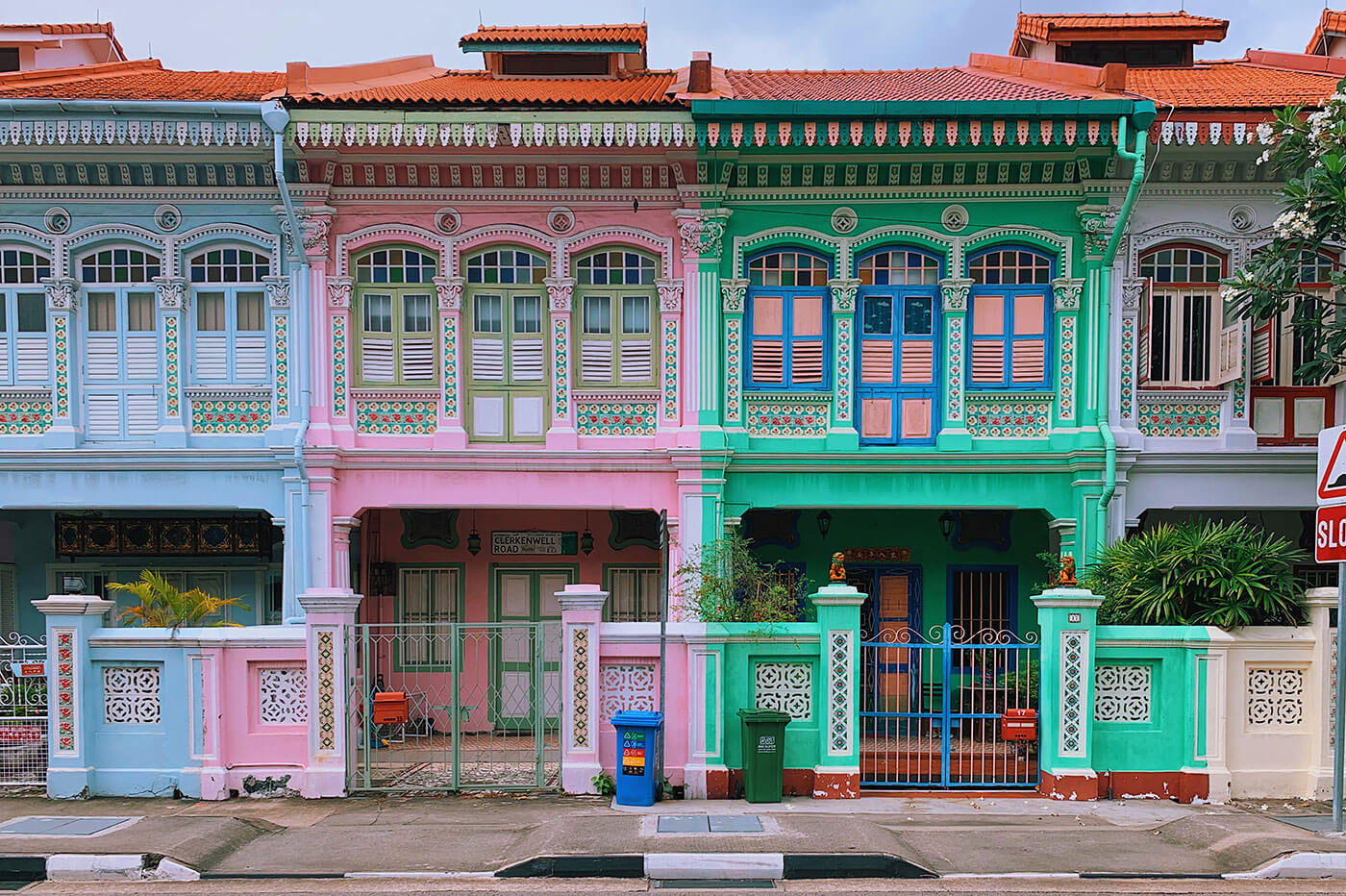
You can also stop by Rumah Bebe (Closed Mon-Wed) to sample Peranakan cuisine. You don’t have to stop by for a full meal, you can also just have some traditional Nyonya kueh (cakes) or tea. You’ll often find pandan, coconut and gula melaka (palm sugar) used in Nyonya kueh.
Another option for Nyonya kueh is next door at Kim Choo Kueh Chang. I recommend trying Ang Ku Kueh, Kueh Lapis, Kueh Dadar, or Ondeh-ondeh.
From there, you can walk along Joo Chiat Road, which houses the cool cafes and trendy shops in the neighborhood. Aside of that, the road is also known for housing some of the best Vietnamese food in Singapore. I recommend stopping by:
- A Vintage Tale
- Crane Living
- RetroCrates
- Banh Mi 233
- Long Phung
- Joo Chiat Caphe
- Humble Origins Coffee Roasters
To end the day, you could stop by Haig Road Putu Piring, which was featured on Netflix’s “Street Food” show for its traditional Putu Piring dessert.
Day 3: Singapore The Garden City
Lee Kwan Yew, Singapore’s founding father, unveiled his vision to turn Singapore into a garden city in 1967 – two years after its independence. He wanted to transform Singapore into a city with abundant lush greenery and a clean environment in order to make life more pleasant for Singaporeans.
Fast forward nearly 60 years later, you can see the vision coming to fruition. So today, we will be visiting some of the places that best showcase Singapore as a garden city.
This itinerary is good for those of you who love being outdoors and appreciate nature. You will be outside for a good part of the day, so don’t forget to bring your water bottle and hats! If you’re not keen, feel free to skip this itinerary.
Following the itinerary below, your day might look like this:
| 8:30 AM | Breakfast at Cluny Court |
| 9:00 AM | Singapore Botanic Gardens from Bukit Timah Gate |
| 10:30 AM | National Orchid Garden |
| 12:00 PM | Lunch at Gardens By The Bay |
| 12:30 PM | Cloud Forest |
| 14:00 PM | Flower Dome |
| 15:30 PM | Floral Fantasy |
| 16:00 PM | Cycle to east coast park |
| 17:30 PM | Sunset at East Coast Park |
| 19:00 PM | Dinner at East Coast Lagoon Food Village |
1. Singapore Botanic Garden
Singapore Botanic Garden is a UNESCO heritage site and is located within the city area, near Orchard Road. It showcases the best and most spectacular tropical flora set in a stunning landscape, and the entrance is free of charge.
Botanic Gardens is mostly outdoors with almost no shelter, so take that into account and plan your visit accordingly. This is why I recommend heading out here early in the morning, before it gets too hot.
For those of you who are keen on an easy walk along the entire park, you can start by taking the MRT and getting off at the CC19 DT9 Botanic Gardens station. If you have not had breakfast yet, you’ll be able to find some cafes in Cluny Court across the street from the train station. Then, you can make your way into the garden via the Bukit Timah Gate on Cluny Park Road. You’ll be able to walk down south towards Tanglin Gate.
But If you are short on time or don’t really want to walk around the park, I do recommend coming from the TE12 Napier MRT instead. Many of the attractions to see at the Botanic Garden are in the southern part of the park, closer to the Tanglin Gate on Cluny Road.
Some notable things to see at the Botanic Garden are the National Orchid Garden, Swan Lake, and the Learning Forest. While most things in the garden are free, the National Orchid Garden has an admission fee of SG$ 15 per adult.
Once you’re done exploring the garden, head to TE12 Napier MRT and head towards TE22 Gardens by the bay
2. Gardens by the Bay
Gardens by The Bay is a nature park near downtown Singapore. Here are some recommendations of things to check out here:
- Cloud Forest and Flower Dome
- Floral Fantasy
- Supertree
➡️ You can purchase tickets to Gardens By the Bay here
The good news? Most of the attractions here are indoors and in a temperature-controlled climate, which will provide a much-needed respite from the hot and humid weather outside.
1. Cloud Forest and Flower Dome
Cloud Forest and Flower Dome are great attractions for both adults and children. The reason why I’m grouping them together is that they are located right across from each other, and often visited together.
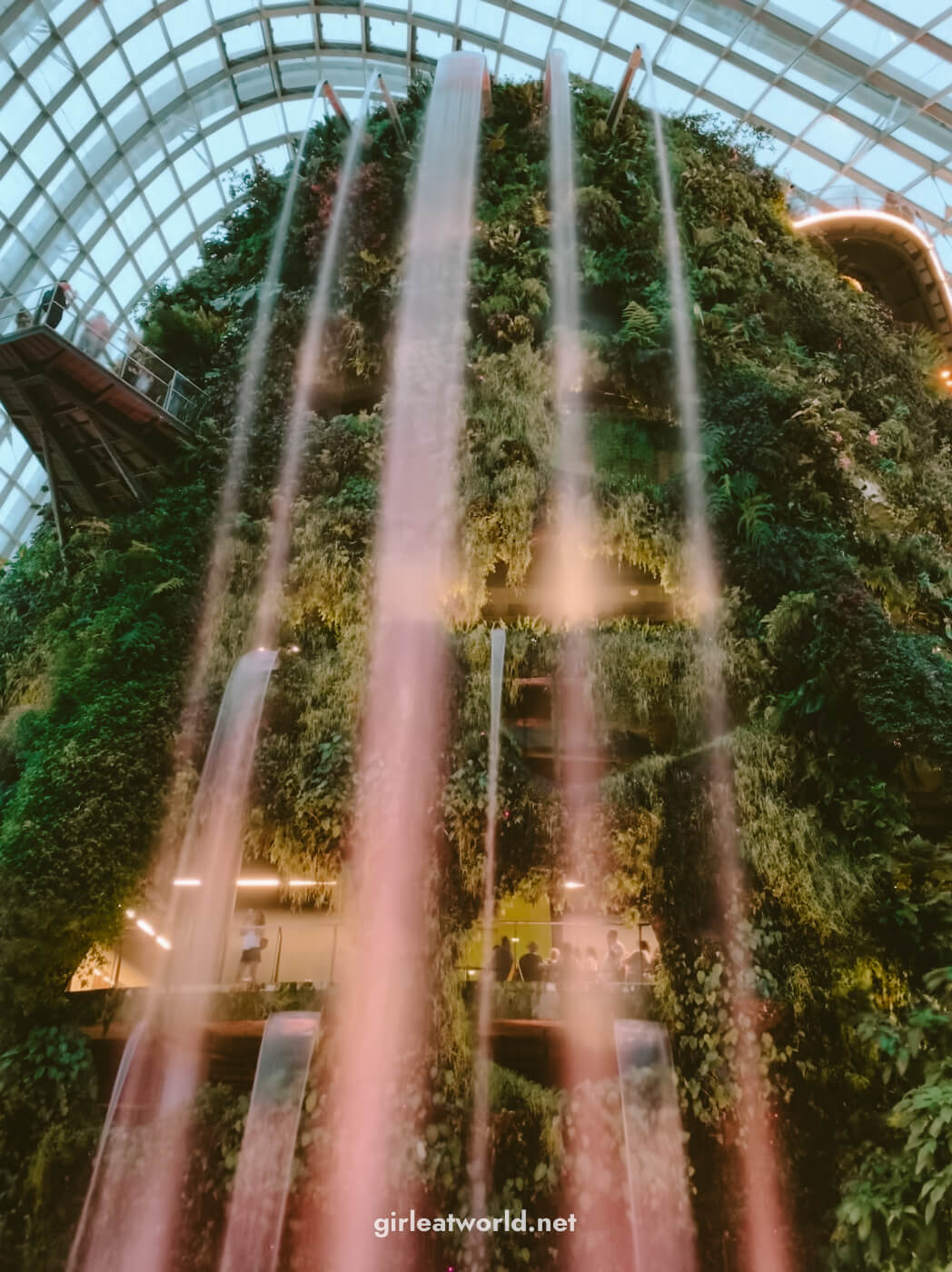
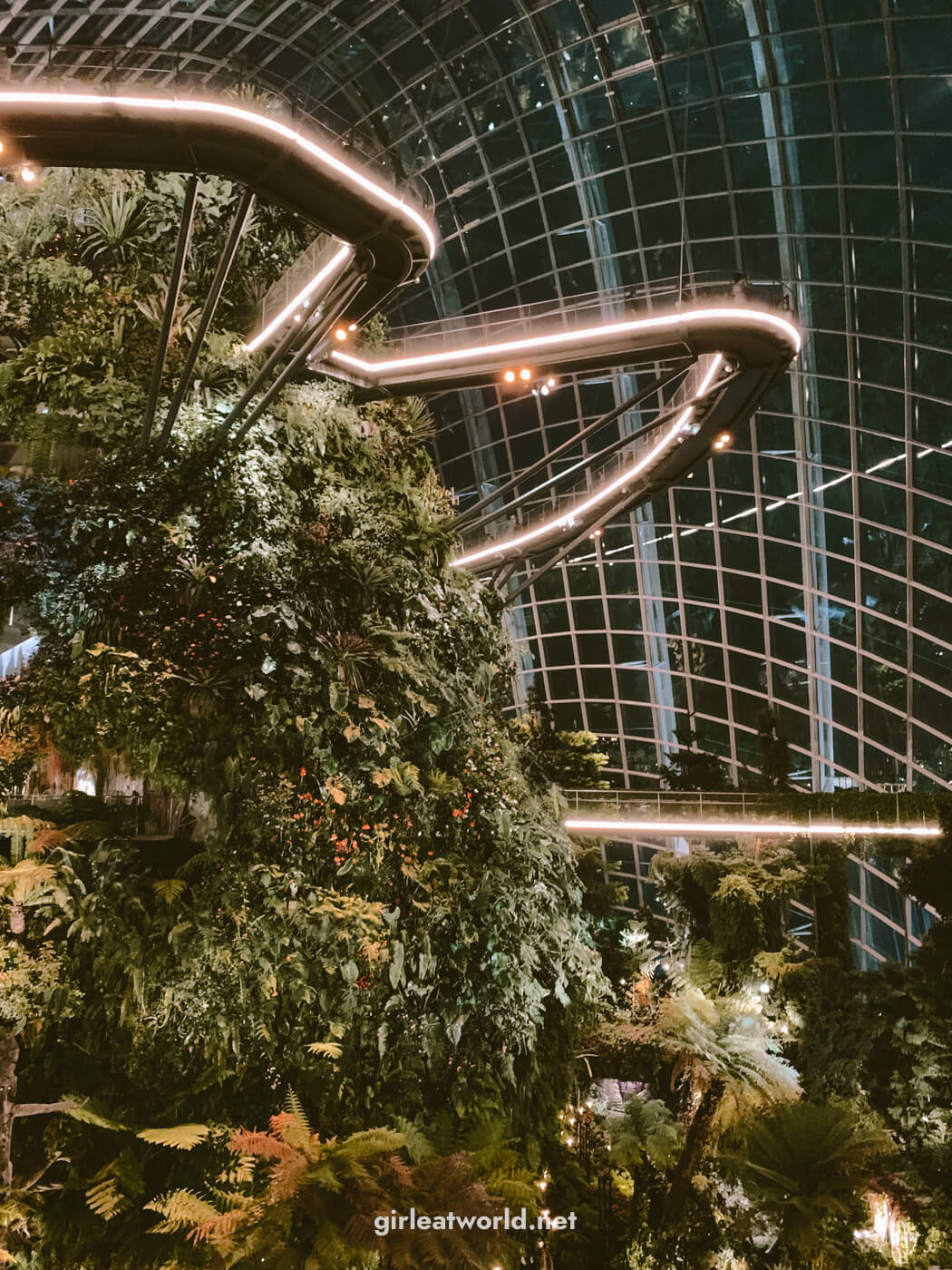
They are both enclosed, air-conditioned gardens – a welcome respite in a country as hot as Singapore. You can spend your time learning about the amazing flora and fauna from all over the world.
The estimated time to visit both Cloud Forest and Flower Dome is 3 hours.
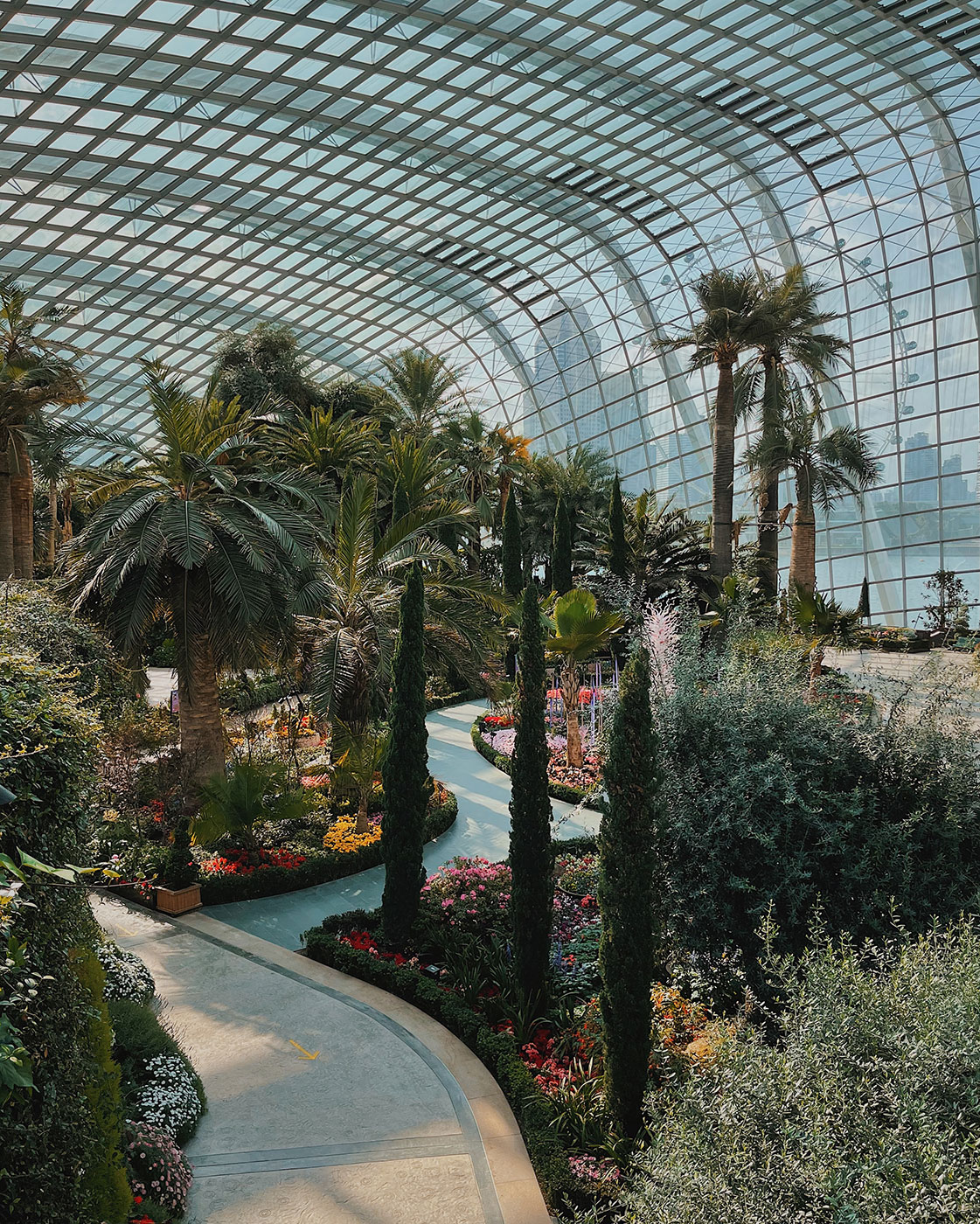
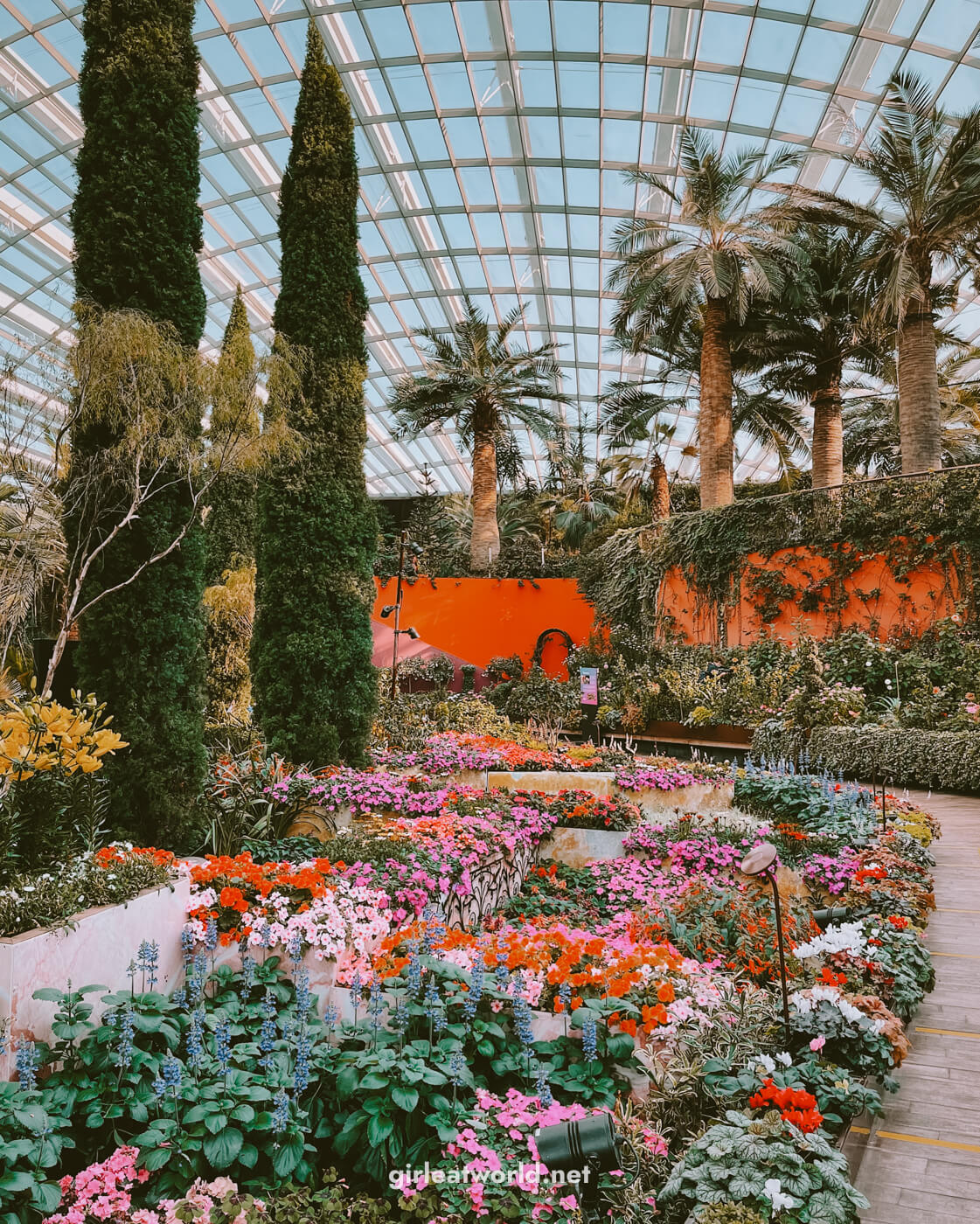
2. Floral Fantasy
Floral Fantasy is one of the newest attractions in Gardens by the Bay. Unlike Flower Dome which focuses on live flowers, Floral Fantasy features creative flower arrangements. If you love flowers, you definitely have to check this one out! Just like Cloud Forest and Flower Dome, this place is also enclosed and air-conditioned.
Plan to spend about an hour here.
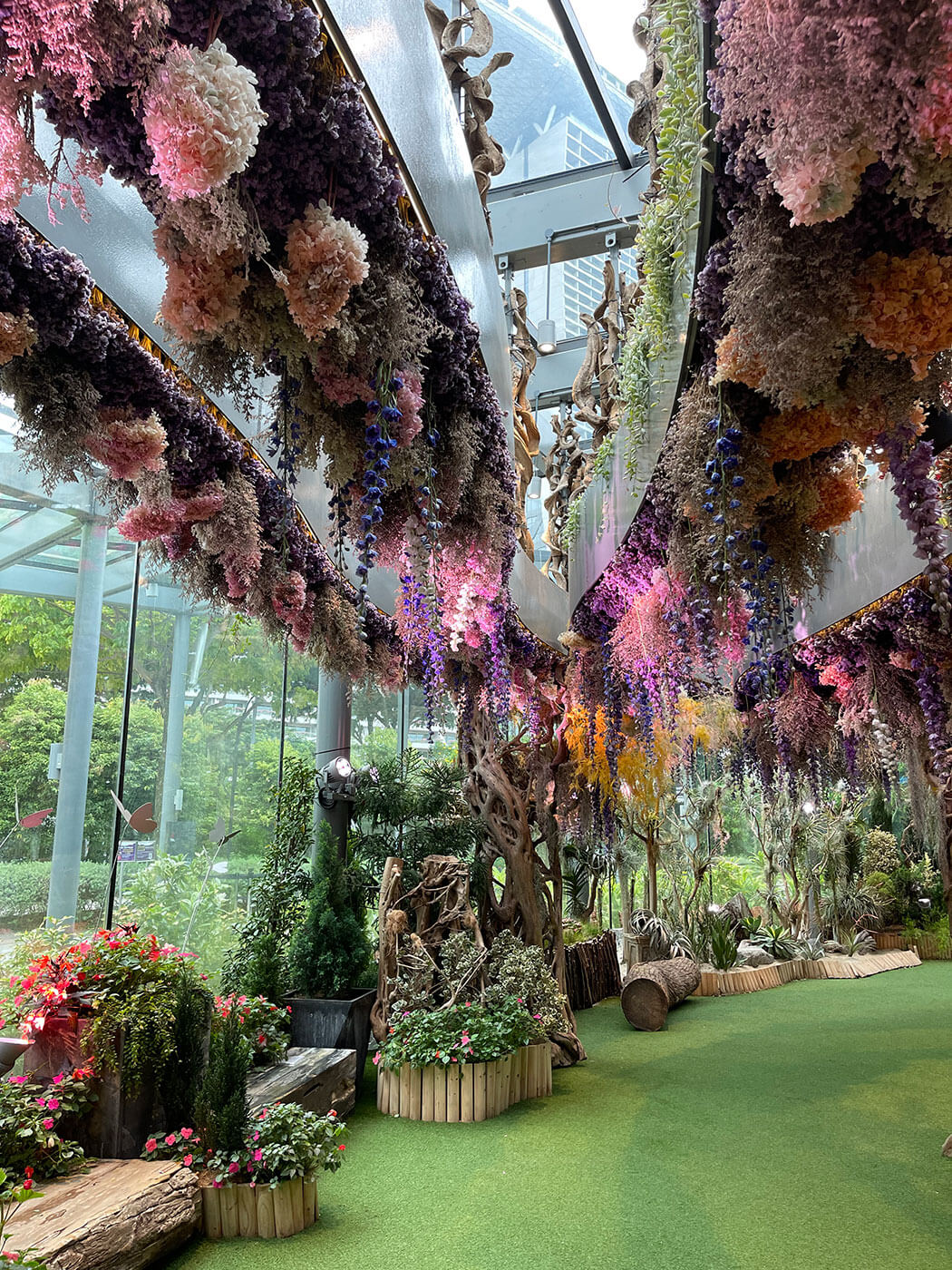
3. Cycle to the East Coast Park
If you have followed my itinerary so far, it should be late afternoon by the time you are done with Gardens by the Bay. If weather permits, it is a great time to cycle to the East Coast Park! It is quite a distance, but it is very beginner friendly and I have no doubt most people of reasonable fitness can do it.

You can start by grabbing a bike share near Marina Bay Sands and have a ride around the Marina Bay Area. Download the Anywheel app to rent the green bikes or HelloRide app for the blue bikes. Renting the bikes is quite affordable, just be sure to park the bike back at a designated parking spot for bikes.
You can start from the Marina Bay Sands area and make your way down to Gardens By The Bay, Marina Barrage, Bay East Garden, and then all the way to East Coast Park!
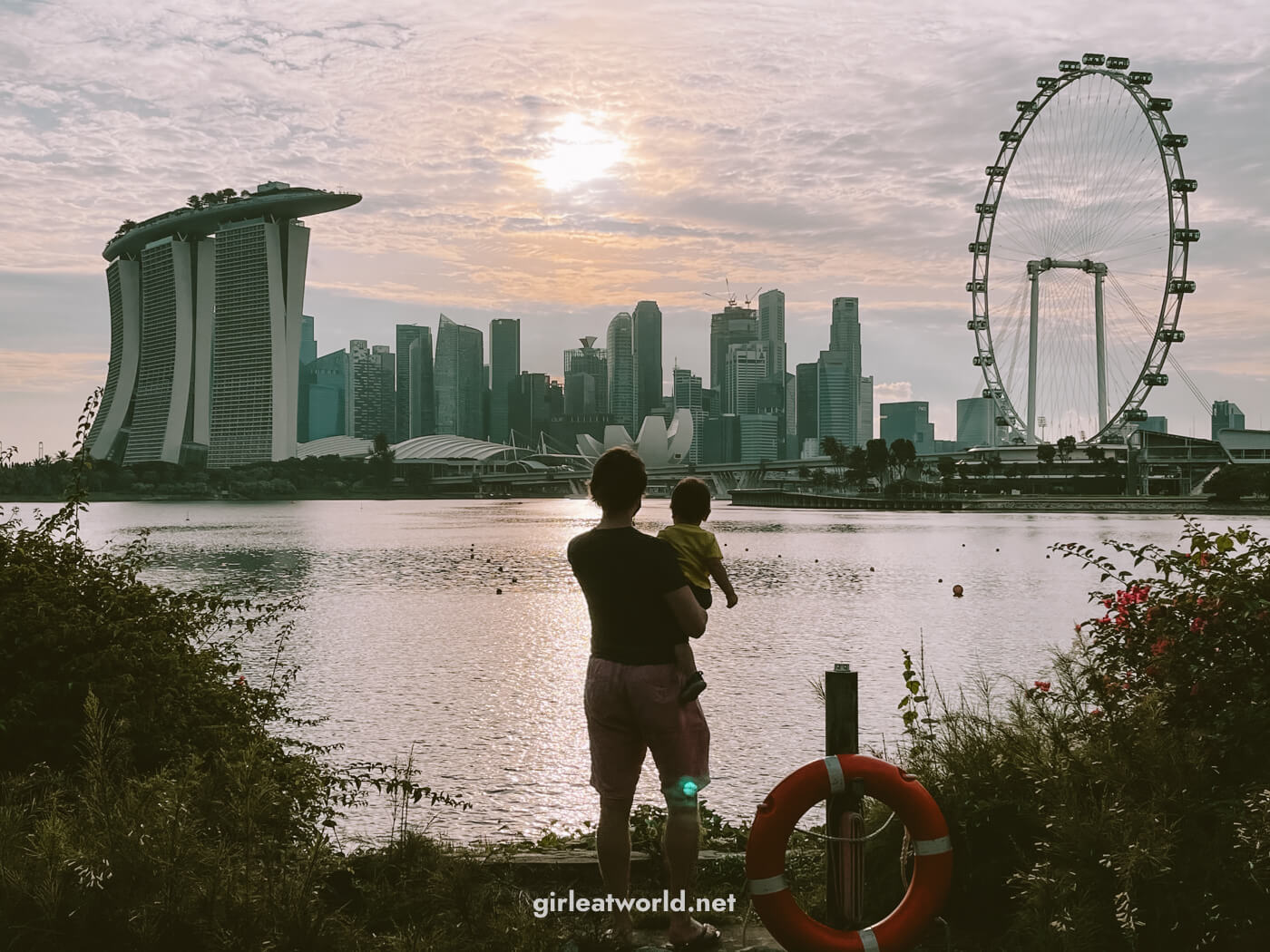
4. East Coast Park
East Coast Park is a great way to spend a morning or late afternoon, either picnicking, playing by the beach, or dipping your feet into the seawater. Bring your picnic mat, some snacks, a swimsuit, and some towels!
5. East Coast Lagoon Food Village
End your day with dinner at the East Coast Lagoon Food Village, one of the most popular hawker/food centers in Singapore. Here, you’ll get to try the affordable but good food that locals love to eat daily.
I recommend trying carrot cake (a savory dish, not dessert!), oyster omelet, Hokkien mee (noodles), and BBQ chicken wings. Read more about Singapore food here.
Day 4: Visit the Mandai Wild Reserves (Singapore Zoo)
I know, I know… visiting the zoo is not typically high on everyone’s list, but I really think this one is an exception. I have to say that the Mandai Wild Reserves in Singapore is quite special. For me, it is definitely the best zoo I have ever visited!
Mandai Wildlife Reserve currently consists of five parks with plans to add more to the park in the future. The parks are:
- Singapore Zoo
- River Wonders
- Night Safari
- Bird Paradise
- Rainforest Wild Asia (Opened in 2025)
Mandai is located in the far north of Singapore, and quite frankly it is quite away from anything else. A trip here would take up your entire day, so plan this as a whole day trip. Each park has its own admission ticket. I’ve included links to buy tickets for each of the parks below.
Get the cheapest ticket to the zoo: If you’re interested in visiting more than one park, you might be better off buying the multi-park deal or the Klook Pass Singapore. Please compare each deal as prices might change. For example, at the time of writing it is cheaper to buy adult tickets via the Klook Pass Singapore, but it’s cheaper to get child tickets via the multi-park bundle.
The parks are right next to each other, and it’s possible to visit three parks comfortably in one day. Your day could look like this:
| 09:30 AM | Park 1: Singapore Zoo |
| 12:30 PM | Lunch inside the Singapore Zoo |
| 13:00 PM | Park 1: Continue Singapore Zoo |
| 15:00 PM | Park 2: River Wonders or Bird Paradise |
| 18:30 PM | Dinner at the Park Entrance or Mandai Wildlife West |
| 19:15 PM | Park 3: Night Safari |
You MIGHT be able to visit all 4 parks if you start your day very early (basically be at the zoo when the door opens). It will be quite rushed, but it’s possible. I would recommend timing it as such:
| 08:30 AM | Park 1: Singapore Zoo |
| 11:30 AM | Lunch at the zoo |
| 12:30 PM | Park 2: River Wonders |
| 15:30 PM | Park 3: Bird Paradise |
| 18:30 PM | Dinner at Mandai Wildlife West |
| 19:15 PM | Park 4: Night Safari |
And now, let’s go through each park one by one.
1. Singapore Zoo
Singapore Zoo is truly one of the best in the world. There are a lot of activities here for kids, including animal feeding and shows that happen all day long. They require a booking in advance so be sure to check the timing and book on the Mandai Reserves website.
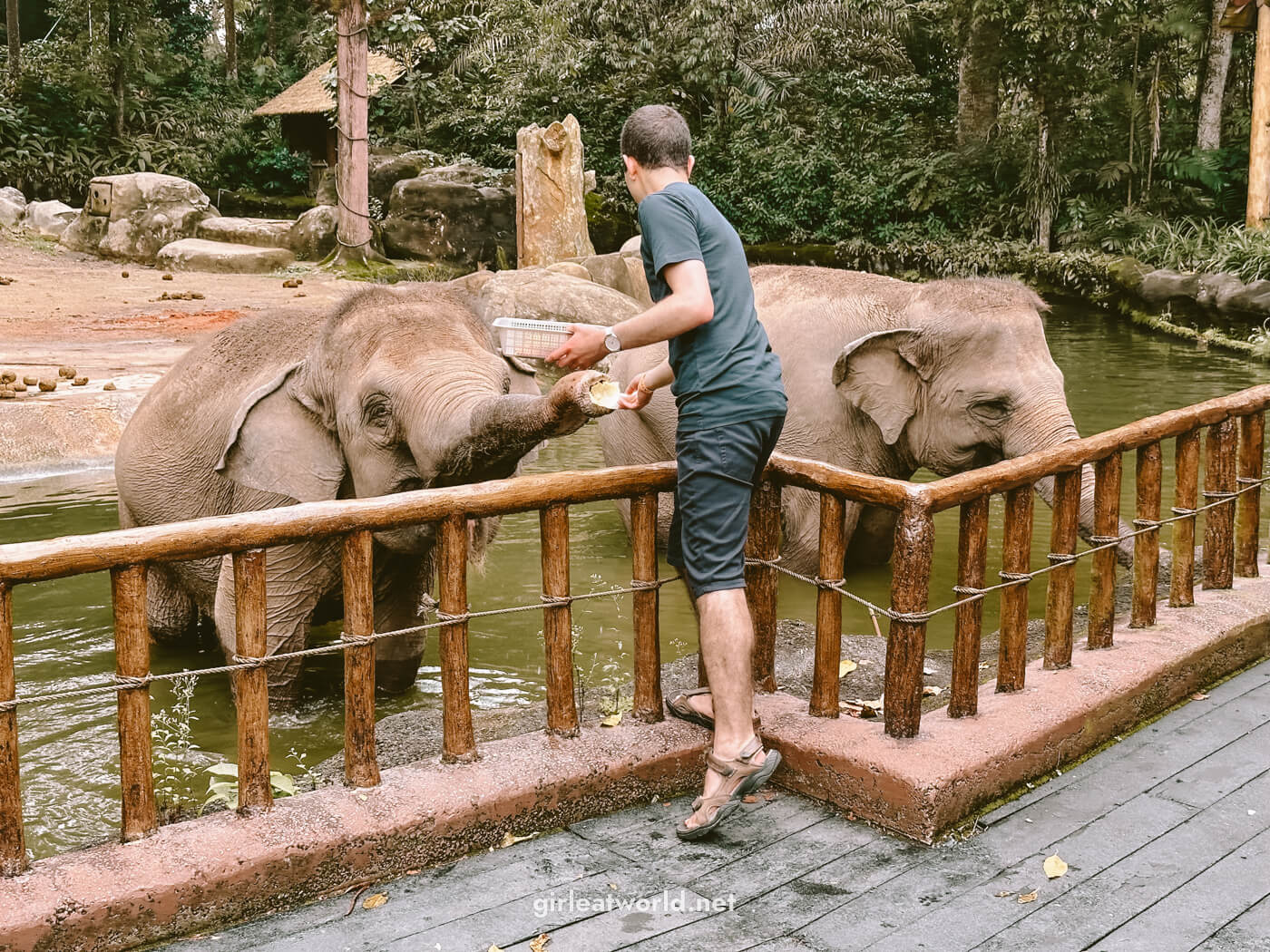
The zoo spans a large area, and you’ll need to do a lot of walking. But if you’re not a fan of walking – your admission ticket includes a tram ride, so you could minimize the walking as little as possible.
Expect to spend about 4 hours here if you want to see everything.
➡️ Book tickets to Singapore Zoo here (select Standard ticket if you’re not an SG resident)
2. River Wonders
I highly recommend River Wonders when the weather is not good because it is mostly indoors, so it’s weatherproof! You can enjoy River Wonders rain or shine. And personally, I think River Wonders is my favorite out of all the parks.
They have a cool large aquarium with manatees and large freshwater fish. They also have a panda exhibit, which at one point houses the baby panda Le Le who was born in Singapore in 2021. However, Le Le has returned to China in 2023.
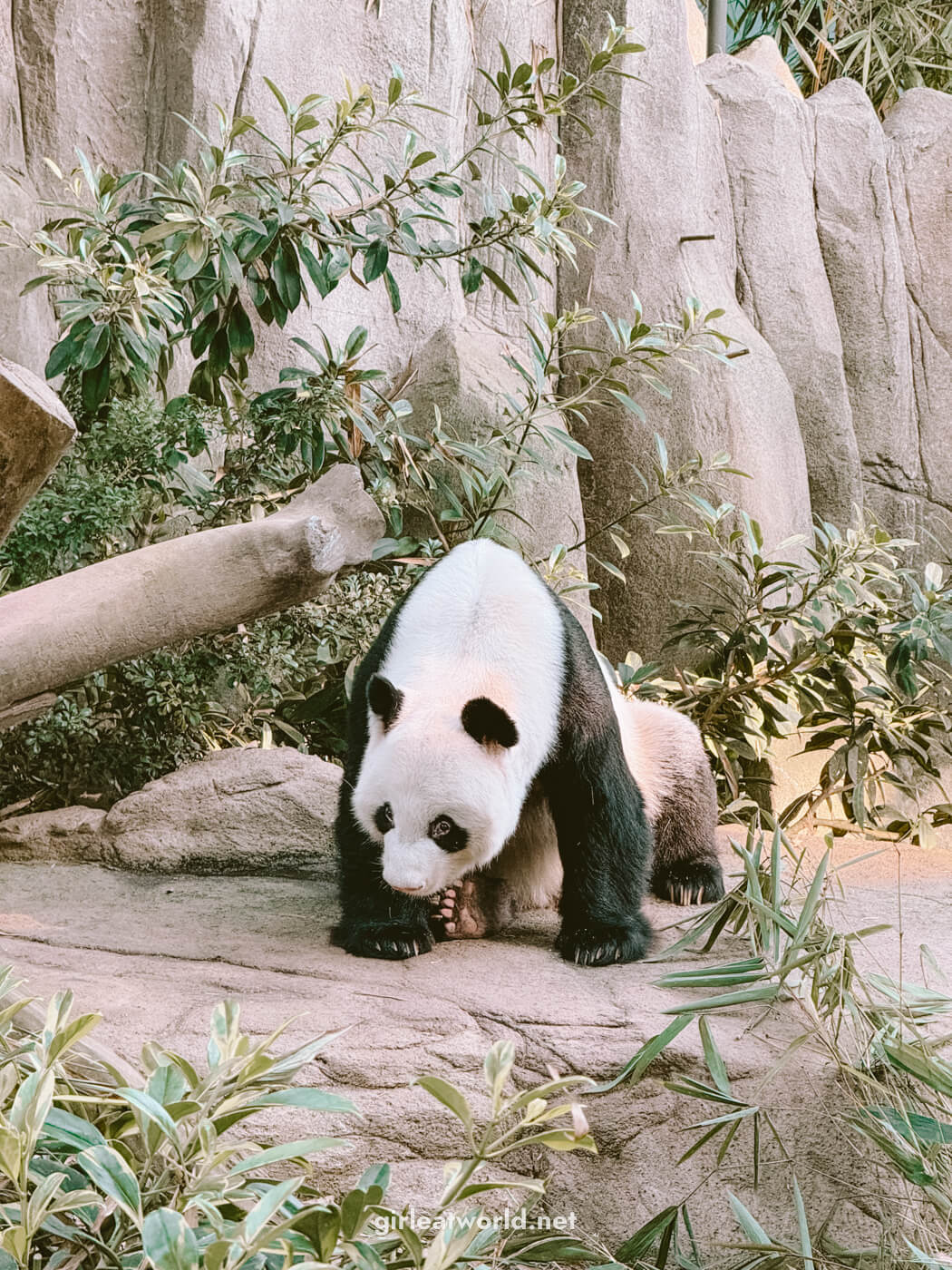
For older kids (1.06m or above in height), there is Amazon River Quest which is a boat ride where you can see the animals up close.
Expect to spend about 3 hours here.
➡️ Book tickets to River Wonders here (select Standard ticket if you’re not an SG resident)
3. Bird Paradise
Bird Paradise is the newest addition to Mandai Wild Reserves, which opened in May 2023. Before the current location, the bird park was located at Jurong Bird Park, which was operating from 1971 up until 2023.
➡️ Book tickets to Bird Paradise here (select Standard ticket if you’re not an SG resident)
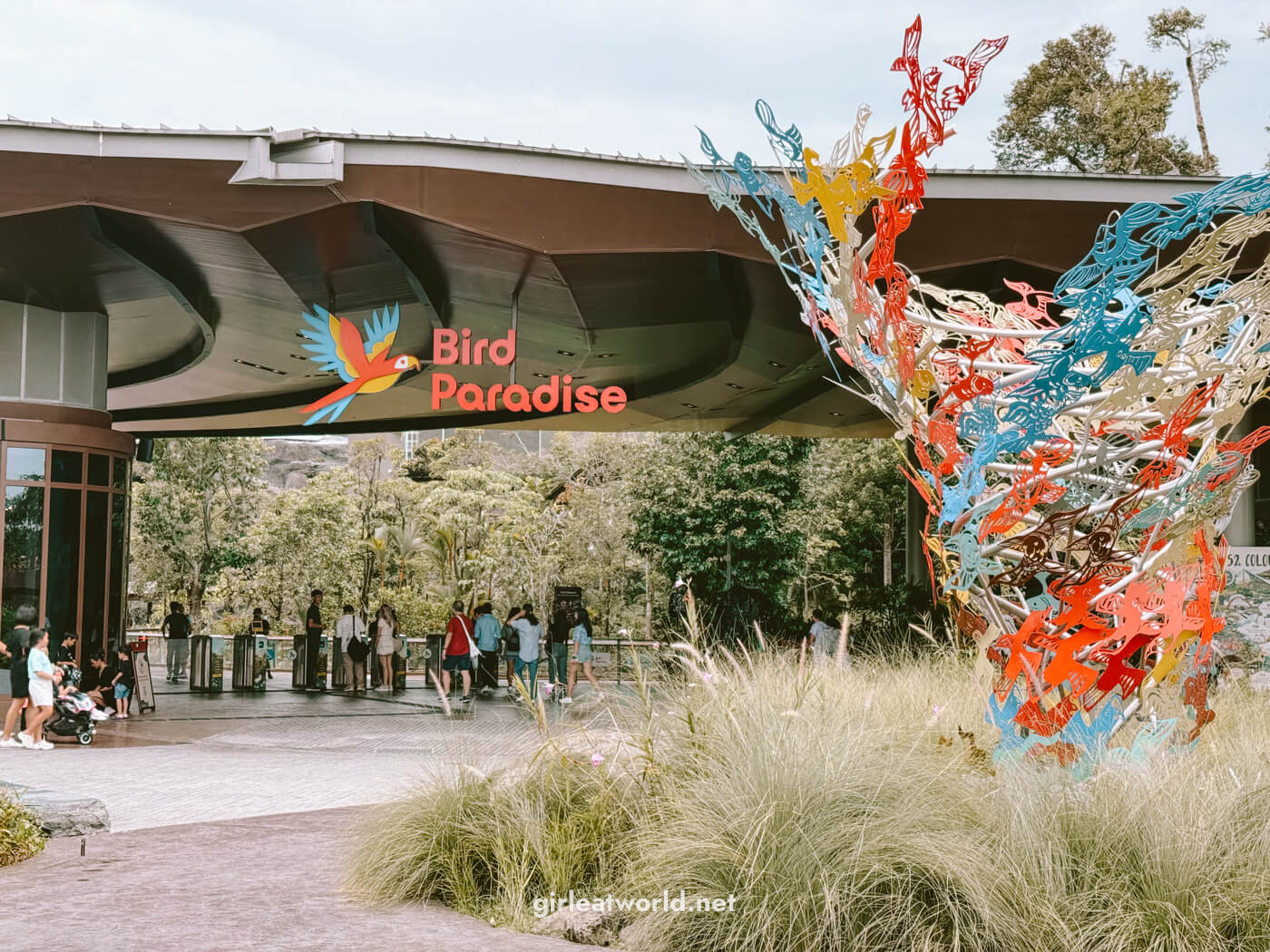
The Bird Paradise is designed such that you’re able to see birds from different parts of the world, from Asia to Africa. The birds are not caged, they are free-flying. You just have to go through a double door from each section which prevents the birds from flying outside. There is also a dedicated enclosure for penguins.
You can spend about 3 hours at the park if you want to see everything.
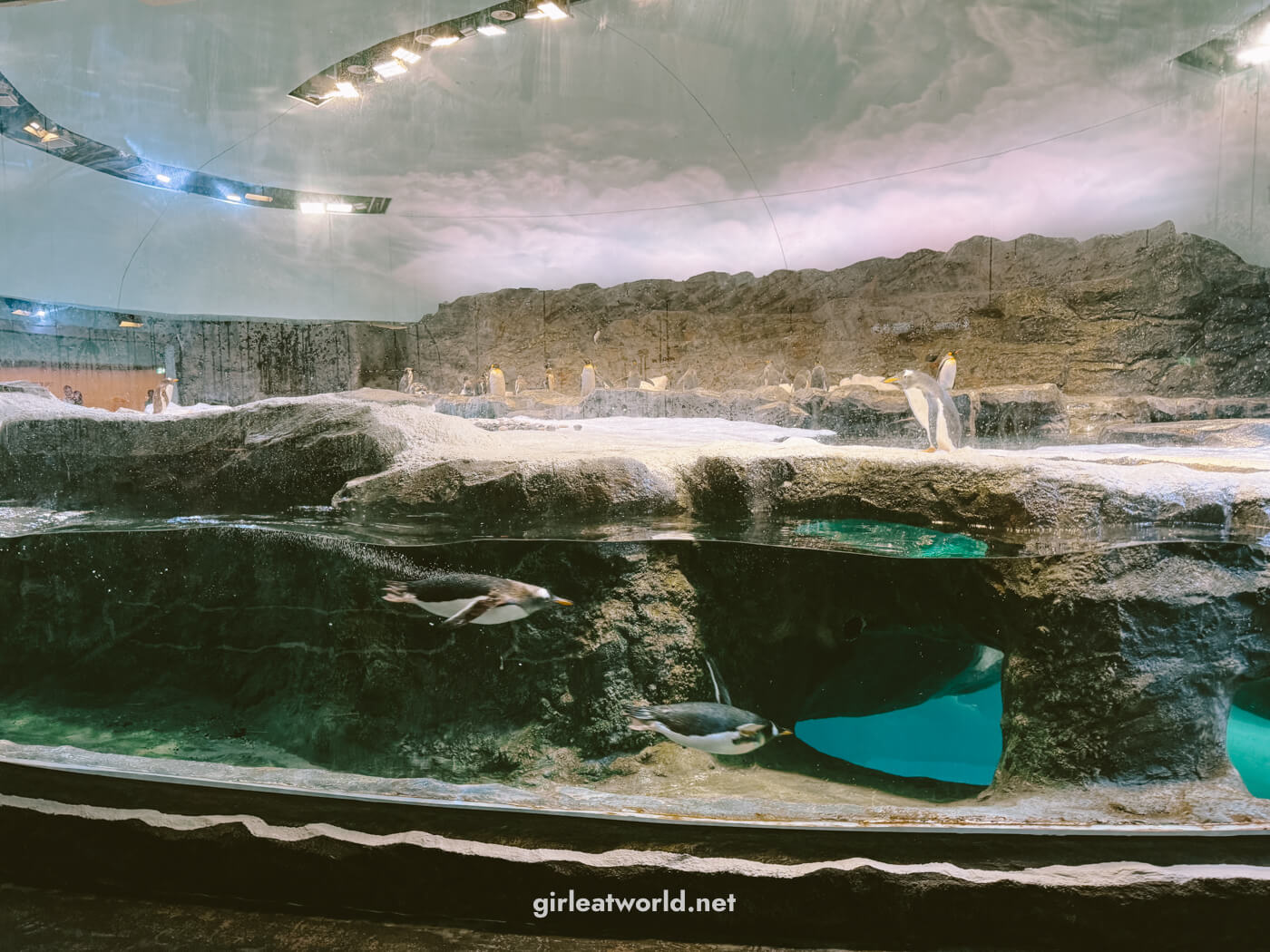
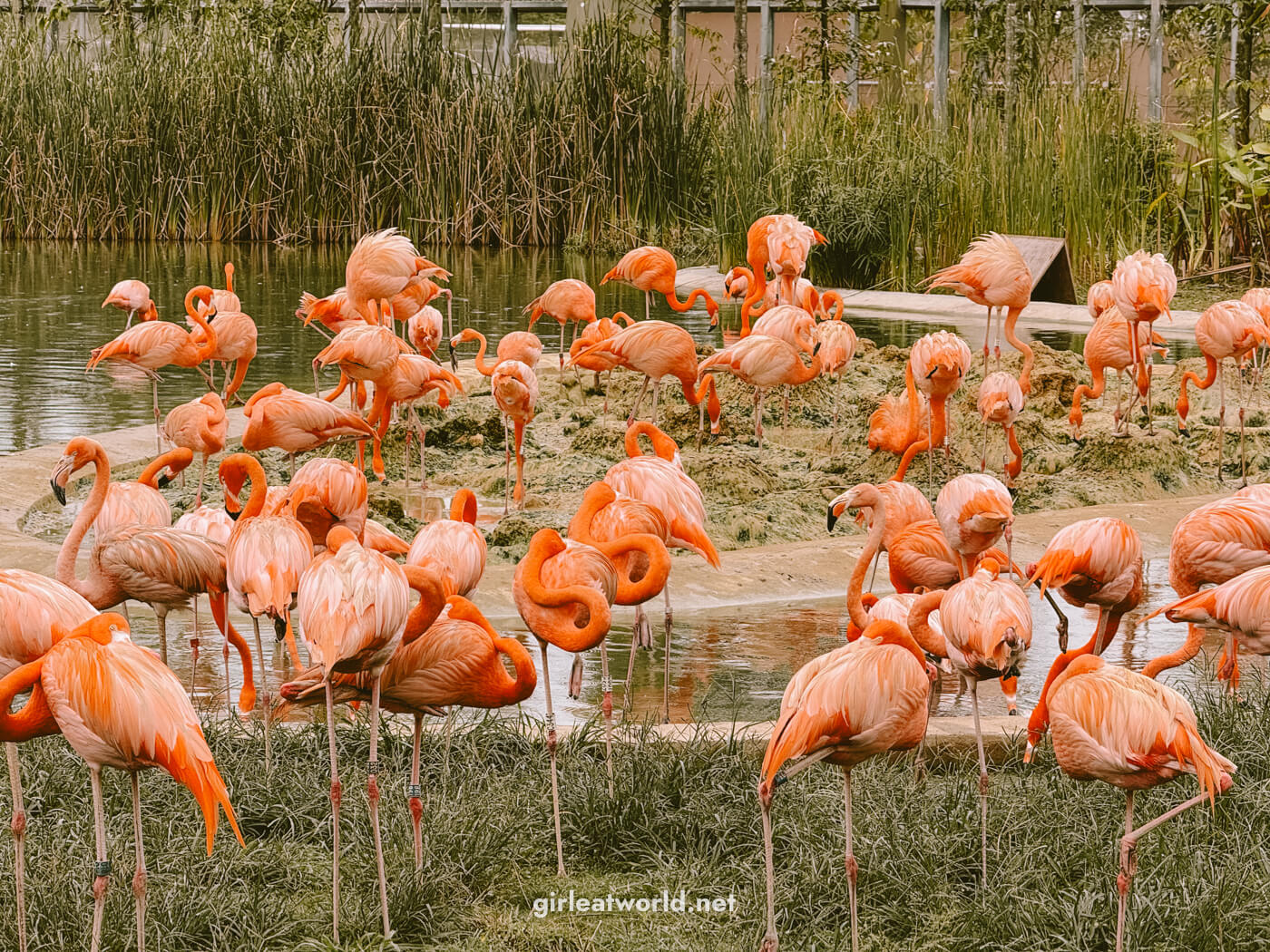
4. Night Safari
As the name suggested, the Night Safari is a night attraction and opens from 7:15 PM onward.
Book a time slot for Night Safari: While a visit to the rest of the parks does not need to be booked, it is advisable to book a time slot for Night Safari due to its popularity, especially if you’re going on a Friday or Saturday night. You can book a time slot here after you’ve bought your ticket.
You take a guided open-air tram ride to see all the animals in their nocturnal habitat. There are also trails you can walk and the Creatures of the Night show.
The Creatures of the Night Show happens twice a night at 7:30 PM and 9 PM. So you could go to the show first and then go on the tram ride, or vice versa. Make sure to book a seat for the show too!
Expect to spend about 3 hours at the Night Safari for both the tram ride and the show.
➡️ Book tickets to Night Safari here (select Standard ticket if you’re not an SG resident)
5. Rainforest Wild Asia
Rainforest Wild Asia is the fifth and newest park in Mandai Wildlife Reserve, having opened in March 2025. Like Night Safari, it is also an open concept park.
Instead of the traditional zoo experience where animals are within an enclosed area, it’s the opposite – as a visitor, YOU are the ones who kept within a designated or enclosed area. The park can be explored using elevated walkways, but from the walkway you can branch off into a trekking expedition. There are 7 forest trekking trails you can take that mimics the experience of going into a wild rainforest. The trails gives you a chance to spot animals, but it is not guaranteed.
Expect to spend about 3 hours at the Rainforest Wild Asia to explore all the trails.
➡️ Book tickets to Rainforest Wild Asia here
Day 5: More things to do in Singapore
If you still need more things to do in Singapore, here are a few recommendations I have:
1. Haw Par Villa
Haw Par Villa is a peculiar theme park located in the west of Singapore. It contains thousands of statues that depict scenes from Chinese folklore and legends, as well as demonstrating Chinese values.
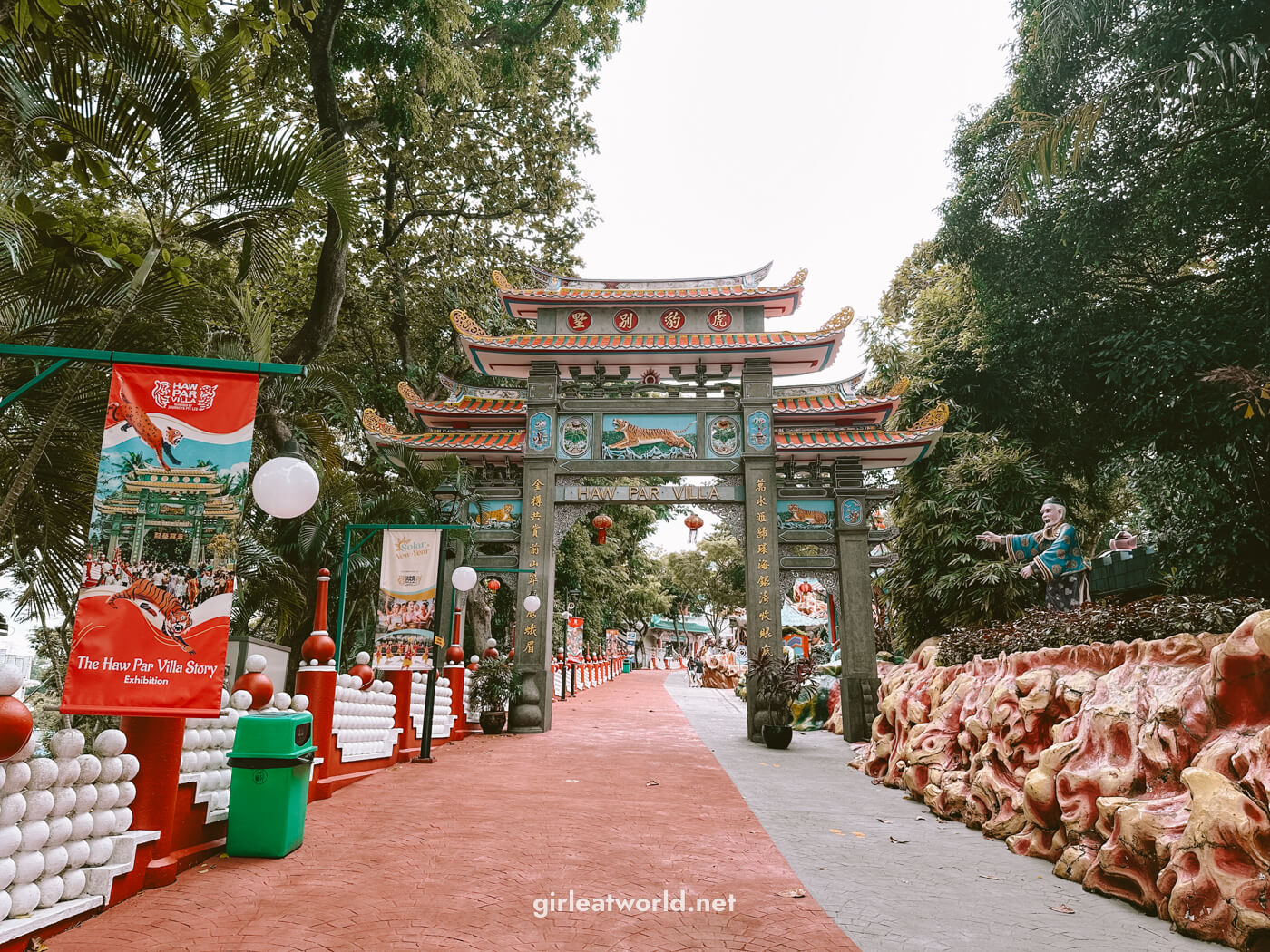
The park was initially built in 1937 by the Burmese-Chinese brothers Aw Boon Haw and Aw Boon Par, who are the creators of Tiger Balm. As such, the original name of the park was Tiger Balm Garden. Seeing the potential in the theme park, the Singapore Tourism Board took over the park and renamed it “Haw Par Villa” in 1988. The park has since gone through a few restorations, with the latest one being in 2021.
You can take the MRT to CC25 Haw Par Villa station. The park is just a short walk away.

2. Go Museum-Hopping
There are plenty of great museums in Singapore! Visiting them is subjective to your interest. I recommend checking out the following museums:
3. Sentosa Island
Sentosa is an island resort in the southern part of Singapore. To get here, you need to take the MRT to CC29 NE1 Harbourfront. Then, go up to the highest level in Vivo City to take the monorail into Sentosa.
Alternatively, for a more scenic way to travel into Sentosa, you can go to Mount Faber and take the Singapore Cable Car into Sentosa.
Book the Singapore Cable Car tickets here
In Sentosa, there are a few attractions you might want to enjoy: Singapore Oceanarium (newly renovated in 2025) and Universal Studios Singapore (often referred to as USS) are the most famous ones.
For the history of Sentosa, you can head to Fort Siloso and check out the guided tour and a scenic trail at Fort Siloso Skywalk.
4. Jewel Changi Airport
On your way out of Singapore, set aside some time to explore Jewel at Changi Airport. It features an impressive indoor waterfall and garden as well as a long list of retail shops and good restaurants. You won’t be bored here. Jewel can be accessed quite easily from Changi Airport.
Click here to find out more about Jewel Changi Airport.
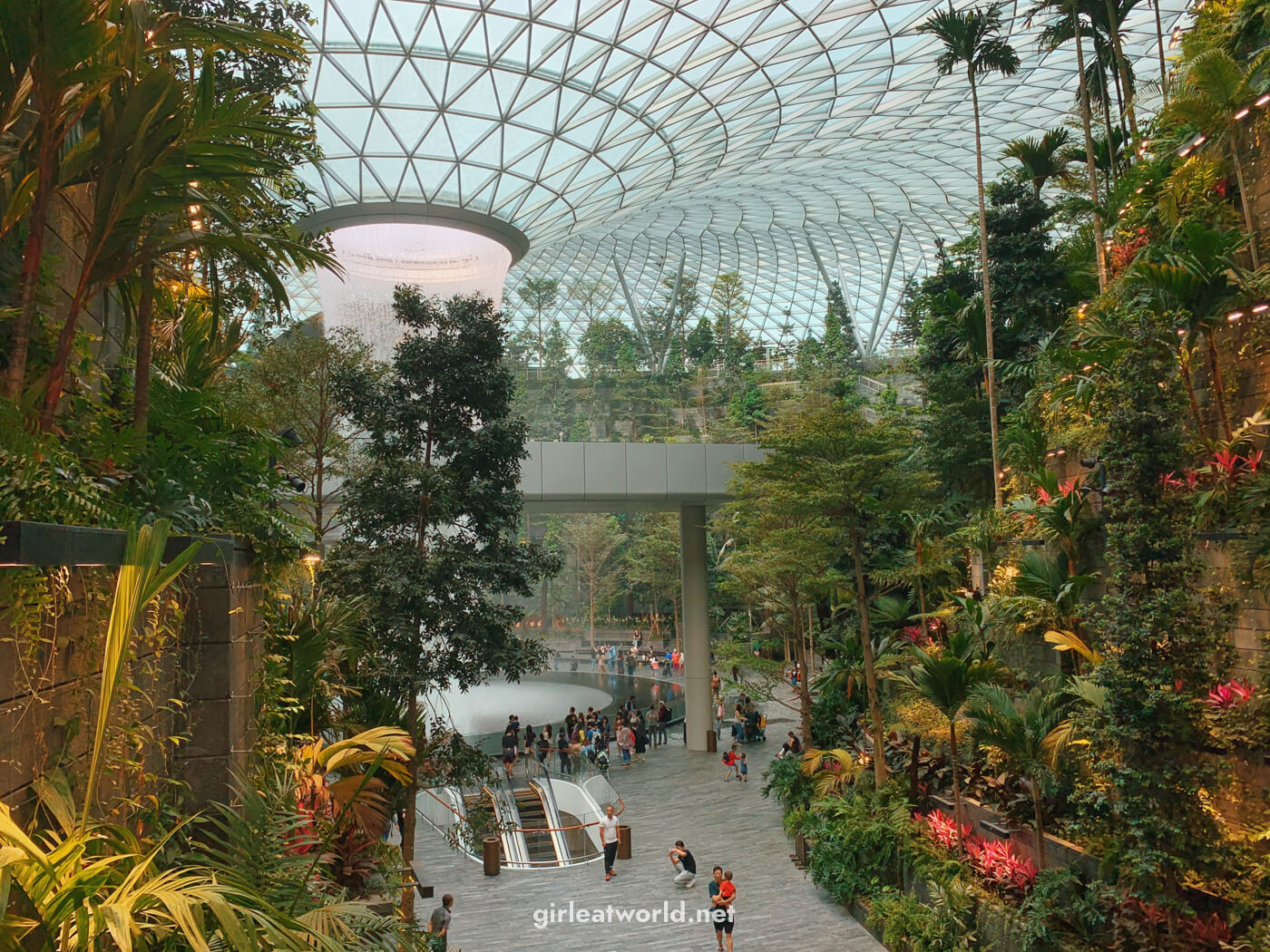
Short Getaway from Singapore
Tired of the city life? One of the advantages of being in Singapore is its proximity to a myriad of exotic getaways that can be easily reached in just a few hours for a reasonable price.
You can view my round up of quick getaway from Singapore here.
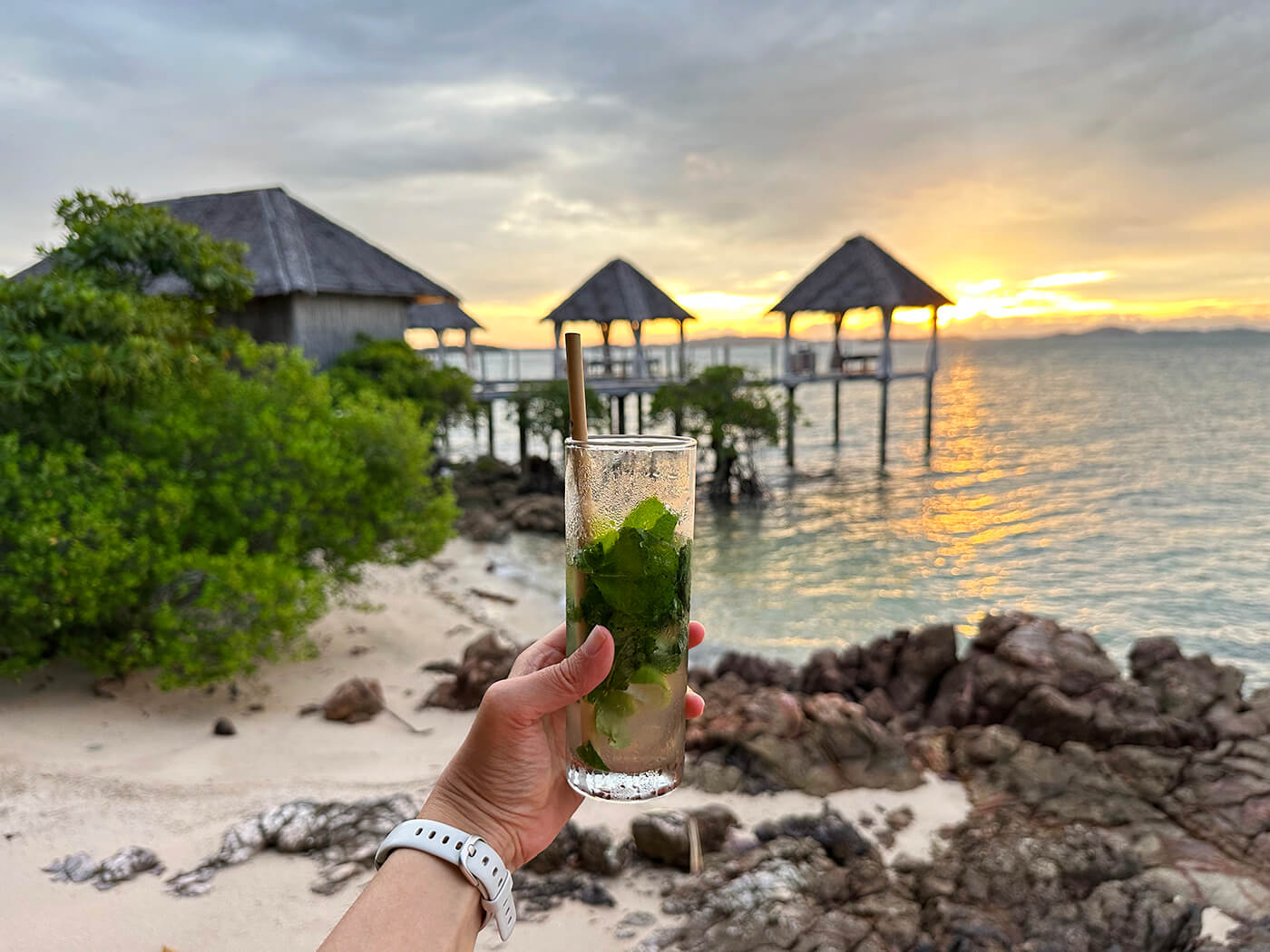
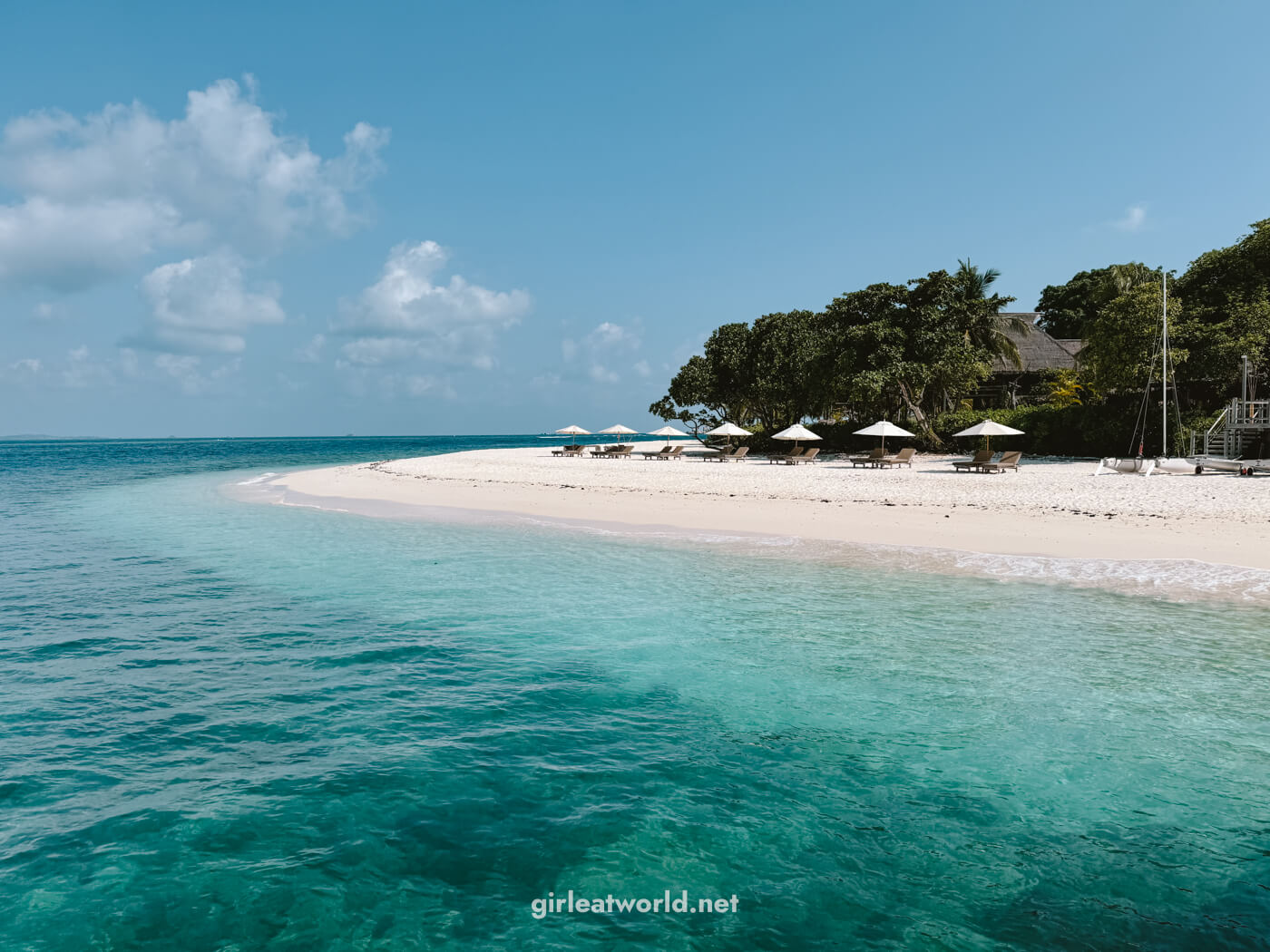

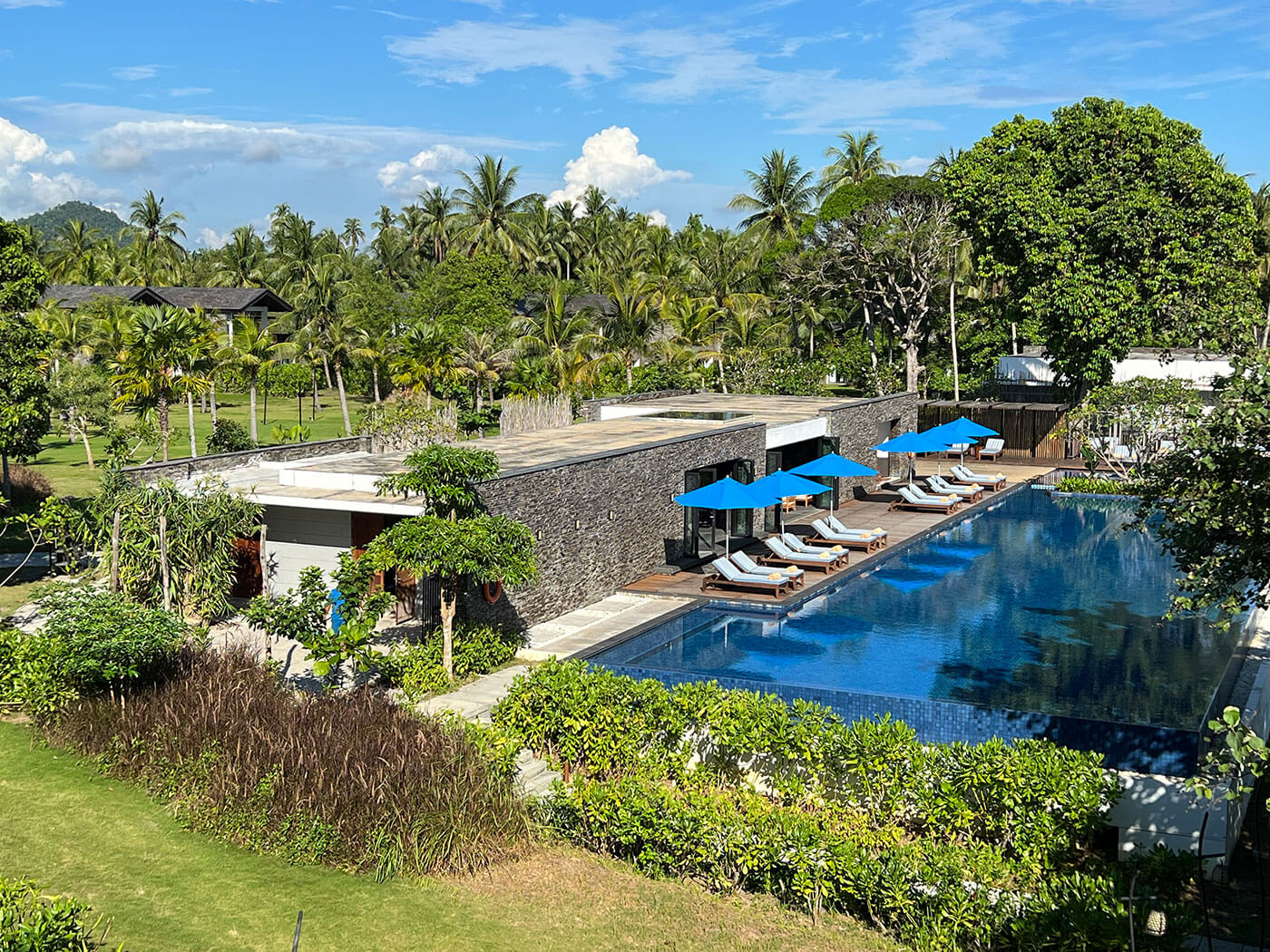
Annual Events in Singapore
Aside from all of the above that I have mentioned, here are some notable annual events in Singapore that might enhance or interfere with your time in Singapore:
- Chinese New Year (Usually in February) – This is one of the major holidays in Singapore. While it means Chinatown will be nicely decorated, I would avoid visiting Singapore on CNY itself, as it is widely celebrated and many things will be closed.
- Ramadan (Usually in March or April) – Ramadan is a holy month when Muslims celebrate by fasting, and they break their fast around sunset. It’s a great time to visit the Kampong Glam area. Check the Singapore Events Calendar here.
- Singapore National Day (9 August) – In the weeks leading up to Singapore’s National day, there will be plenty of fireworks shows on Saturdays and Sundays, which is a practice for the big show on the 9th of August. Great time to be at the Singapore waterfront area!
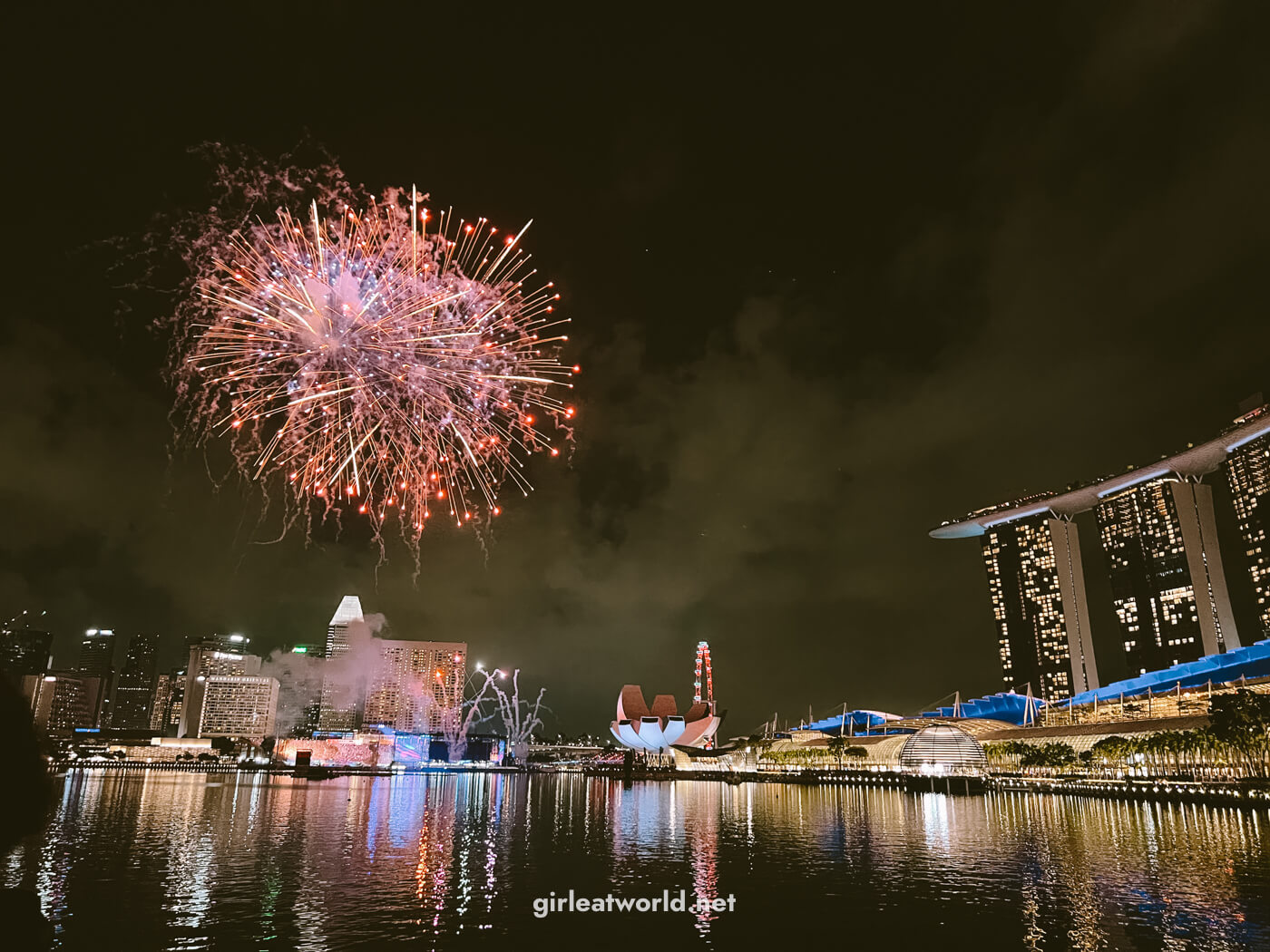

- Deepavali (Usually in November) – This is a great time to visit Little India. Throughout the month of October and November, you’ll find the neighborhood even more lively and brightly decorated. Check the Singapore Events Calendar here.
- Singapore F1 Grand Prix – Usually held on the last week of September. If you’re a fan of F1, it’s a great time to visit and watch the race in person (we have a 100% safety car record). But if you’re not an F1 fan, avoid coming to Singapore during the race week as it increases the price of hotels by multiples!
Phew, that was such a long post! I hope you find it useful, and as usual please feel free to comment below for any questions.
Until next time ✨

Hi Melissa,
Loved this article, very detailed and thorough!
Thank you very much for this useful article. Let’s travel to Singapore for 5 nights in January 2025. We will continue our trip to Penag Island.
Thank you from Hungary, Éva